Trek Fuel EX 2023 Review | A bigger, musclier & hugely adaptable trail bike
The not-so-minor details.
2023 Trek Fuel EX
https://www.trekbikes.com
$4,999 AUD - $8,999 AUD
- Sturdy, flex-free chassis - Superb geometry with adjustable head angle - Efficient & comfortable climbing performance - Coil shock, big fork & mullet compatibility - Mechanic-friendly frame furnishings - Internal storage
- Frame is on the heavy side - Rear shock tune lacks small-bump suppleness - Rattly rear thru-axle lever

Wil reviews the Trek Fuel EX 2023
Having undergone a ground-up redesign for 2023, the Trek Fuel EX has entered its burliest and biggest travel form yet. This latest model represents the 6th generation of Trek’s popular mid-travel trail bike, with the original having debuted all the way back in 2005. Trail riding has evolved a lot since then, and the new Fuel EX aims to keep up with that evolution by incorporating almost every mod-con you can think of.
Of course it’s big news whenever Trek releases a new Fuel EX, and given how important this bike is for the US brand, we were curious to see how the raft of updates would play out on the trail. We had a bit of an idea, having thoroughly enjoyed riding the electrified Trek Fuel EXe over the past few months. Would the muscle-powered version deliver the same good vibes? And how would it compare to the previous models that have given us so many fond riding memories over the years? We’ve been putting the Trek Fuel EX 2023 to the test to find out!
Watch our video review of the Trek Fuel EX 2023:
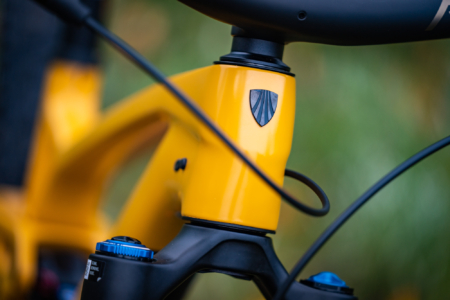
Along with the downtube storage, generous frame armour and size-specific chainstays, the Fuel EX appears to pack in almost everything you could possibly want in a modern trail bike.
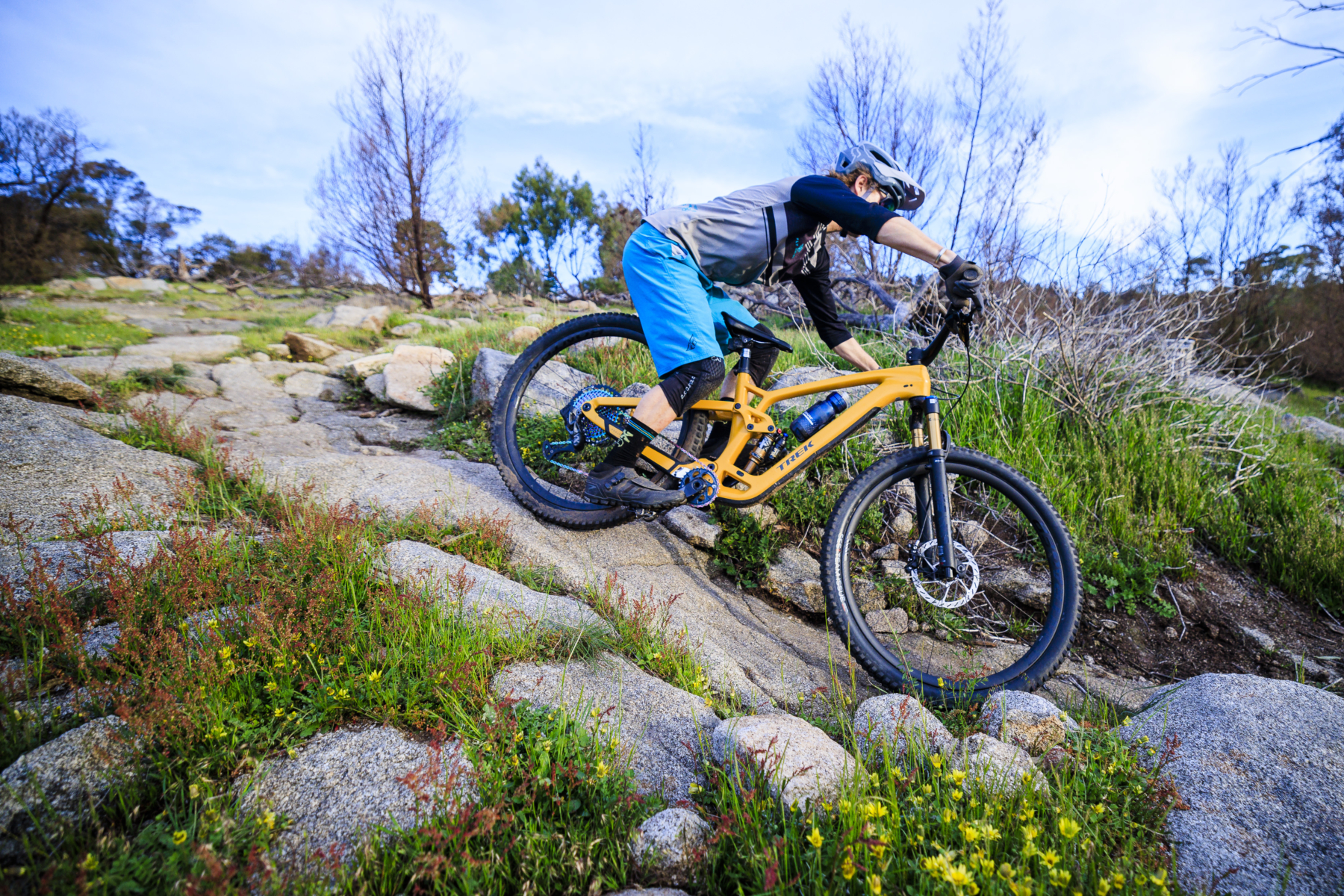
An overview of the Trek Fuel EX 2023
For 2023, the Trek Fuel EX is built around an entirely new frame that’s produced in carbon and alloy variants. Suspension travel has increased by 10mm at both ends, with the new Fuel EX now sporting a 150mm fork and 140mm of rear travel via the ABP four-bar suspension design.
It’s worth noting that the frame will handle a 160mm travel fork, and thanks to the two-position Mino Link, it can also be run as a mullet. Borrowed from the Session downhill bike, there’s a two-position flip chip at the lower shock mount that offers linear and progressive settings. The latter option is what makes the new Fuel EX coil shock compatible.
On top of that, Trek will be offering aftermarket headset cups to steepen or slacken the head angle by a degree. Along with the downtube storage, generous frame armour and size-specific chainstays, the Fuel EX appears to pack in almost everything you could possibly want in a modern trail bike. It’s certainly an appealing package on paper, and one that’s ready to take on contemporaries like the Specialized Stumpjumper , Merida One-Forty , Canyon Spectral and Giant Trance X .
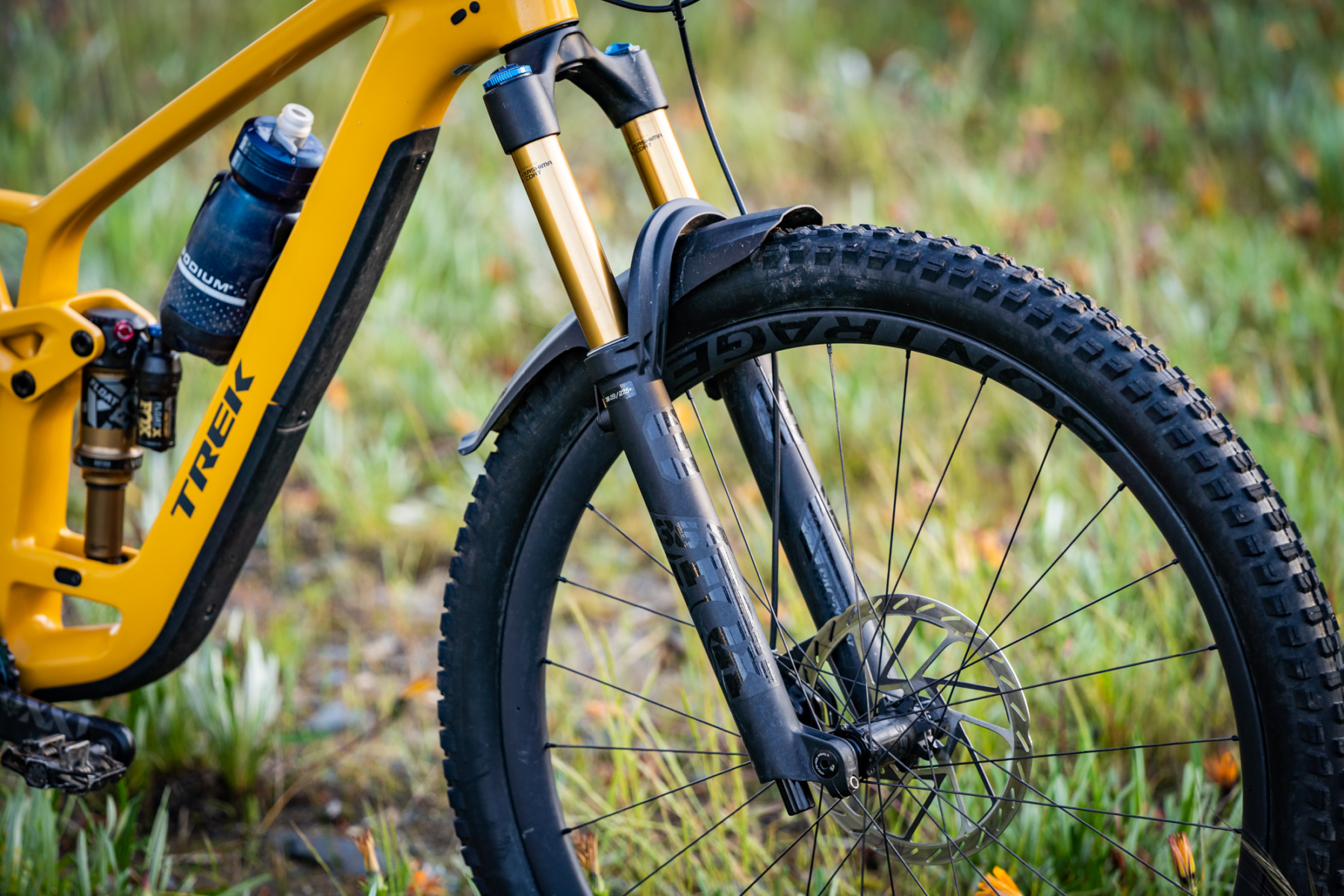
Trek Fuel EX price & specs
There are a number of different models available in the Trek Fuel EX 2023 lineup, though availability will vary depending on where you are in the world.
In Australia, prices currently range from $4,999 AUD for the Fuel EX 7, and go up to $8,999 AUD for the Fuel EX 9.8 XT model. The cheapest option is actually the Fuel EX 5, though that model carries over the previous generation frame. For a closer look at the specs, prices and all the new details, check out our Trek Fuel EX 2023 overview article for more.
Here we’ll be diving into our experience of testing the Trek Fuel EX 9.9 XX1 AXS model, which will be available in Australia in limited quantities through the custom Project One bike builder. It’s a media bike that was provided to us by Trek, and of course it comes dripping with lots of gold, carbon and wireless bits. However, as usual with our reviews, we won’t be going into detail about the Gucci-level spec. Instead, we’ll be concentrating on the important aspects that are shared throughout the Fuel EX lineup; the frame design, suspension performance and its on-trail handling.

2023 Trek Fuel EX 9.9 XX1 AXS
- Frame | OCLV Mountain Carbon Fibre, ABP Suspension Design, 140mm Travel
- Fork | Fox 36, Factory Series, GRIP2 Damper, 44mm Offset, 150mm Travel
- Shock | Fox Float X, Factory Series, 185x55mm
- Wheels | Bontrager Line Pro 30, OCLV Carbon Rims, 29mm Inner Width
- Tyres | Bontrager SE5 Team Issue 2.5in Front & Rear
- Drivetrain | SRAM XX1 Eagle AXS1×12 w/30T Crankset & 10-52T Cassette
- Brakes | SRAM Code RSC 4-Piston
- Bar | Bontrager RSL Integrated, OCLV Carbon, 27.5mm Rise, 820mm Width
- Stem | Bontrager RSL Integrated, OCLV Carbon, 45mm Length
- Seatpost | RockShox Reverb AXS, 34.9mm Diameter, Travel: 100mm (S), 150mm (M-M/L), 170mm (L), 200mm (XL)
- Saddle | Bontrager Arvada, Austentite Rails
- Confirmed Weight | 14.4kg
- RRP | $TBC
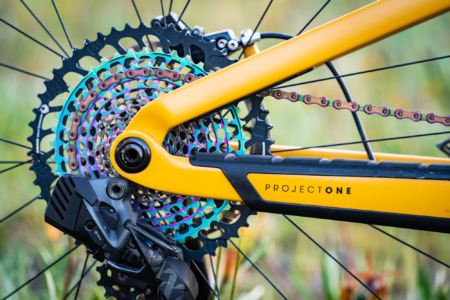
The chassis feels near-bombproof, and combined with the supportive suspension, powerful brakes and high volume rubber, you’re served up plenty of confidence for pushing the front wheel into steep chutes and over technical A-lines.

Trek Fuel EX size & geometry
From X-Small through to XX-Large, the Trek Fuel EX is produced in no fewer than seven different sizes. Seven! Given that many brands only offer four or sometimes even just three frame sizes, that’s impressive.
The two smallest sizes feature 27.5in wheels, while the Medium and above come standard with 29in wheels. The Small is the only option that is available in either wheelsize.
At 175cm tall I’ve been riding a Medium, which features a 450mm reach. Thanks to the use of short seat tubes, a rider of my height could easily upsize to the M/L size to get a longer 470mm reach. Personally, I’ve found the fit of the Medium to be spot-on.
As for geometry, the Fuel EX features a 64.5° head angle and approximately a 77.5° effective seat tube angle in its stock configuration. The rear centre length varies between sizes, going up to 450mm on the largest frame. On the Medium I’ve been riding, the rear centre is a compact 435mm.
Coming off the Fuel EXe, I found it easy to settle into the Fuel EX. The only modification I needed to perform was to chop the comically wide handlebars from 820mm down to a more reasonable 780mm.
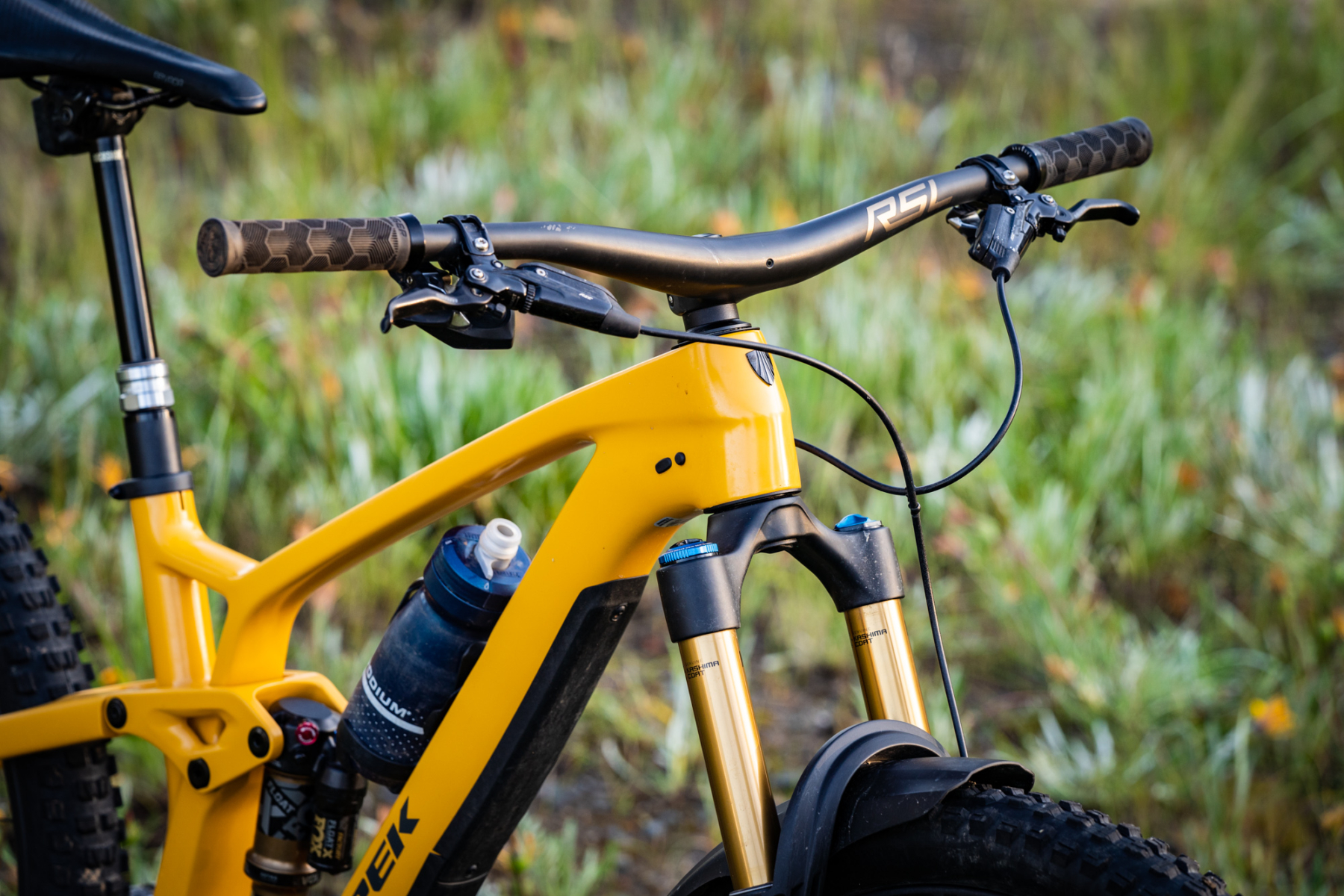
Suspension & tyre setup
Getting the Fuel EX set up is made easy thanks to Trek’s detailed online suspension calculator . Input the bike model and your riding weight, and out spits suggested air pressure and rebound settings for both the fork and shock. It even suggests tyre pressures, giving you a good place to start before hitting the trail. When brands like Canyon struggle to provide any recommendations at all, Trek should be commended for helping riders to get the most out of their bike.
For my 68kg riding weight, Trek suggests setting up the Fox 36 fork slightly softer and slower than usual. Recommended rear shock sag is 29%, and the calculator’s suggestion of 158psi got me to exactly that figure. Initially I set the rebound at 6/15 clicks as recommended, but while everything felt quite balanced front to back, the suspension was a little sluggish and duller than I wanted. Speeding up the rebound by a couple of clicks in both the fork and shock helped to make the whole bike feel a bit more lively, while improving small-bump reactivity.
Although the Bontrager SE5 tyres feature reinforced Core Strength casings, I still fitted a CushCore Pro insert to provide some additional pinch-flat protection and insurance for the carbon rims. Tyre pressures were set as per Trek’s recommendations with 20psi in the front and 22psi in the rear.
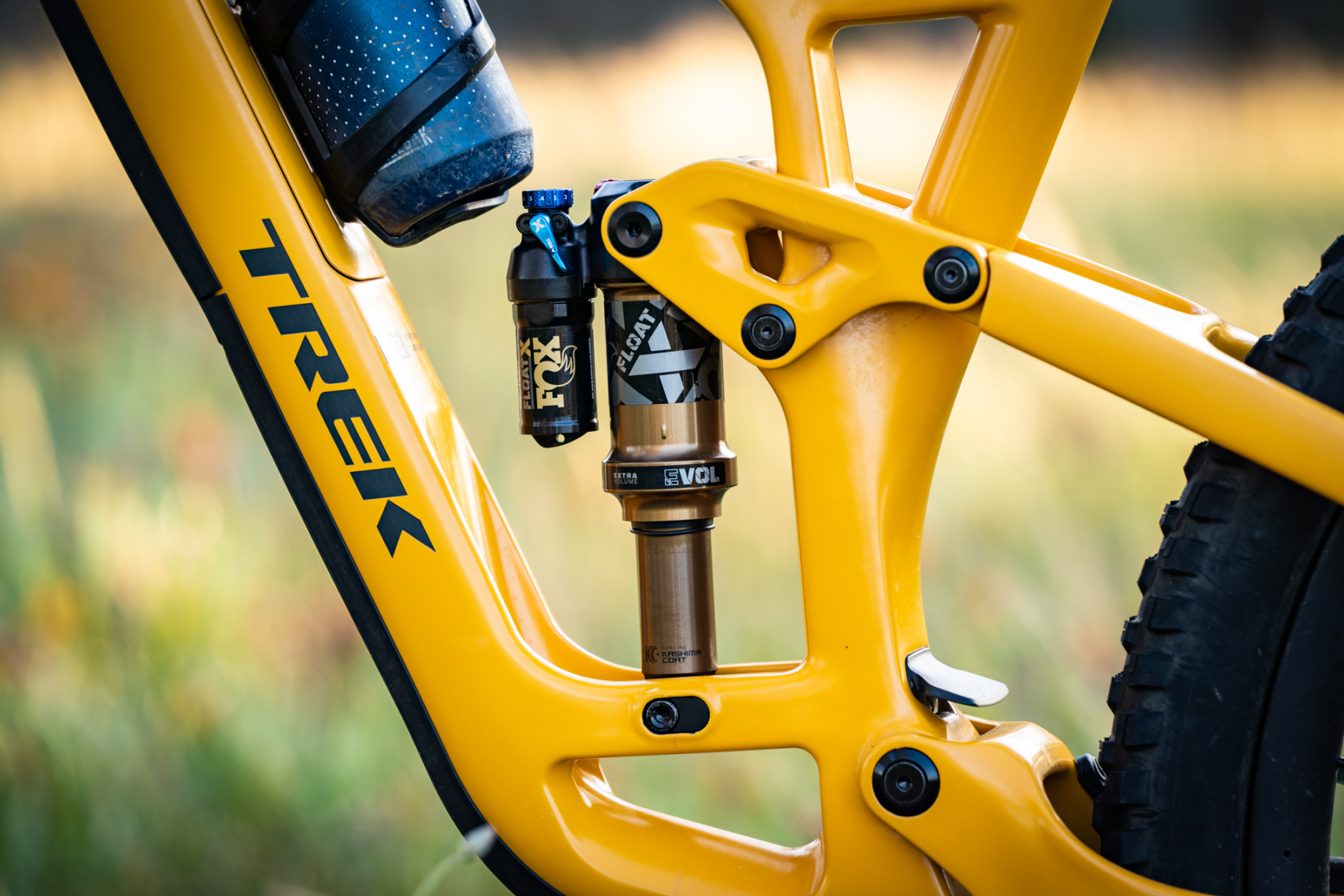
Trek Fuel EX weight
Confirmed weight for our Trek Fuel EX test bike is 14.4kg. That’s with the tyres set up tubeless, but without the CushCore insert or pedals.
It’s on the heavier side for a high-end carbon trail bike, though the 2.5in tyres, stocky carbon wheels and AXS components aren’t exactly the lightest going. Of course weights do vary throughout the Fuel EX lineup depending on the spec, and you can see the weights for all the different models in our range overview .
A contributing factor to the overall weight is the new frame, which has gained almost 700g over its predecessor. Trek claims the carbon frame weighs 3.4kg with the rear shock, making it a bit of a porker alongside some of the competition;
- Scott Genius HMX Carbon: 2,249g
- Specialized Stumpjumper Carbon: 2,280g
- Giant Trance X Advanced Pro 29: 2,498g
- Specialized Stumpjumper EVO Carbon: 2,750g
- Canyon Spectral CF: 3,047g
- Trek Fuel EX Carbon: 3,400g
The new alloy Fuel EX frame is heavier again, coming in at a hefty 4.6kg with shock.
Of course weight isn’t everything, and it’s unsurprising that the new frame has gotten heavier given how much longer and slacker it is. Still, for those who are especially concerned by grams, there are certainly lighter options on the market.
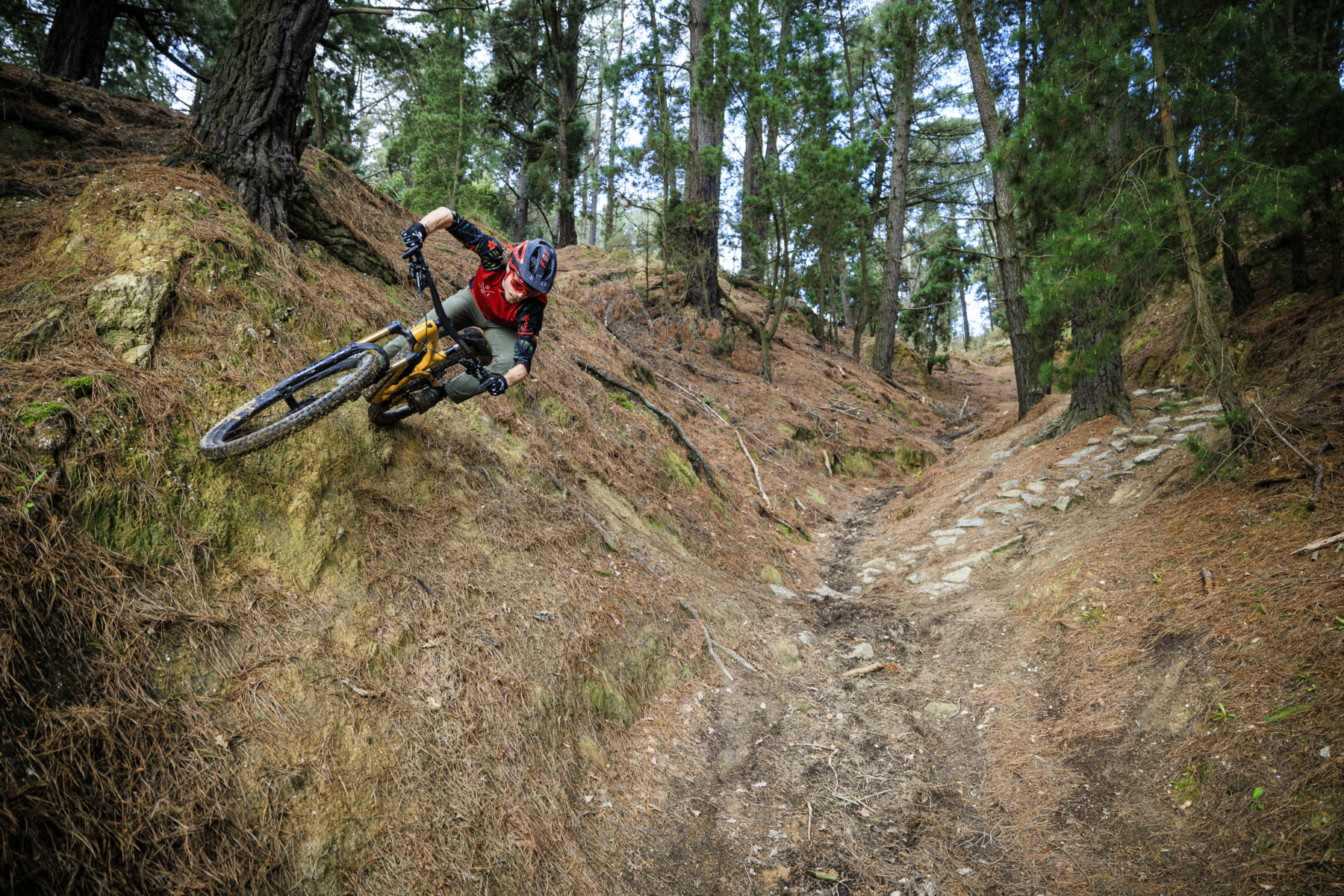
What do we dig about the Trek Fuel EX 2023?
With its added heft and updated geometry, the Trek Fuel EX 2023 is no doubt the burliest iteration yet. The chassis feels near-bombproof, and combined with the supportive suspension, powerful brakes and high volume rubber, you’re served up plenty of confidence for pushing the front wheel into steep chutes and over technical A-lines.
Indeed it’s massively capable for a 140mm travel bike, with the slack 64.5° head angle and roomy wheelbase giving it a purposeful stance on the trail. The geometry is superb, with welcome updates that have brought the Fuel EX right up to speed.
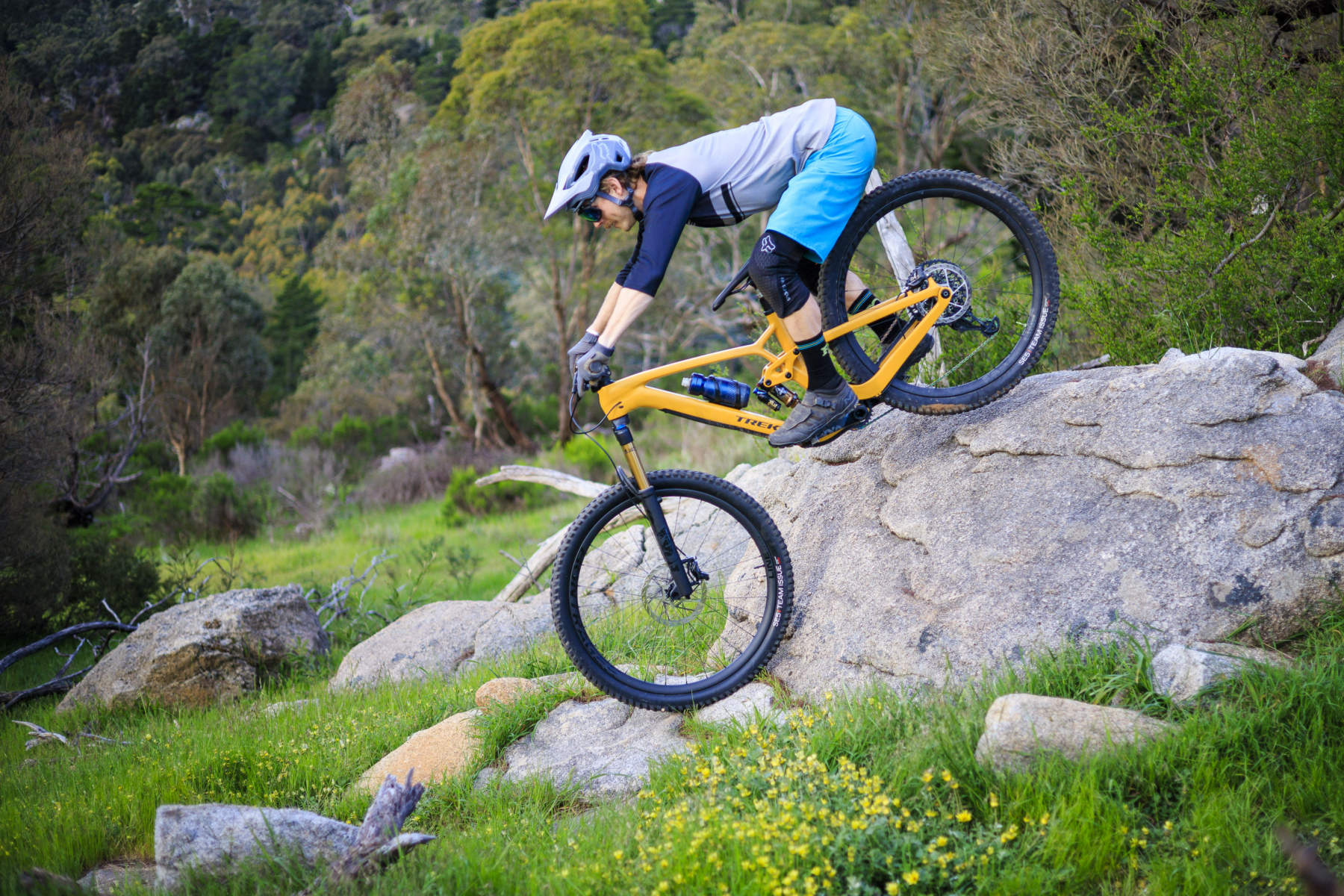
The steeper seat angle is particularly noticeable over the old bike, providing a much improved seated position on steep climbs. Pedalling efficiency has also levelled up. Trek has lifted the main pivot above the chainring to increase anti-squat, which helps to reduce pedal-induced bobbing. The Float X shock has a two-position climb switch, but I never once needed to use it while riding off-road since the rear end is so well behaved.
It rips through the turns
Once up to speed on flower singletrack, the taut chassis means the Trek Fuel EX is highly responsive when rounding corners and pushing into berms.
With its boxy downtube, split top tube and the supporting strut for the lower shock mount, the front triangle is heavily braced to resist torsional flex. Along with the wide main pivot and boxy one-piece chainstays, the Fuel EX possesses a strong spine from its shapely head tube to the rear thru-axle. The muscly frame effectively translates handling inputs while resisting lateral deflection through the turns.
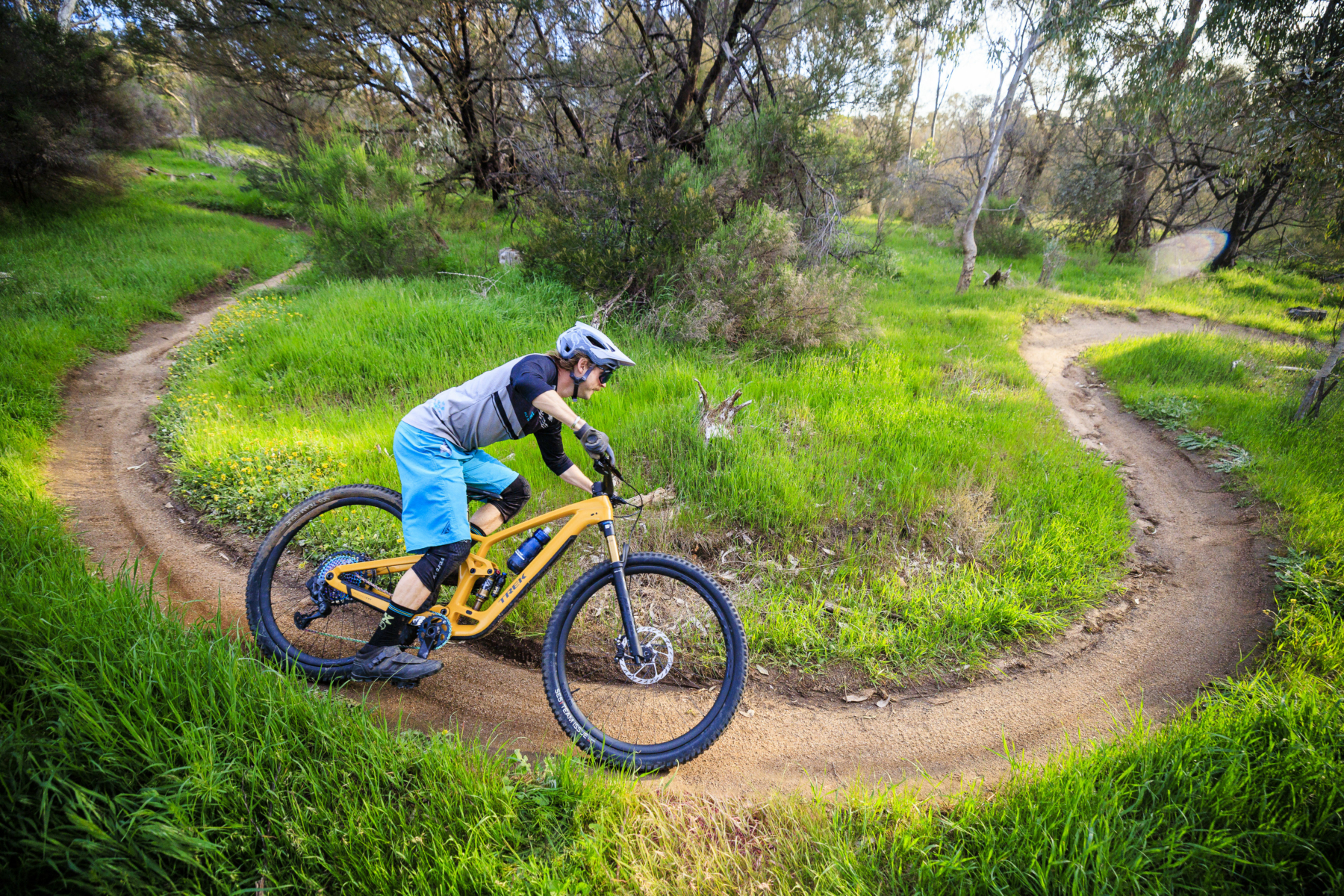
Likewise, the short rear end and generous 38mm BB drop are fantastic when threading your way through twisty sections of trail, keeping you connected to the terrain and contributing to the playful ride quality. The low-hanging BB did mean I caught the pedals occasionally, so those who frequent off-piste terrain and technical climbs will want to consider flipping the Mino Link into the High position to indulge in an extra 7mm of pedal clearance.
Otherwise the riding position and weight distribution are totally sorted. The handling is approachable, and the Fuel EX doesn’t demand a whole lot from you as the rider. Compared to the old bike it does need a more concerted lean when entering tighter corners, though this is a part of the natural evolution of modern trail bike geometry. Even if you’re coming off a 5-year old bike, you’ll only need a few rides to get accustomed to the Fuel EX’s steering behaviour.
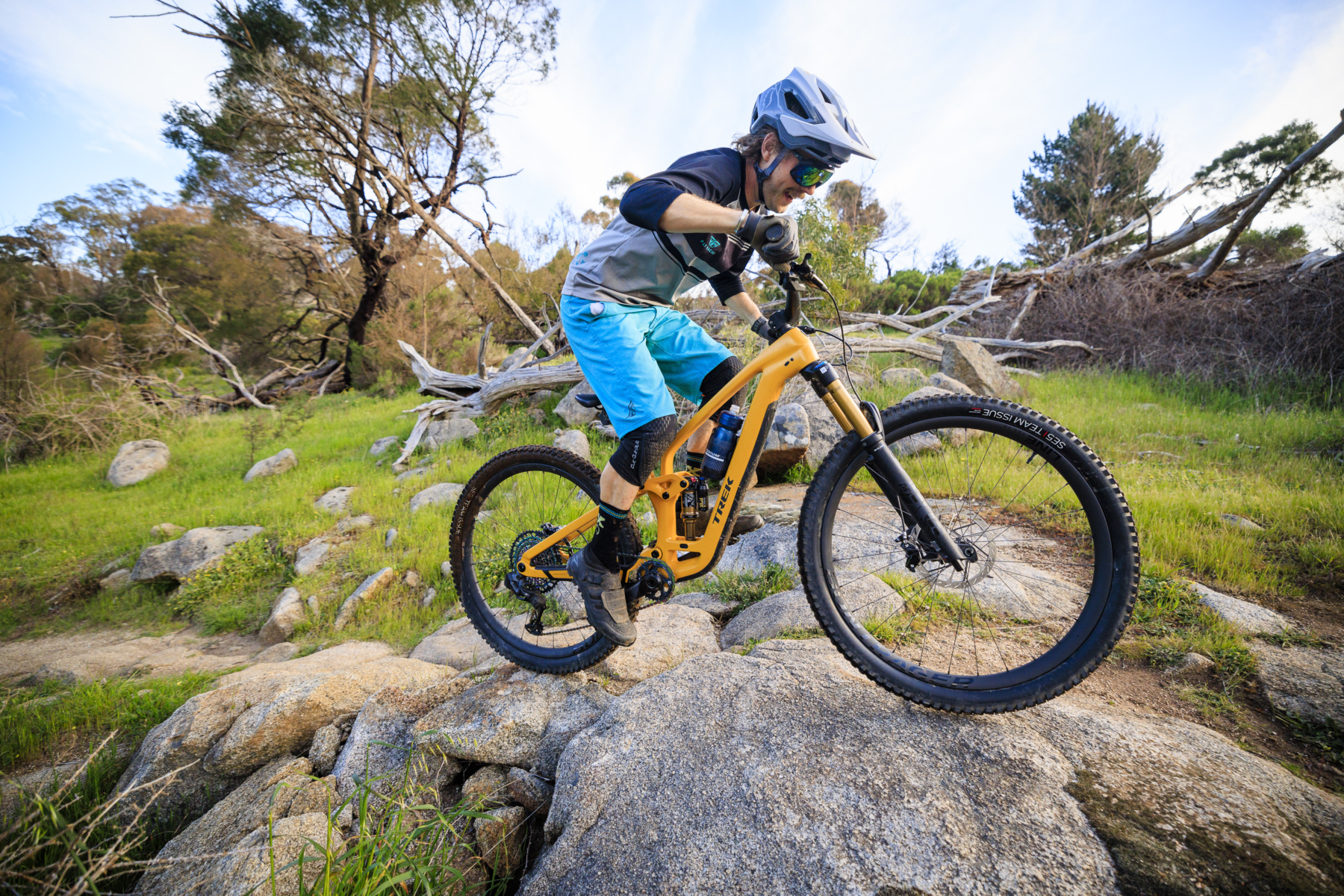
Trail-tweakable
In addition to the Mino Link, we’ve also been experimenting with the lower shock flip chip on the Trek Fuel EX. Requiring just a single 6mm hex key, it’s a quick adjustment to make trailside, and the change in suspension behaviour is noticeable.
I ended up preferring the ‘Less’ setting, which provides a more linear leverage rate. With the shock set at the recommended sag, this position provides great pedalling support, along with more comfort and activity deeper into the stroke. There’s still a good deal of progression though. Combined with the large bottom-out bumper in the Float X shock, hitting full travel proved to be a well-controlled affair.
One of our fellow testers, who generally spends more time in the air than on the ground, preferred riding in the ‘More’ setting. This increases progression, providing a stronger ramp-up in the latter half of the travel. He also reduced the shock pressure by 5psi to further enhance small-bump compliance, while still being able to enjoy the additional big-hit support. Pedal efficiency isn’t as stable in this setting, but it does mean the Fuel EX takes to jumps like a duck to water, popping off lips enthusiastically and absorbing hard landings with a solid and flex-free touchdown.
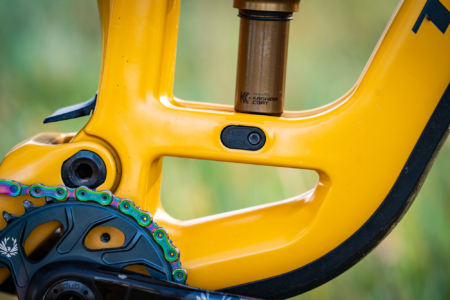
One thing to note on the More/Less flip chip is that while you are altering the progression of the air spring, you’re also affecting the damper too. As well as adjusting air pressure, we found we needed to tweak the rebound and low-speed compression settings between the two positions. It is indeed a useful tuning tool, but it doesn’t dispel the need for air volume spacers entirely.
What does it struggle with?
With the Trek Fuel EX adopting a beefier frame, the added weight is noticeable compared to lighter bikes in this category. That’s compounded by the heavy-duty brakes, stocky wheels and chunky tyres, which mean there’s more inertia to overcome during micro-accelerations on an undulating climb.
For those who are looking for a sharper and sprightlier trail bike to whip through the trees along smoother singletrack, the latest Trek Top Fuel will be a better fit. In comparison, the new Fuel EX is a burlier beast that thrives on steeper and more technical terrain.
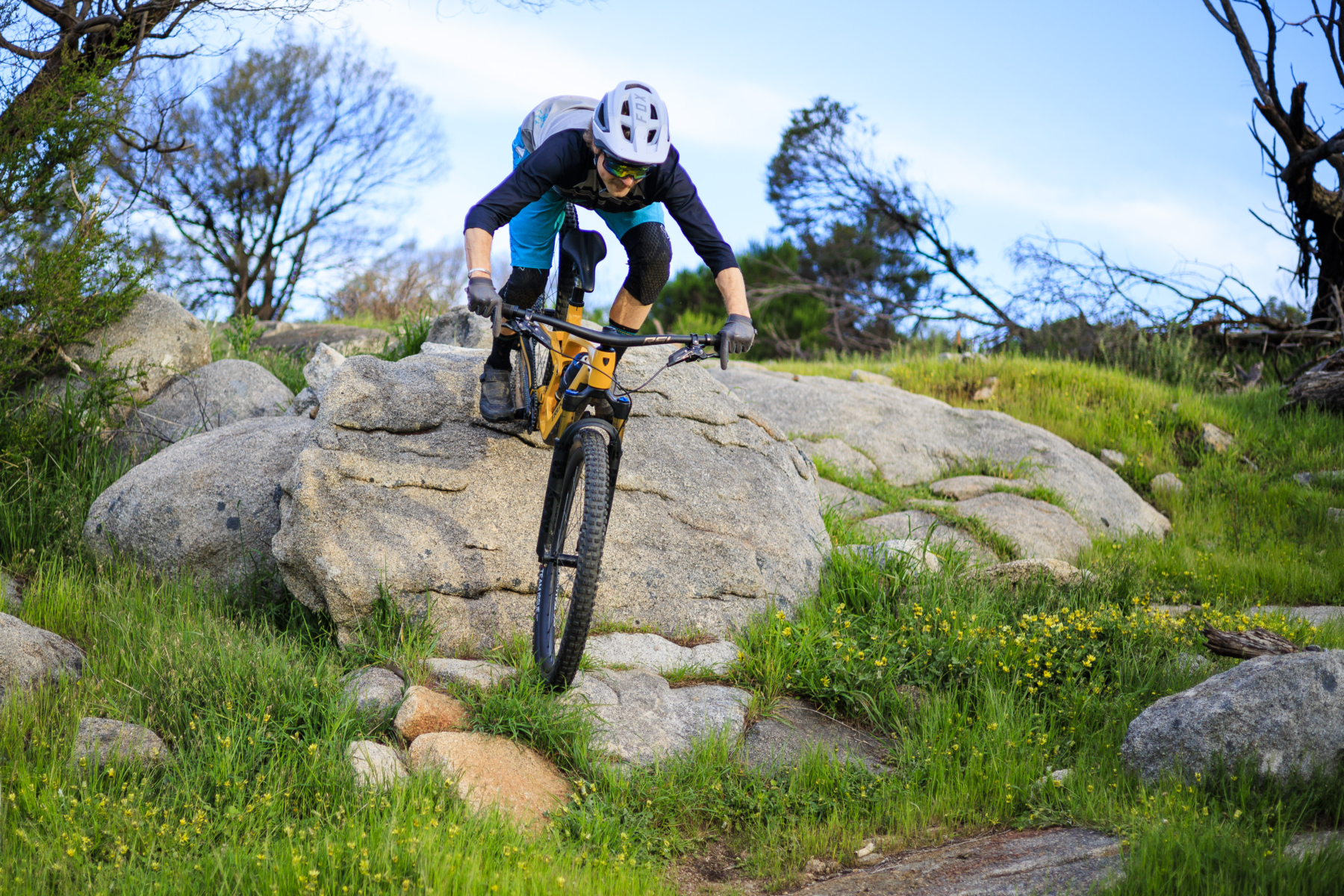
Curiously, it does feel stiffer than the electrified version, the Fuel EXe . Despite both our test bikes featuring carbon frames with a near-identical build kit, I’ve found the Fuel EX to transmit more trail feedback.
Some of this may be due to structural differences, and perhaps the more favourable sprung-to-unsprung mass ratio on the electric version thanks to the added weight of the motor and and battery. Either way, the Fuel EX doesn’t exactly exude off-camber compliance. As a lighter rider on very rocky terrain, I’ve found myself getting knocked around a little more than I would like.
This sensation reminded me of the Canyon Spectral 125 , which proved to be overly stiff and quite uncomfortable at slower riding speeds. The Fuel EX is more compliant overall than the Spectral 125, but it’s still pretty stiff.
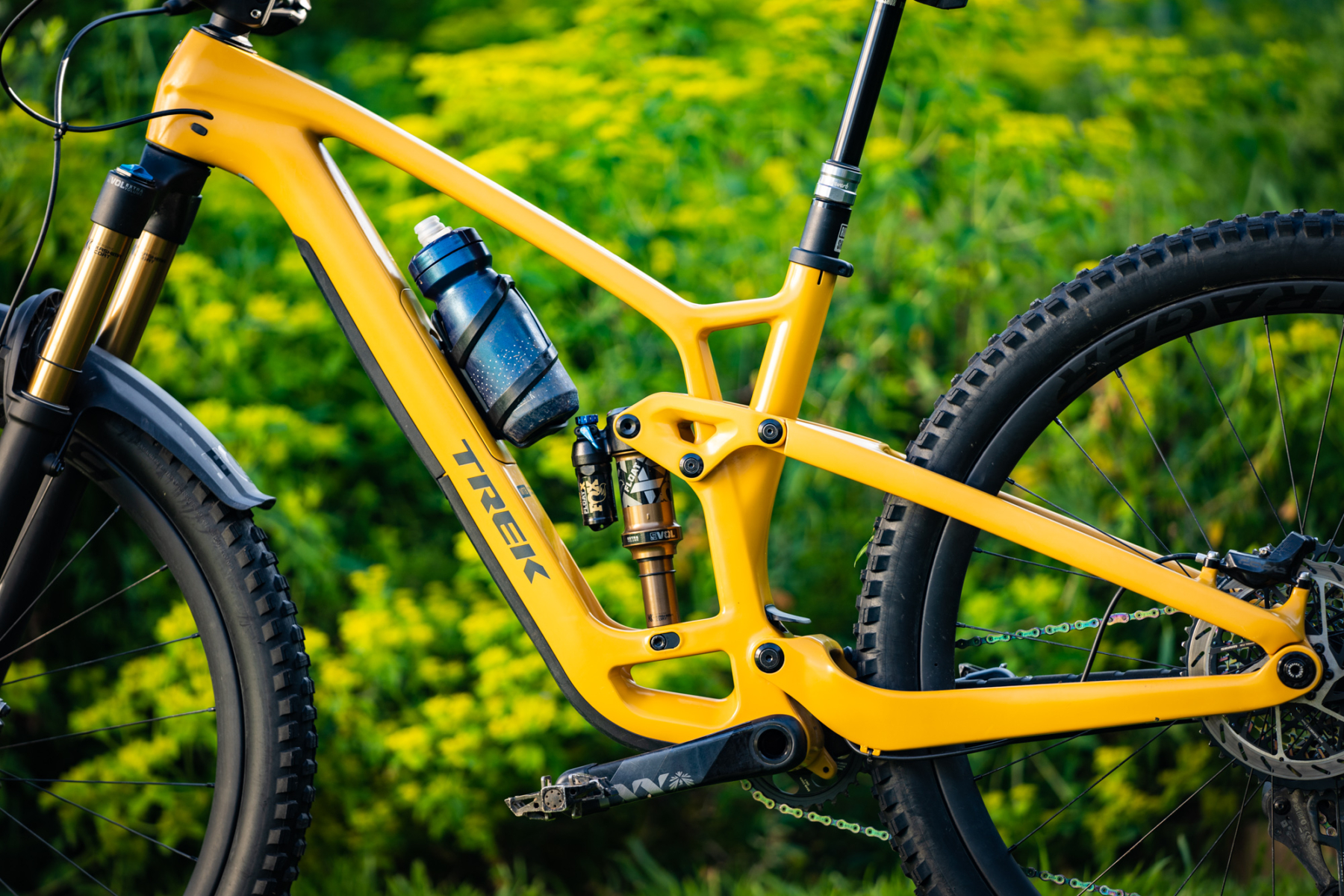
It’s not as supple as Fuel EX models gone by
Contributing to this sensation, the suspension isn’t as plush as previous Fuel EX models, particularly those that featured the Thru Shaft shock. Those bikes did require the rider to make use of the compression lever to provide pedalling support, but it meant that in the open mode the rear end absorbed the terrain like melted butter.
You may have noticed that Trek has been making a conscious move away from proprietary suspension components lately, and that’s coincided with building bikes that offer more neutral pedalling performance. The increased anti-squat is one part of the equation on the new Fuel EX, and the other part is the custom-tuned Float X, which Trek has configured with a digressive compression tune on the main piston. This creates a decent low-speed threshold, which provides a level of support that sits between the Open and Medium settings on the previous RE:aktiv damper.

The result is that you can ride with the shock fully open, and the Fuel EX still offers great stability under pedalling inputs, with no real need to activate the climb switch. If you detest remote lockouts and having to flip shock levers all the time, this will certainly be appealing.
The downside is that the suspension isn’t as supple over smaller rubble and at slower speeds. Along with the stiff chassis and carbon wheels, more of those vibrations are transmitted to the rider. As such, careful consideration with tyre pressure is needed to maximise grip and comfort.
Because there is more support however, the Fuel EX gives your feet a stronger platform to push off of, with greater feedback during high-load scenarios. Indeed the harder and faster you push, the better the Fuel EX responds. In that sense, it’s less of a comfy cruiser like its predecessors, and more of a mid-travel bruiser that loves to ride hard and fast.
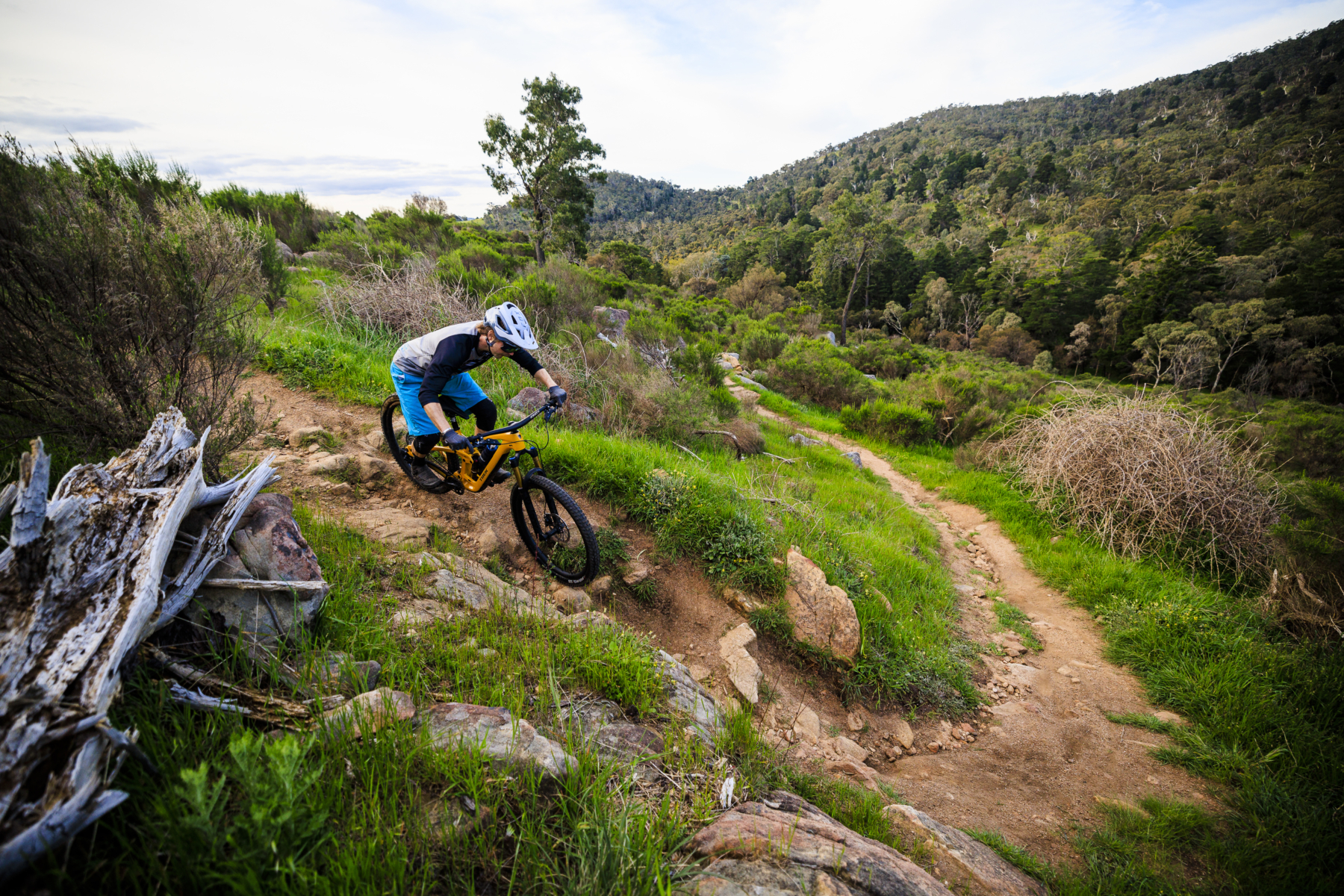
Component highs & lows
As a complete bike, the Trek Fuel EX is a solid package that puts the emphasis on capability over light weight.
The Bontrager SE5 tyres are a good example, coming in at 1,100g each on our workshop scales. They roll reasonably well given their weight and size, and we’ve found them to provide consistent grip on rocky, hard-packed soil, which will suit most Aussie trail riders. The tread is a little shallow though, and the compound isn’t the softest, which sees them struggling to latch on when the conditions are wet and loose. We’d prefer something a little stickier and toothier up front, like a Maxxis Minion DHR II with 3C MaxxGrip rubber.
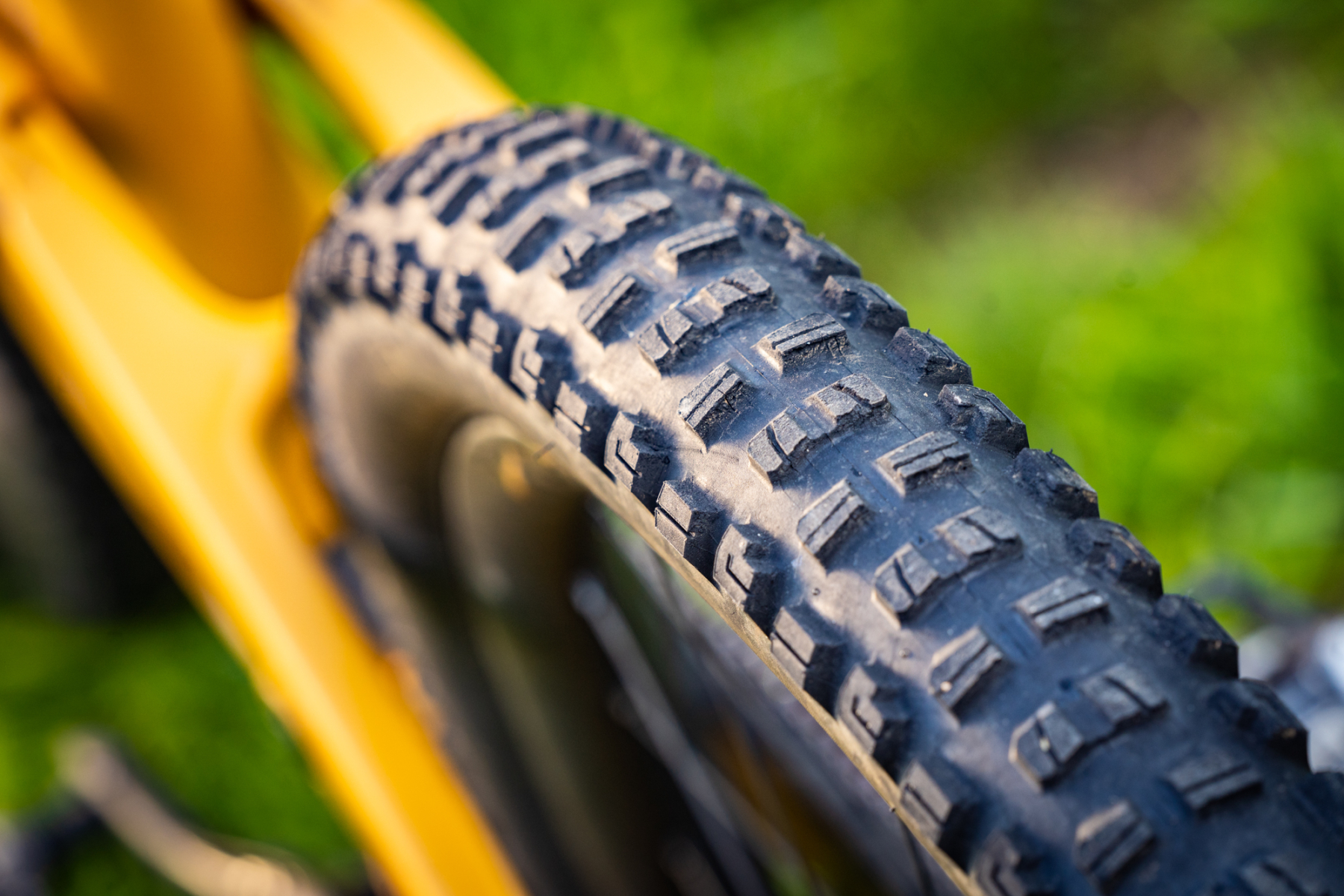
While the carbon Bontrager Line Pro rims are quite stiff, they have proven to be plenty tough. We’ve tested five of these wheelsets across various bikes over the past few years and we’ve not encountered a single issue. The y also come with a two-year crash replacement guarantee, which is great insurance given the hell that you can put this bike through. Furthermore, the frame itself comes with a lifetime warranty for the original owner.
There’s still plenty of real-world protection though, including a generous two-piece armour plate that bolts to the underside of the downtube. There’s also a metal chain-suck guard behind the chainring, and a full-coverage chainstay protector. Along with the fully guided internal cable routing, the Fuel EX is an impressively quiet and rattle-free bike on the trail. Well, except for the rear thru-axle lever, which I removed after the first ride.
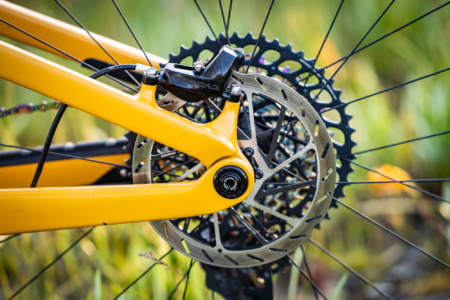
Otherwise the finishing details are all sound. The adoption of a bigger 34.9mm seat tube diameter is welcome, as it accommodates a stiffer and stronger dropper post, particularly for the larger sizes. Mechanics will be happy to see a threaded BB shell, and we’re fans of the downtube storage. The trap door has none of the play that we encountered on the last Fuel EX we tested, with a tight fit and a nice lever action.
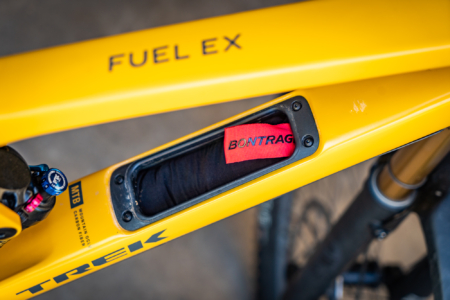
It’s certainly a high quality chassis, and many riders are likely to appreciate the in-built versatility. We’re looking forward to trying out the adjustable head angle once the aftermarket cups become available, and we’d also be keen to try out the Fuel EX with a coil shock. Setting it up as a mullet will be more straightforward, especially as you only need to buy an air spring to extend the Fox 36 up to 160mm of travel.
Trek Fuel EX vs Specialized Stumpjumper
Alongside the Trek Fuel EX, the Specialized Stumpjumper is one of the most popular and well-known trail bikes in this category. In terms of travel and the overall build, the Fuel EX sits right in between the regular Stumpjumper and the Stumpjumper EVO. However, it’s the regular Stumpy that I’ve been spending the most time on lately, both in its stock configuration and with a burlier mullet setup .

Compared to the Fuel EX, the Stumpjumper has a touch less travel with a 140mm fork and 130mm at the rear. It also uses a simpler suspension layout, with the carbon models employing a flex-stay design. Combined with its slimmer tube profiles, the carbon Stumpjumper frame is very light. Specialized claims it weighs just 2.28kg including the shock, which is over a kilo lighter than a carbon Fuel EX.
This theme extends to the Stumpjumper’s build kit, with Specialized electing for the skinnier Fox 34 over the 36. Along with an in-line shock, lighter brakes, wheels and tyres, there’s a considerable difference in the overall bike weight. For example, the Stumpjumper Pro we tested weighed 12.84kg.
While the geometry is pretty similar between the two bikes, the Specialized Stumpjumper rides much lighter on the trail compared to the Trek Fuel EX. It offers more comfort, with its lithe chassis and smooth suspension performance providing better compliance over rough terrain. It’s quite sporty and sprightly, though its active suspension design does need taming on the climbs by making use of the rear shock’s compression lever.
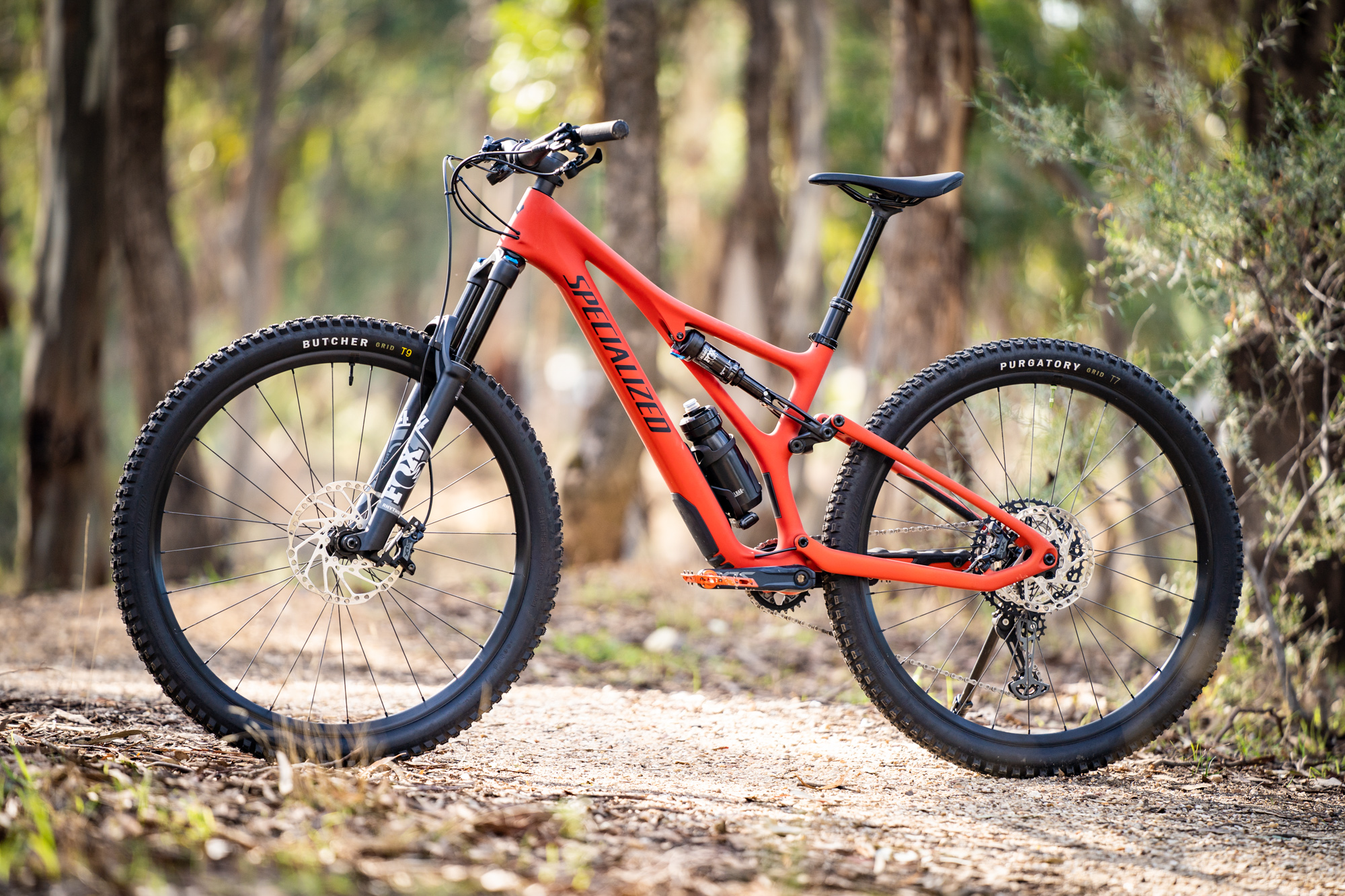
In comparison, the Fuel EX is more naturally efficient. It’s also more planted at speed, with its sturdy chassis and supportive suspension providing better big-hit capability. It feels more like a short travel enduro bike, which will suit heavier and harder riders.
Both bikes will handle a longer fork and can be set up as a mullet, though Specialized makes a specific link for the Stumpjumper to maintain the stock geometry. There is greater versatility in the Fuel EX chassis, with the option to adjust the head angle and fit a coil shock.
As for value, the Fuel EX offers a more appealing spec package. A Stumpjumper Expert sells for $9,800 AUD and comes with a Fox 34 GRIP2 fork, SRAM G2 brakes, an X01 drivetrain, alloy wheels and handlebars. In comparison, an equivalent Fuel EX 9.8 XT sells for $800 AUD less. It gets a simpler GRIP damper for its Fox 36 fork, though it does feature a piggyback shock, a Shimano XT groupset, a carbon one-piece RSL cockpit and carbon wheels with that 2-year crash replacement guarantee.
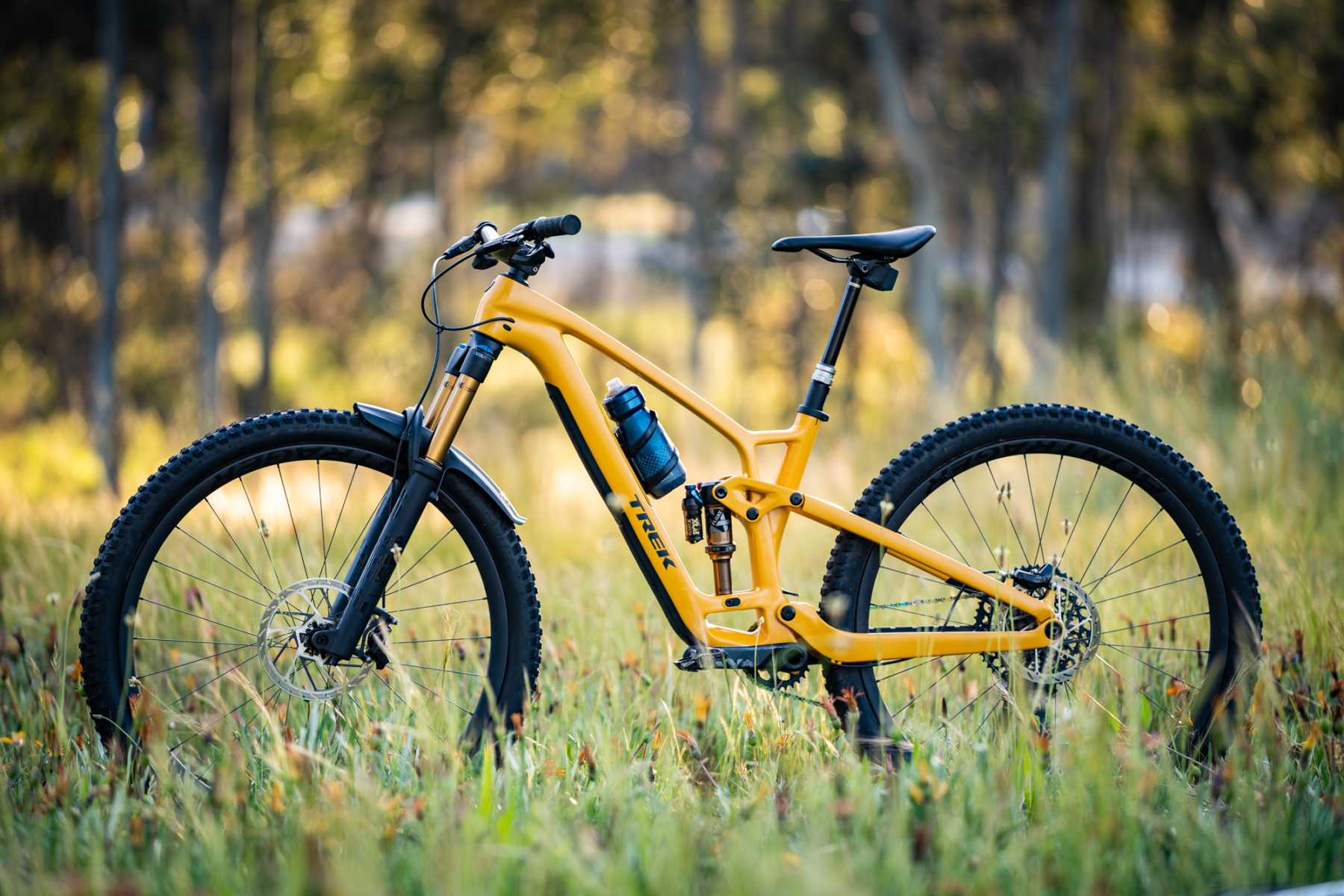
Flow’s Verdict
For many trail riders, the Trek Fuel EX 2023 is likely to tick just about every box on your new bike wish list. It’s as up to date as it gets, featuring loads of adjustability, internal storage and a nuanced approach to its size-specific geometry. Along with the increased travel and muscly frame, it offers greater stability and big-hit control over its predecessor, while still being a fun and involving bike to ride on modern flow trails.
It is a bit of a chonker though, so those who are looking for a lightweight and speedy trail bike may be better served by the latest Top Fuel .
The stiff chassis and supportive suspension also mean the Fuel EX tends to transmit more feedback, making it less comfortable to ride over rocky terrain. We’d be curious to try out a lighter shock tune to see how much of a difference that would make to the overall ride quality, but in its stock form the Fuel EX isn’t as plush as competitors like the Giant Trance X and Specialized Stumpjumper .
It is impressively efficient though, and the stable suspension gives you a load of support when you’re really giving it the beans on the descents. In this sense, the Fuel EX is closer in feel and performance to an enduro bike. You’ll still want to look towards the Slash if you’re serious about racing, but outside of the tape the Fuel EX will handle just about everything a modern trail centre or bikepark could throw at it. And for those who really want to up the limits, the adaptable chassis can easily be configured for some pretty aggressive riding.
Indeed for those who are chasing maximum capability without going to a big, spongy enduro bike, the Fuel EX is a mighty appealing option.
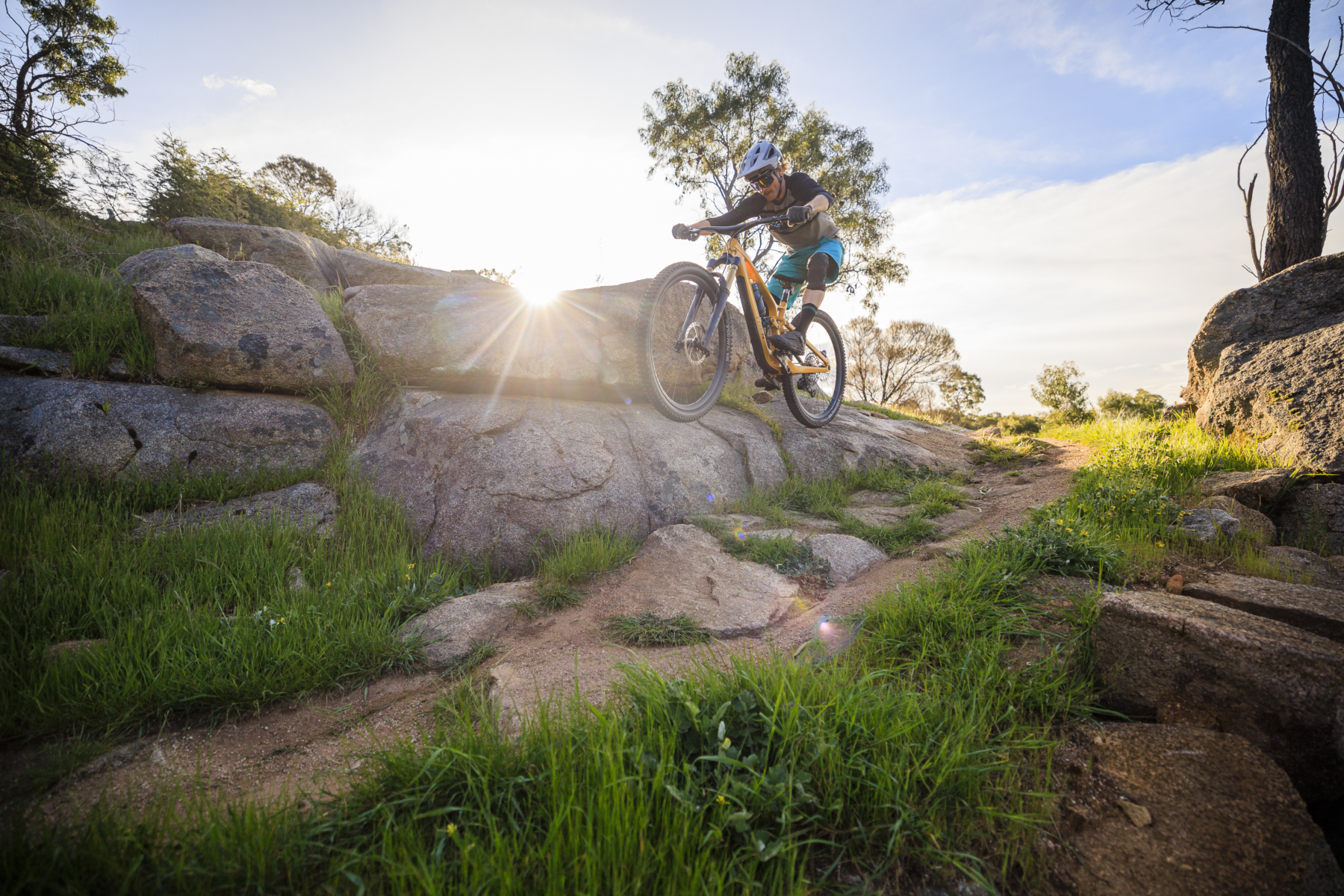
You’ll still want to look towards the Slash if you’re serious about racing, but outside of the tape the Fuel EX will handle just about everything a modern trail centre or bikepark could throw at it.

- Submit for Review
- Terms & Conditions
Enjoy reading this?
Get similar articles delivered directly to your inbox
2023 Trek Fuel EX
Wheel Size: XS: 27.5’’; Small: 27.5’’ and 29’’ options; M through XXL: 29’’; all 29’’ frames also mullet compatible with a 160mm-travel fork
Travel: 140 mm rear / 150 mm front
Material: Aluminum and carbon fiber versions available
Sizes Offered: XS–XXL
- Aluminum frame w/ Fox Float X Performance: $2,600
- Carbon frame w/ Fox Float X Factory: $3,900
- Complete bikes $3,700 to $10,750
Blister’s Measured Weight: 33.1 lb / 15.0 kg (Fuel EX 9.8 XT, size Large)
Reviewer: 6′, 170 lb / 183 cm, 77.1 kg
Test Location: Western Washington
Test Duration: 4 months
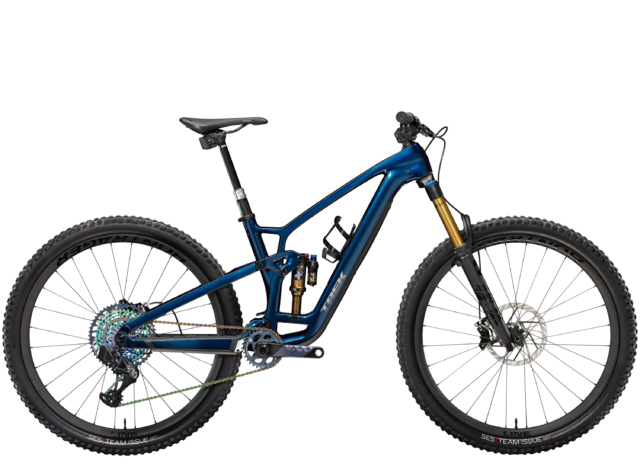
Trek’s Fuel EX has long been a popular all-round Trail bike, but the new version looks like a major departure from the bike it replaced, with more suspension travel, dramatically longer / slacker geometry, a ton of new adjustability, and a substantial cosmetic overhaul to go with it. There’s a lot to cover here, so let’s get right into it:
The sixth-generation Fuel EX includes loads of updates, starting with the wild amount of adjustability on offer. The prior-generation bike had a flip chip to toggle between two geometry settings, which the new bike retains, but it adds an optional offset headset that changes the headtube angle by +/- 1.0°, as well as a second flip chip that varies the amount of progression from the rear suspension — more on all that in a minute.
The overall aesthetic design of the frame has also been overhauled to match the new Fuel EXe lightweight e-bike, but Trek’s longstanding ABP suspension design carries over (now producing 140 mm of rear wheel travel, up by 10 mm from the outgoing bike), as does the option for aluminum and carbon frame construction. No matter which frame material you opt for, you get a storage compartment in the downtube, internal cable routing across the board, ample rubber guards on the seatstay, chainstay, and downtube, and a threaded bottom bracket shell. ISCG-05 tabs are also featured, and tire clearance is stated at 2.5’’. Trek’s sometimes-irritating Knock Block headset is nowhere to be found on the new Fuel EX. All sizes can fit a water bottle inside the front triangle, though the size of the bottle is limited on the smaller frame sizes.
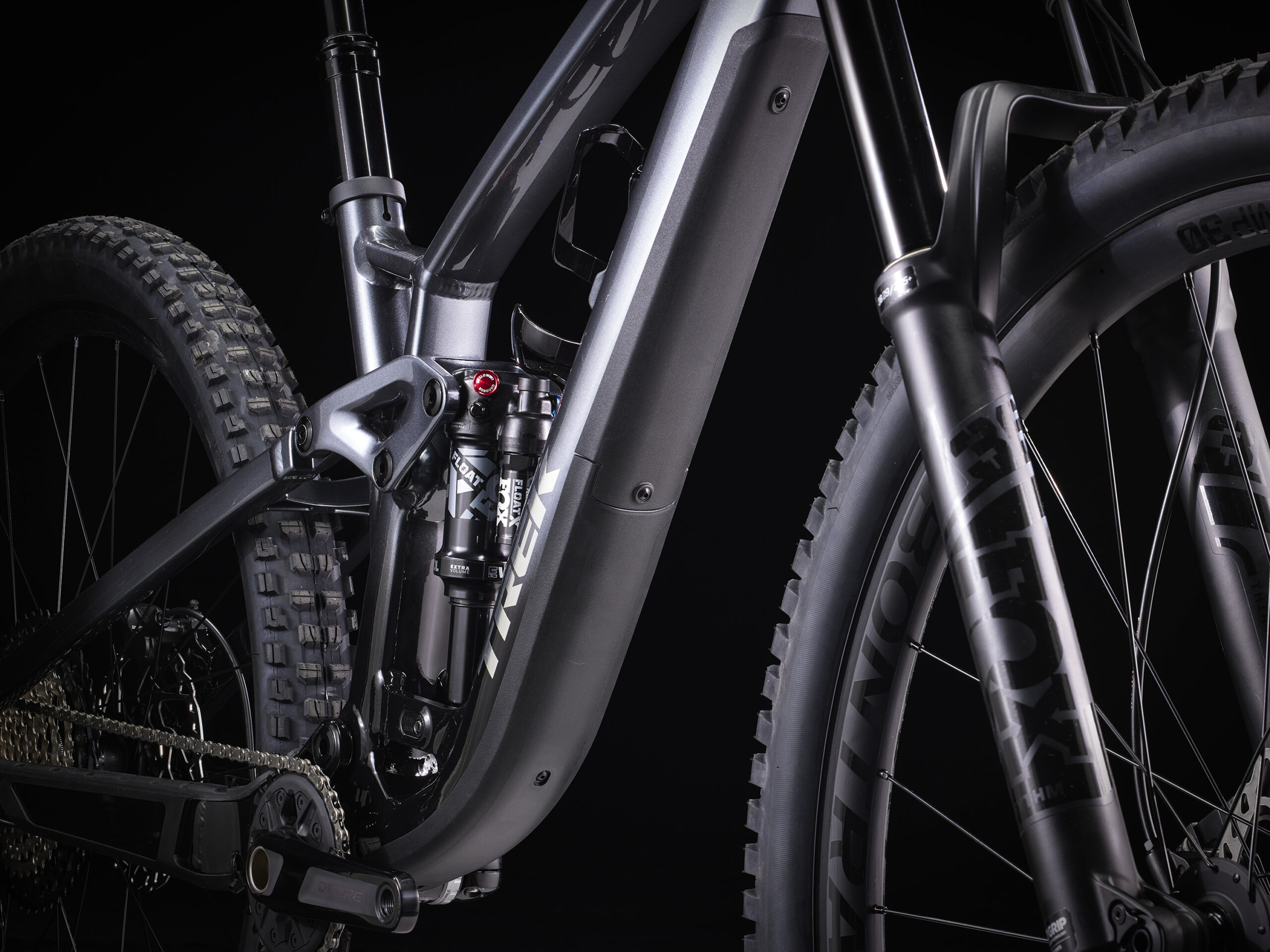
The Fuel EX now has a second flip chip that toggles between two different levels of rear suspension progression, which Trek amusingly simply labels “Less” and “More.” It’s essentially the same system that they introduced on the Session last year. In the “More” progression setting, the leverage curve goes from about 2.9:1 to 2.3:1 in a nearly straight line (~21% total progression); the “Less” setting drops the starting leverage ratio to about 2.75:1 (for ~16% overall progression), and the curve flattens off somewhat near bottom-out.
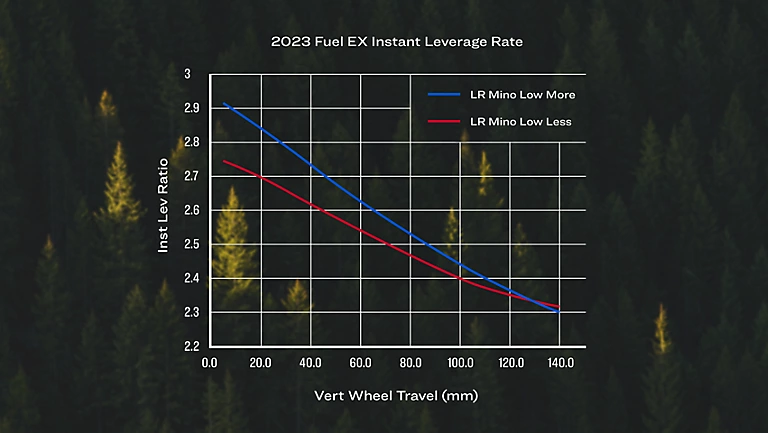
Fit & Geometry
Again, there’s a lot going on here — the new Fuel EX has a huge amount of geometry adjustability between the geometry flip chip (Trek calls it a “Mino Link”), optional offset headset (sold separately), and the option to run the bike with a 27.5’’ rear wheel for a mullet setup (on frame versions designed around a 29’’ front wheel). We’ll get to the full geometry charts in a minute, but to break down the highlights:
- Trek offers the Fuel EX in a whopping seven sizes (XS through XXL, with an “ML” size snuck in the middle). The XS frame is 27.5’’ only, the size Small comes in options for 27.5’’ or 29’’ wheels (each of which gets a dedicated frame — no converting back and forth), and sizes Medium and up are 29ers. All the 29er frames can be run as a mullet with the flip chip in the “High” position (and Trek recommends bumping up to a 160mm-travel fork to raise the bottom bracket a little).
- The headtube angle is 64.5° in what is probably the default position for most people (headset in the neutral position, flip chip in low, which is how Trek will ship the Fuel EX) but you can set it anywhere from 63.5° to 66° depending on how you mix and match the settings with the stock wheel size.
- Going to a mullet configuration on the 29er frames slackens things out to 63.9° in the neutral headset position; you can vary that by one degree in either direction with the offset headset.
- Reach ranges from 400 to 545 mm; all sizes get a 70.8° actual seat tube angle, with the effective measurement starting at over 78° on the smaller sizes and dropping off to 76° by the XXL.
- Chainstay length is 435 mm on the XS through M frames (irrespective of wheel size), 440 mm on the ML and L, and 445 mm on the XL and XXL.
Got all that? The geo chart for the “default” option (stock wheel size, headset in “neutral”, Mino Link in “low”) is below, and you can check out all the other configurations on Trek’s website.

Trek offers the Fuel EX in seven complete builds, and as a frame-only in both aluminum and carbon fiber — a welcome and increasingly-rare option these days. As per usual for Trek, all builds with a non-decimal number feature aluminum frames, while the “9.X” builds are carbon fiber.
[Trek is also continuing to offer the Fuel EX 5 with the prior-generation frame as the most entry-level offering in the range but here we’re covering the builds that are offered on the new sixth-generation frame.]
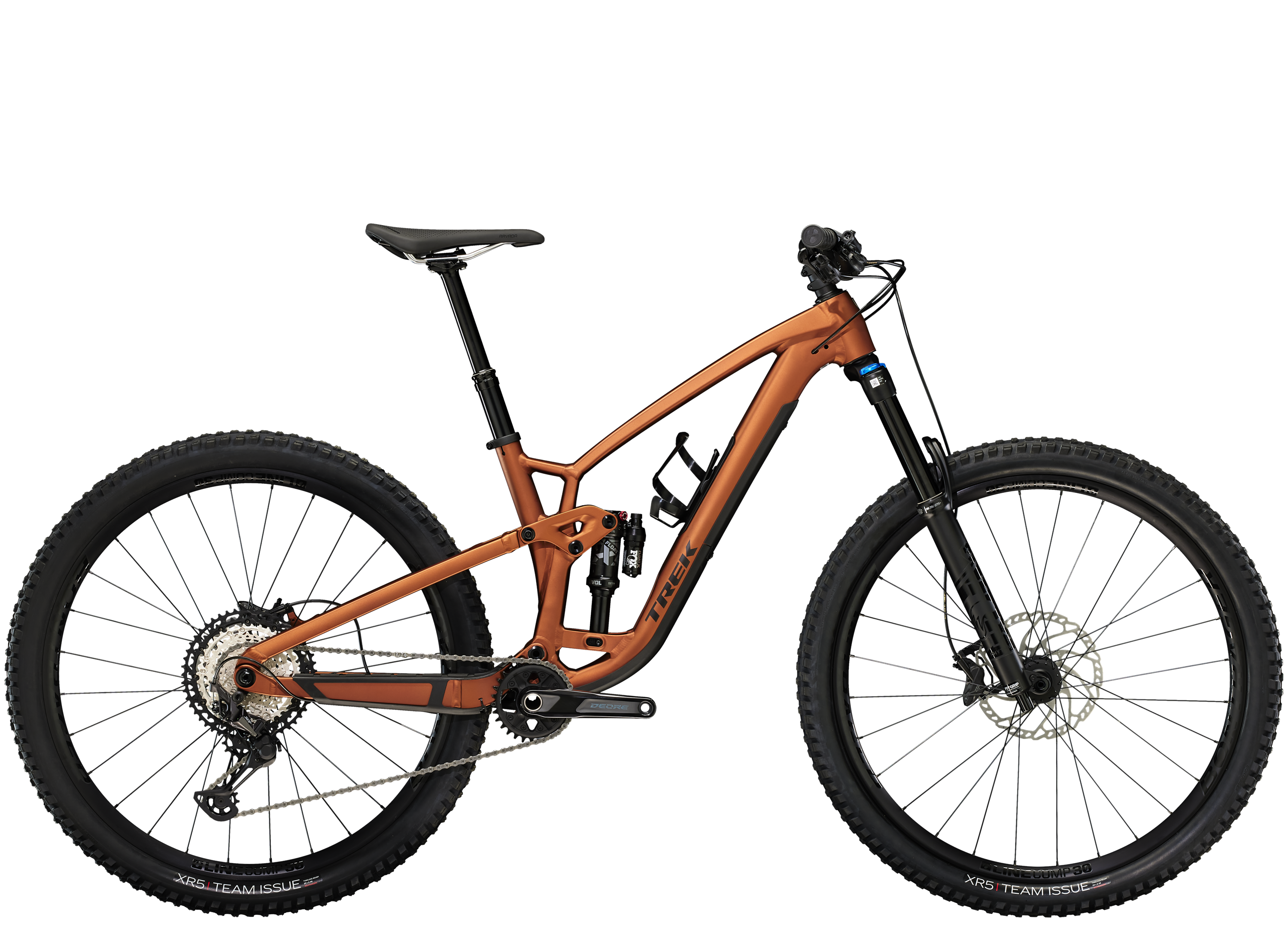
- Fork: RockShox 35 Gold RL
- Shock: Fox Float DPS Performance
- Drivetrain: Shimano SLX shifter, XT derailleur, Deore cassette
- Crank: Shimano Deore
- Brakes: Shimano MT4100 4-piston
- Wheels: Bontrager Line Comp 30
- Dropper Post: TransX
- Fork: Fox 36 Rhythm
- Shock: Fox Float X Performance
- Drivetrain: Shimano XT
- Brakes: Shimano M6100 lever / M6120 4-piston caliper
- Drivetrain: Shimano SLX w/ XT rear derailleur
- Brakes: Shimano M6120 4-piston
- Fork: Fox 36 Performance
- Crank: Shimano XT
- Brakes: Shimano XT 4-piston
- Wheels: Bontrager Line Elite 30 Carbon
- Dropper Post: Bontrager Line Elite
- Drivetrain: SRAM GX AXS
- Crank: SRAM GX
- Brakes: SRAM Code R
- Fork: Fox 36 Factory
- Shock: Fox Float X Factory
- Drivetrain: Shimano XTR
- Crank: e*thirteen TRS Carbon
- Brakes: Shimano XTR 4-piston
- Wheels: Bontrager Line Pro 30 Carbon
- Drivetrain: SRAM XX1 AXS
- Crank: SRAM XX1
- Brakes: SRAM Code RSC
- Dropper Post: RockShox Reverb AXS
Some Questions / Things We’re Curious About
(1) The old Fuel EX was looking a bit dated, geometry-wise, but that’s not the case with the new one, at all. So how does it stack up to a lot of the other good mid-travel Trail bikes we’ve been on recently, including the Santa Cruz Hightower, Guerrilla Gravity Smash, and Commencal Meta TR?
(2) And how does the wild adjustability of the new Fuel EX pan out on trail? Does it feel like a coherent total package across the range of options, or does it start to get a little quirky at the fringes?
FULL REVIEW
Trek has historically been a little on the conservative side when it comes to the geometry and design of their Trail bikes, so when the new sixth-generation Fuel EX launched last year, it came as a surprise — a 140mm-travel Trail bike that could go as slack as a 63.5° headtube angle, with wild new design language, and a ton of adjustability. Now having spent much of the winter and early spring on the new Fuel EX, it’s indeed quite adaptable and well-rounded — and a bike that we think could work really, really well for a lot of folks.
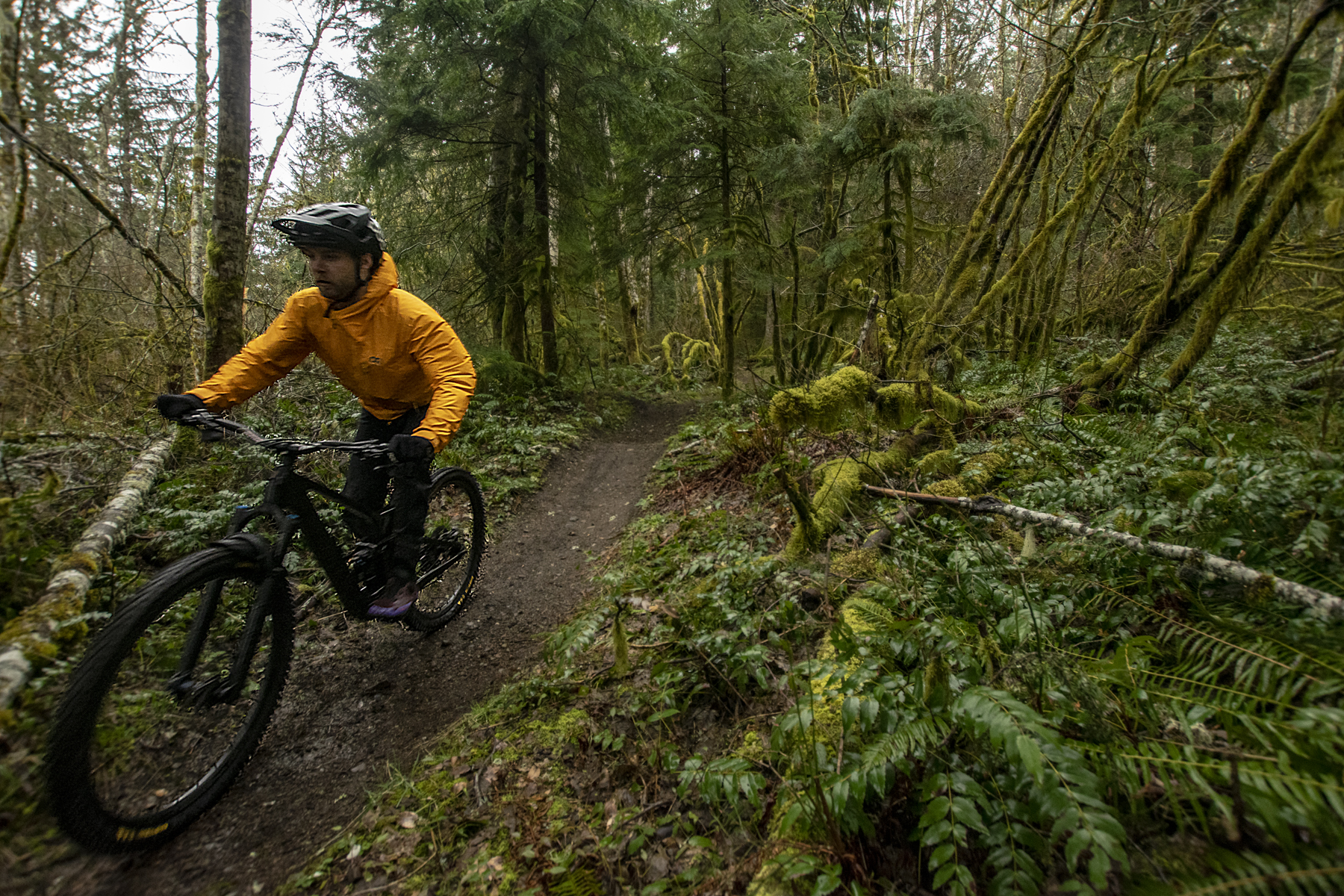
Fit & Sizing
Trek offers the Fuel EX in seven sizes — XS through XXL, plus an “ML” in the middle — but despite the huge size range and relatively tight steps between sizes (particularly around the middle of the range), Trek’s recommended sizing puts me (6’ / 183 cm tall) squarely on a Large frame, with no overlap onto the ML or XL sizes. And at least for my preferences and proportions, that was definitely the right call. I had an easy time getting comfortable on the Large Fuel EX — and with reach, stack, and effective top tube numbers that are all in my typically preferred range, that wasn’t a surprise.
Interestingly, Trek also lists a recommended inseam range on their sizing chart, and despite being at the bottom end of the range (at 33’’) for the Large frame, I had way more than enough room to swap in a 200 mm dropper post in place of the 170 mm one that came stock. Trek does put a 200 mm post on the XL and XXL frames, and I’m sympathetic to the idea that it’s arguably better to err on the side of shorter (so that you don’t have folks who need to swap the post to be able to ride their desired frame size — it’s easier to live with a shorter-than-ideal one than one that’s too tall, for sure). But I wanted a 200 mm post, and I bet a lot of folks on the Large frame will feel similarly.
The Fuel EX’s massive geometry adjustability is much more focused on handling and ride characteristics than fit, and my overall take on fit and sizing didn’t really change much across the range of options (which I’ll cover in a lot more detail below). There are, of course, changes to the reach, stack, and effective top tube as you tweak things via the Fuel EX’s built-in geo adjustments, but they weren’t dramatic enough to change my assessment of the overall fit. The one slight caveat there is the stack height — the Fuel EX’s is a little on the shorter side, and the high flip chip and/or slacker headset settings both reduce it a little more. It wasn’t so short as to cause me real problems getting the fit sorted out, but I did need to swap in a higher-rise bar to help out, particularly in those lower-stack-height configurations to get things high enough — but as I’ll explain below, I wasn’t a fan of the stock bar and stem anyway, rise considerations notwithstanding.
A lot of Trek’s Trail / Enduro bikes in recent years — including the prior-generation Fuel EX — have skewed more toward the compliant, grippy end of the spectrum at the expense of some efficiency and snappiness under power. The new Fuel EX flips that around. It’s quite an efficient, quick-feeling bike under power, but does a notably good job of keeping a solid chunk of the ultra-planted, grippy nature of the earlier iteration — and again, that’s despite the new Fuel EX gaining 10 mm of travel at both ends.
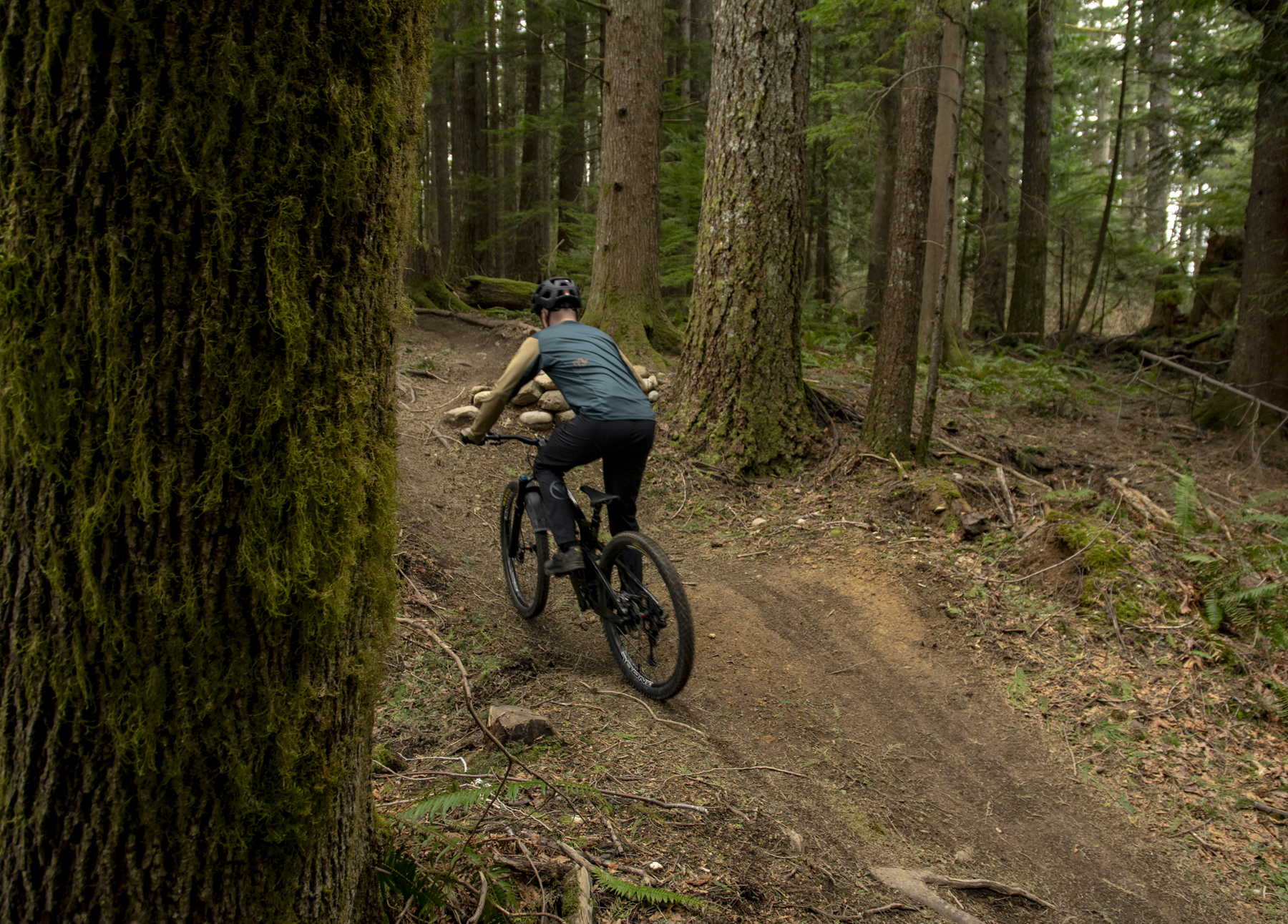
That’s not to say that the Fuel EX is way off the end of the spectrum in terms of efficiency or anything like that, but I’d put it a solid notch above average for a 140mm-Travel trail bike, and it pulls that off while still being entirely respectable when it comes to grip and compliance under power. It’s a really nice recipe for a well-rounded, versatile bike, and while folks who specifically loved the ultra-plush feeling ride of the earlier Fuel EX might feel like the new one has lost a little bit of the magic, I think the new Fuel EX’s suspension performance under power feels more coherent for the bike’s intended use and is going to work better for more people.
In terms of low-speed handling and technical climbing prowess, the Fuel EX’s wildly adjustable geometry makes it a lot harder to give a concise single answer as to how it performs. I’m mostly going to focus on the neutral headset setting since that’s how the bike ships, and I think it’s how most folks are going to run the Fuel EX (and for what it’s worth, it’s also how I preferred to run things), but I’ll touch on the geometry settings and how they change things in more detail below.
Anyway, around the middle of the range of geometry settings, the Fuel EX’s low-speed handling feels quite intuitive and easy but biased a little more toward offering a big sweet spot that makes it easy to keep both wheels planted and gripping, at the expense of a bit of agility at really low speeds, especially as compared to the prior-generation Fuel EX. The new one is still a pretty good technical climber and feels a lot easier to just sit on and grind without having to work to keep the front wheel planted on really steep climbs, but also isn’t quite as easy to snake through really tight spots. Running the steeper, higher geometry settings speeds up the low-speed handling and adds to pedal clearance in really chunky sections but, of course, comes with tradeoffs in higher-speed descending performance. Again, more on the various geometry settings below.
But overall, I think the Fuel EX is an excellent climber for a 140mm-travel Trail bike. The pedaling position is well sorted, striking a nice balance between a steep-ish seat tube without going so far down that road as to feel awkward pedaling around on flat ground. The suspension feels efficient first and foremost but still offers good traction for that level of efficiency and pep under power, and its handling at lower speeds is predictable and intuitive. It’s quite good, especially if you’re inclined to favor a slightly more efficient pedaling platform over the most compliant and grippy suspension performance under power, but the Fuel EX is overall well-rounded and should suit a lot of people nicely.
On the way back down, the Fuel EX is, again, a really well-rounded, versatile bike that feels at home on a fairly wide spectrum of trails. Its massive adjustability (more on that later) doesn’t hurt either, but I don’t think that most folks are going to be toggling between different settings all that often — rather, I think they’re more likely to find a preferred combination and stick with it.

But especially in the middle part of the settings range (as I’ll explain more below, I found the low flip chip / neutral headset setting to be my personal favorite), the Fuel EX strikes a nice middle ground where it’s solidly stable at speed for a 140mm-travel Trail bike but doesn’t feel like it gives up a huge amount of agility to get there. It’s not the absolute quickest handling ~140mm-travel bike in very tight, super low-speed spots, but can still navigate them just fine, and once you’re moving just a little bit, the Fuel EX’s handling feels super intuitive. Its sweet spot in terms of preferred body positioning is notably wide, especially for what is not a wildly long bike overall, and the Fuel EX hits what I think is a really nice blend of being simultaneously moderately stable while also being reasonably quick handling when you need it to be.
And especially in the lower geometry flip chip setting, the Fuel EX corners really, really well. It offers a combination of having a big sweet spot and a lot of room to move around on the bike — in a way that I tend to associate with longer, more stable Enduro bikes — but does so without being as much work to muscle around as those sorts of bikes; this serves the Fuel EX especially well there. It’s not the absolute easiest bike when it comes to slashing the rear end around and oversteering all over the place, but it’ll do that with a little input, and really shines if you’re more inclined to load up the bike through the pedals and carve your way through corners.
The Fuel EX also feels notably plush and cushy in terms of its suspension performance. As I’ll get into more in the section on the build, below, I think a lot of that is down to the rear shock tune as opposed to anything inherent to the frame itself, but the Fuel EX offers a ton of rear-wheel grip over smaller chatter and doesn’t need to be going very fast or hitting stuff hard for its suspension to open up and feel very forgiving and comfortable. The flip side of that is that I did feel like the stock suspension was a bit quick to blow through the middle part of its travel when speeds picked up, especially in choppy, high-speed sections with a lot of sharp mid-sized hits. I’ll grant that this mostly showed up when I was riding the Fuel EX on trails that most folks break out a bigger Enduro bike for, and that I tend to favor firmer compression tunes and more support over the absolute maximum grip and compliance. So I think a lot of folks will be fine with (or specifically psyched about) the lighter compression damping. But it does feel notably light, especially at higher shaft speeds.

While this doesn’t quite fit cleanly into the “Climbing” or “Descending” categories, the Fuel EX really shines in rolling, varied terrain with a bunch of grade reversals and short ups and downs. I’d attribute this to its combination of (1) good pedaling efficiency for those punchy climbs, (2) well-balanced handling with a huge sweet spot in terms of body positioning that helps avoid getting caught out when the bike hangs up in an awkward spot, and (3) notably good traction and suspension compliance at lower speeds, when you’re not able really load up the bike to generate that grip. And while there are a lot of bikes out there that I’d say similar things about — the Santa Cruz Tallboy comes to mind — what sets the Fuel EX apart is that it’s more stable and capable when you point it down a longer, steeper descent than most of the (generally more compact, shorter-travel) bikes that I’d put in a similar camp on the rolling, punchy trails.
Adjustability
The large amount of geometry adjustability on the Fuel EX is an interesting part of the story of the bike. In short, I think Trek has done a good job of offering a host of adjustments that make substantial differences to how the bike rides, without making the range of settings so broad as to make it easy to wind up in a weird combination that rides poorly.
The two flip chips (a.k.a. “Mino Links” in Trek’s parlance) do about what you’d expect. The low setting makes the Fuel EX feel a little more stable at speed and a little slower handling in tight spots, but the bigger difference is that it puts the rider noticeably lower in the bike — eight millimeters of bottom bracket height is quite a bit — and results in feeling more “in” the bike, particularly in higher-speed corners, at the expense of some pedal clearance and some ease of initiating corners by leaning the bike over with more modest input. The “More” progression setting on the Mino Link (which, again, is separate from the geometry-adjusting one) makes the suspension ramp up a little more aggressively and feel more supportive deep in the travel than the “Less” progressive setting, but that difference is comparatively modest.
I also experimented with the optional offset angle-adjusting headset (which is sold separately for folks who want it) and those results were similarly as expected — slackening the headtube made the Fuel EX more stable at the expense of some nimbleness at lower speeds and also required a slightly more forward weight bias to keep the front wheel gripping properly; going steeper makes the low-speed handling quicker but diminishes the Fuel EX’s stability and composure when you start going faster.

I think Trek has done a nice job of working out adjustment ranges that make a real difference in how the bike rides without going so off the deep end as to introduce particularly quirky behavior at the ends of the spectrum, but I had the hardest time with the steeper headset setting, because the chainstays started to feel a bit long relative to the front-center of the bike. In that configuration, the Fuel EX both preferred a more centered, upright body position to not get too far out over the front end and felt like its sweet spot got substantially smaller. Folks who specifically want a very quick-handling ~140mm-travel Trail bike might still find something to like here, but I think the vast majority of people for whom the Fuel EX is a generally good fit are going to be best suited by the stock neutral headset position. And indeed, for the bike’s intended use, the neutral headset, low / more progressive Mino Link arrangement was my preference most of the time.
Though I don’t think all that many people really need to worry about it, I’m still a fan of the fact that Trek offers a clean, easy-to-use offset headset for the bike for the tinkerers out there. The lower cup does require a headset press to install, so it’s not a super quick-and-easy change that many people are going to want to do often, but it’s not hard to do a couple of times to experiment, and the drop-in top cup never gave me any issues with creaking or anything else.
I also tried a mullet configuration on the Fuel EX briefly, but only in the neutral headset position and with the fork still at the stock 150 mm of travel, rather than the 160 mm configuration that Trek recommends. As per usual for bikes that can toggle back and forth, the mixed-wheel layout made the Fuel EX feel a bit quicker handling (particularly in mid-speed corners), a little less stable in a straight line, and made the rear end feel shorter and easier to slash around. None of those differences were huge, and I personally got along better with the full 29’’ setup (as tends to be my preference) but the Fuel EX feels like a very viable mullet candidate for folks who are inclined to go that route.
The Build & Frame
I reviewed the Fuel EX in the mid-range 9.8 XT build, and for the most part, it’s pretty nice. The Shimano XT drivetrain and brakes are great, and this pair of brakes didn’t give me much trouble with wandering bite point, as is often an issue on Shimano’s brakes in general. Carbon wheels are a rarity at this price point ($6,250), and the Fox 36 / Float X suspension combo is solid, too.
But at least for my preferences, I found the compression tune on the rear shock to feel pretty light, particularly in terms of higher-speed damping. The stock shock feels quite plush and cushy when you start hitting things harder, but gives up more support and composure than I would have preferred, particularly in high-speed, choppy sections of trail. I spoke with Trek about my thoughts re: shock tune, and their response was that they tuned their shocks to work as well as possible for as big a swath of the riding public as they could manage, but that there are inevitably tradeoffs in trying to cater to riders across a range of weights and ability levels — and they’re certainly right about all of that. My take is simply that the Fuel EX’s shock tune feels oriented more toward the lighter-damped, more plush end of the range, and that’s absolutely going to be the right call for at least some folks. Heavier / more aggressive riders, or those who just know that they tend to like firmer compression damping might just need to plan on a shock upgrade or re-valve to get the damper support that they want out of the Fuel EX, and I’m personally in that camp.
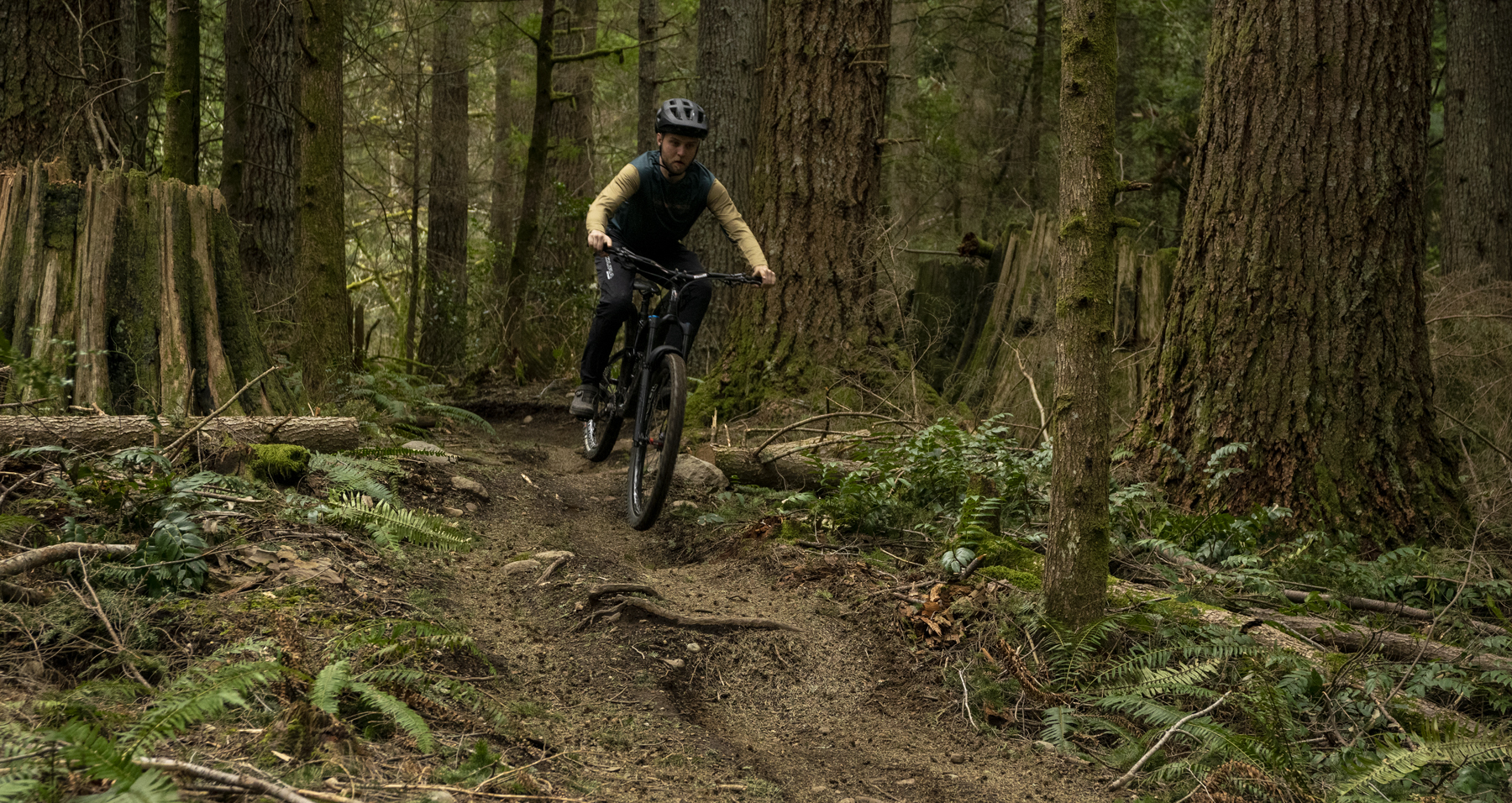
I also was emphatically not a fan of the one-piece Bontrager RSL bar and stem combo. It (arguably) looks cool and is very, very light, but the one-piece design means that there’s no way to adjust the handlebar roll and thus the effective sweep, and I found the angles of the stock setup to be quite uncomfortable. Granted, bar roll / sweep is a thing that I think I’m probably unusually picky about, but it really didn’t work for me. Happily, swapping in a conventional bar and stem is easy (and is something that I wind up doing on a lot of review bikes — like I said, I’m picky), but the one-piece design limits adjustability and I think is going to cause more folks problems there than conventional designs.
The in-frame storage on the Fuel EX generally works fine, but the opening isn’t all that big and it’s a bit hard to stuff larger stuff (e.g., a light jacket) in there. It also gave me what has to be the funniest noise issue I’ve ever encountered on a review bike. The Fuel EX that I tested had been ridden prior to getting sent our way, and when I started spending time on it, there was a muffled but noticeable rattle coming from somewhere around the downtube or bottom bracket area. As it turns out, it was a dried-out and quite-hard strawberry gummy that was rattling around in the bottom bracket shell after escaping whatever some previous rider had it stored in.

I don’t think there’s a big moral to the story here, other than to keep whatever you put in your downtube storage in some sort of pouch, whether it’s the included one or a different option of your choosing. In this case, it was mostly just amusing. The only real (but very minor) build quality note I’ve got is that the upper downtube protector started to sag a bit after a little while and looked a little ragged, but that’s hardly the end of the world.
I don’t mean for that to sound like a lot of complaining — overall, I think the build on the Fuel EX 9.8 XT is quite sensible, and generally a solid value for the money. Commenting on the couple of things where I saw room for improvement just feels a lot more noteworthy than rehashing that, yes, the Shimano XT drivetrain still works really well, etc. And while the Fuel EX 9.8 XT that I rode is a pretty good value for money, I think the 9.7 build might actually be the best bang-for-buck option in the line. On the 9.7, you get the same carbon frame, functionally very similar suspension (the Fox 36 Rhythm uses the older-generation chassis and is a little heavier than the newer 36 Performance on the 9.8 XT, but shares the same basic spring and damper design), and a slightly heavier but still strong-performing Shimano Deore / SLX / XT blend drivetrain. The loss of the carbon wheels is the biggest difference between the two at the end of the day, but for $1,550 in savings at retail price, I can live with that.
Comparisons
Here’s how the Fuel EX compares to several other bikes in its class. If you’re curious about other models, aren’t sure where to start in the first place, or have any other gear questions, you can Become a Blister Member , send us a message via the Member Clubhouse , and we’ll help you out one-on-one.
Trek Fuel EX Gen 5
I don’t have a ton of time on the prior-generation Fuel EX (which is still available from Trek, at least for the time being) but I’ve ridden one enough to know that the new sixth-generation version is pretty different. The new Fuel EX is much more stable and composed at speed, less nimble at low speeds in tight spots, and despite gaining 10 mm of suspension travel at both ends, probably pedals more efficiently. The new one is significantly “more” bike in most respects apart from pedaling efficiency.
Santa Cruz Hightower
This is one of the better comparisons here, but there are still some real differences. In the more middle-of-the-range geometry settings, the Fuel EX is a touch more stable at speed but a little less agile than the Hightower. The Fuel EX also pedals more efficiently but doesn’t offer quite as much traction under power.
But none of those differences are great enough to make them unreasonable bikes to cross-shop against each other or make it super cut-and-dried as to who should be on which bike, and they generally feel targeted at similar types of riding and use cases — just with slightly different characteristics. It’s also worth noting that their sizing breaks are a bit different, and there are likely going to be folks who simply fit one better than the other since, for example, the Large Fuel EX fits a little bigger than the Large Hightower.
Santa Cruz Bronson
Pretty different. The Fuel EX pedals a lot more efficiently than the Bronson but feels significantly less plush and cushy on the way back down. The gap in stability between the two isn’t as large as the differences in suspension performance might suggest, though the Bronson is still more bike on that front, too. And even with the Fuel EX set up as a mullet, the Bronson feels more oriented toward a riding style that favors slashing the rear end around and riding with more weight over the front end to facilitate that.
Transition Smuggler
This one’s interesting — the Smuggler and Fuel EX fit and handle pretty similarly, but feel quite different in terms of their suspension performance. The Smuggler feels much more supportive and lively whereas the Fuel EX is more plush and cushy, at the expense of some composure in really fast, rough sections (which, again, I think has more to do with the shock tune than anything to do with the frame itself). Despite the Fuel EX’s extra suspension travel, the two are pretty close in terms of pedaling performance and efficiency, though the Fuel EX definitely has an edge in terms of traction and grip under power.
Pretty different. These two are actually pretty close in terms of where they land on the super-quick handling to super-stable spectrum but differ substantially in a lot of other ways. The Ripmo has more suspension travel, and definitely feels like it — it’s more composed when plowing into rough sections of trail at speed, in particular. But its suspension also feels firmer and more supportive, as compared to the more plush and cushy Fuel EX. The Rimpo also has more of a notable preference for being ridden with a forward stance with some significant weight over the bars, whereas the Fuel EX feels happier being ridden more centered / neutrally, and has a bigger sweet spot in terms of body positioning — though I think some of that is driven by the fact that the Large Fuel EX fits just a bit bigger than the Large Ripmo we reviewed; the Fuel EX fits me better, personally, but that’s going to vary rider to rider.
Overall, the Ripmo feels like a bit more game-on, hard-charging bike whereas the Fuel EX is happier taking things easier, while still having a solid top end when you decide to open it up. In terms of pedaling efficiency, they’re not too far off from each other but I’d give a slight edge to the Fuel EX.
We Are One Arrival 152
Similar story to the Ripmo, but to a greater extent. The Arrival is a much more game-on, descending-focused bike than the Fuel EX and takes more speed and aggression to come alive, but rewards that sort of approach with an impressively stable, composed ride for a bike that’s pretty quick handling (again, when you’re on it and riding hard). The Arrival is also much more supportive and lively in its suspension performance, but less plush and cushy than the Fuel EX.
Orbea Occam LT
Also pretty different. Despite having 10 mm more rear wheel travel, the Occam LT pedals even better than the Fuel EX and feels especially sharp-handling and quick, whereas the Fuel EX is a little more stable at speed, especially in rougher terrain, but not as agile. The Fuel EX is also much more plush and forgiving in terms of its suspension performance at lower speeds but is far less nimble and pop-y than the Occam LT.
In terms of its handling and ride character, the Occam LT feels like a shorter-travel bike than it actually is, just one that’s got the extra compliance of a 150mm-travel bike when you really need it. The Fuel EX feels like “more” bike despite having a touch less suspension travel.
Orbea Rallon
The Rallon, on the other hand, is way more bike than the Fuel EX — more stable, more composed in rough sections, not as quick handling, and so on. It’s one of the most versatile, most efficient-pedaling Enduro bikes we’ve ever tested, but it still is a modern Enduro bike. The Rallon is impressively close to the Fuel EX in terms of pedaling efficiency, given that it’s got 20 mm of extra travel at each end, but the Fuel EX still wins out there. The two aren’t too far off from each other in terms of small-bump sensitivity, either, but the Fuel EX feels more plush and eager to use a lot of its travel at lower speeds and with mellower riding, whereas the Rallon is a lot more composed and supportive when you start hitting stuff harder.
The Fuel EX and Rallon do remind me of each other somewhat in terms of the way they fit and in the cornering styles they excel at most strongly — both are especially good when loading the bike up through the pedals, getting both wheels to grip hard, and carve through mid-speed, well-supported corners in particular — but the Rallon is much more bike in most respects.
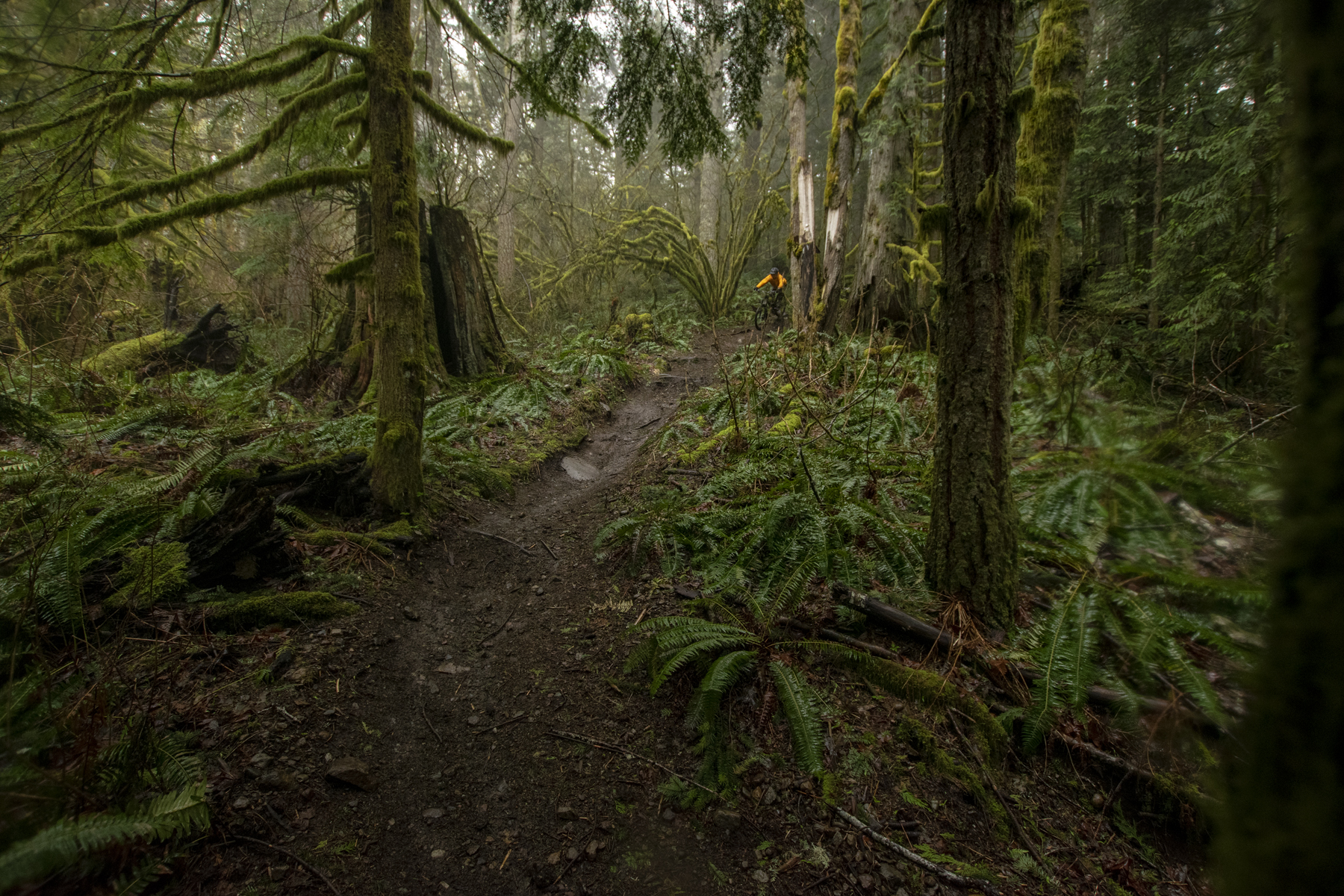
Who’s It For?
The new Fuel EX is an excellent all-rounder Trail bike, especially for people who favor a slightly softer, more supple suspension setup but still want a bike that pedals quite efficiently. It’s very versatile in terms its preferred riding style(s), has a big sweet spot in terms of body positioning and approach, and offers a really nice blend of solid stability and reasonably quick handling, plus a whole lot of adjustability to dial it in to your liking. Heavier and/or more aggressive riders might find the stock suspension tune to be somewhat lightly damped for their preferences — and I’d count myself among those people — but if you’d prefer a more plush, cushy ride, or are willing to put some work into getting the suspension tuned, there’s a lot to like here.
Bottom Line
The new Fuel EX is an especially well-rounded and versatile Trail bike that we can see working for a lot of different riders — especially since it has such a broad range of frame adjustments on offer. Riders who tend to favor firmer, more supportive compression tunes are likely to find the stock setup to be a bit lightly damped, but plenty of other folks are likely to appreciate the plush, smooth ride. And though I didn’t have the opportunity to test this hypothesis, I don’t think there’s anything inherent to the frame design that would stop folks who want a firmer compression tune from getting there via aftermarket tuning or a shock swap.
I want to be careful not to make too big a deal out of the shock tune — it wasn’t quite what I wanted, but I also definitely tend to prefer firmer, more supportive compression damping and I think that the stock setup will work great for a ton of people. And I really, really like the Fuel EX otherwise — it’s an impressively versatile bike that I was able to have a great time riding on a ton of different sorts of trails and one that I would be happy to take most places in the world as my one bike and not feel like I was missing out. And it’s one that I’ve already recommended to a bunch of Blister Members who’ve reached out looking for an all-rounder one-bike quiver, because the Fuel EX is a really good one.
2 comments on “2023 Trek Fuel EX”
Great review, did you manage to get the 200mm dropper in all the way? I am thinking of getting a 200 on my size large.
Yeah, pretty easily. I run a ~780 mm seat height (center of BB to top of the seat, on 170 mm cranks).
Trek has a good seatpost insertion guide in the service manual on their site. It is worth noting that the aluminum frames have a little less insertion than the carbon ones — 265 mm vs. 281 mm for the size Large of both.
Leave a Comment Cancel reply
Trek’s 2023 Fuel EX MTB gets a full overhaul and adjustable everything!
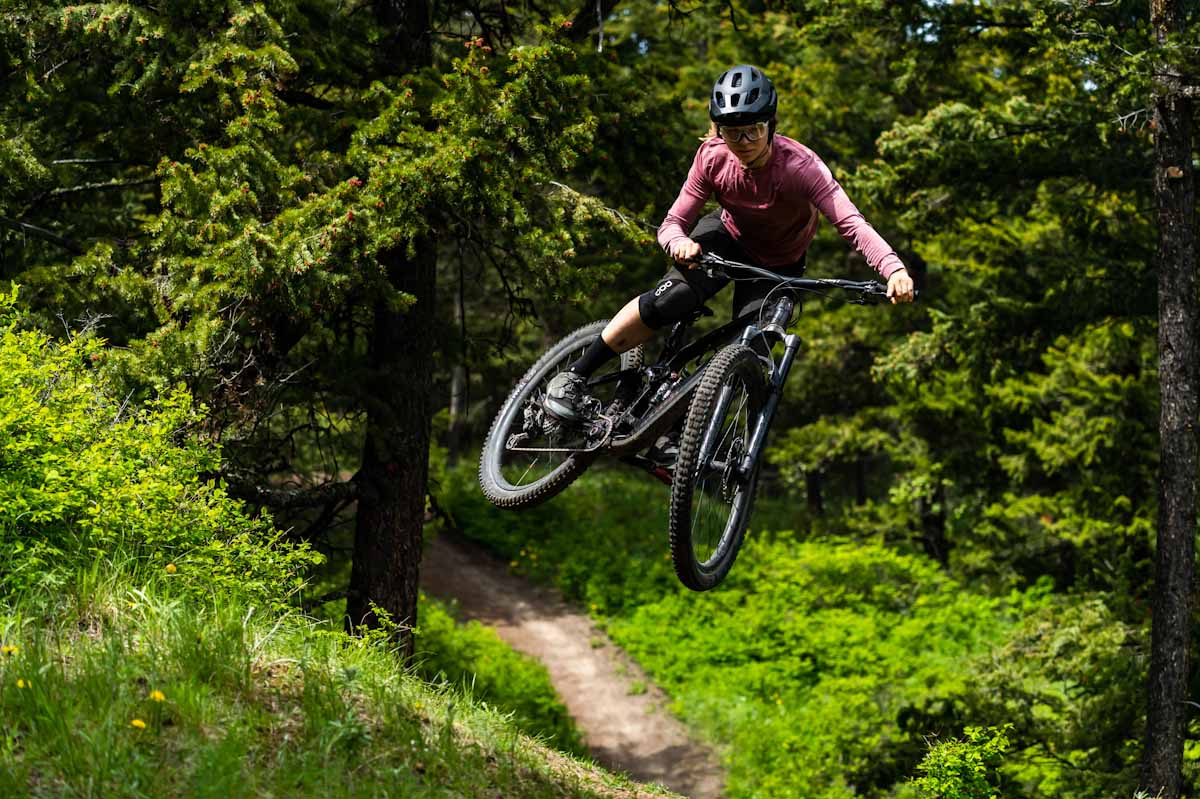
- Click to share on Facebook (Opens in new window)
- Click to email a link to a friend (Opens in new window)
There is something special about a bike that can do nearly anything, and Trek has honed their new Fuel EX into a top contender in the ‘quiver-killer’ category. The recipe starts with 140/150mm travel, modern geometry and 29” wheels, but Trek decided to offer a ton of adjustability too; The frame geometry, steering angle and shock rate can all be tuned on the new Fuel EX.
The Fuel EX’s range of adjustment allows this bike to be anything from a cross-country machine to a short-travel enduro bike, and the wide range of available models offers an option for many budgets.
2023 Trek Fuel EX frame features:
All features listed below are included on both the aluminum and carbon framed Fuel EXs (except the entry-level Fuel EX 5, which uses the previous generation aluminum frame with 130mm travel and does not offer many of the features described below).
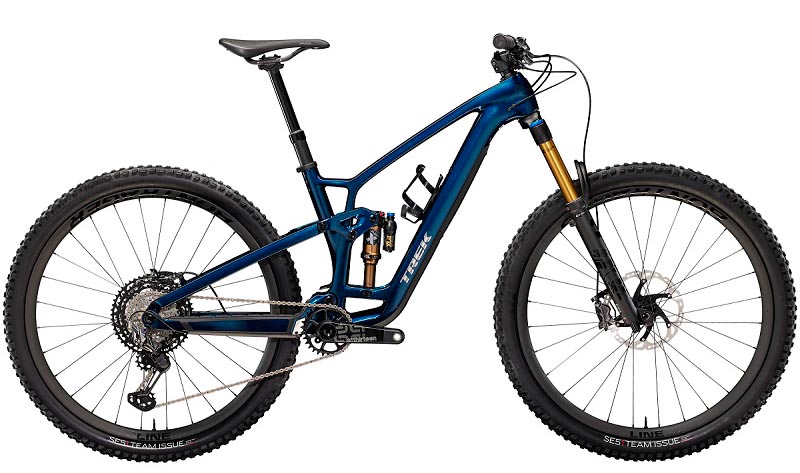
The fully redesigned Fuel EX features Trek’s ABP suspension linkage, now offering 140mm rear travel and matched to 150mm forks. Wheel size and fork travel does vary on some models; The XS frames run 27.5” wheels and a 140mm fork, and Small frames offer either 27.5” wheels (with a 140mm fork) or 29” wheels (with a 150mm fork). All larger sizes run 29” wheels front and back, but they can be converted to MX setups. However, Trek recommends a 160mm fork for mixed-wheel riders.
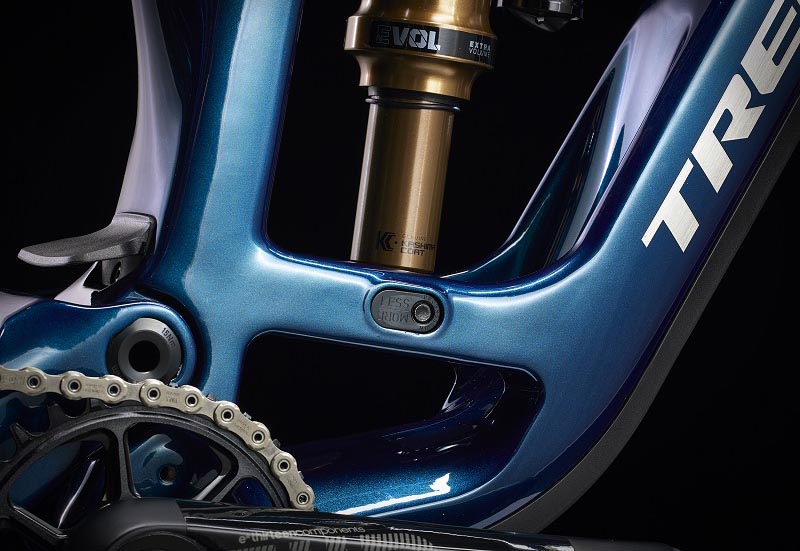
Trek’s Mino Link geo adjustment chip offers High or Low frame positions, and a new addition to the Fuel EX is a ‘LESS/MORE’ suspension progressivity flip-chip at the lower shock mount. This chip offers a more progressive curve to accommodate coil shocks, or simply to better suit burlier riders. Flipping this chip has no effect on frame geometry.
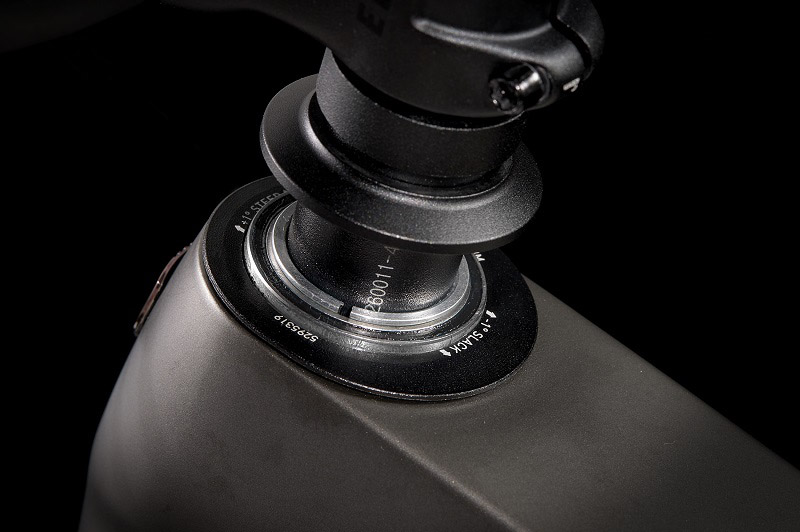
The new Fuel EX does not come with Trek’s Knock Block 2.0 headset. What you get instead is the option of adding angle adjust headset cups (not included) with +/- 1 degree settings.
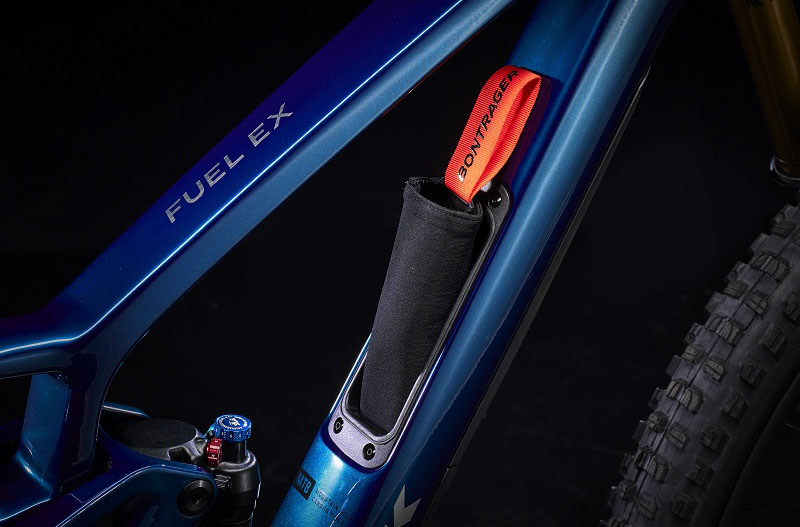
Trek has jumped on board with down tube storage, offering a good-sized compartment with a Bontrager BITS tool roll included with all models. If you go for the high-end 9.9 bikes, you also get a Bontrager multi-tool in the steerer tube.
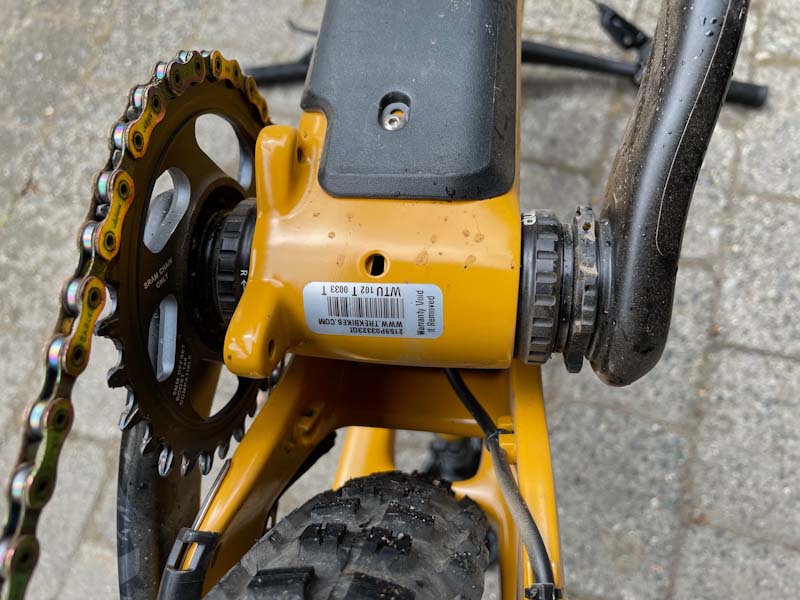
Key frame fitments include Boost 148 rear spacing (with Boost 110mm forks on all models), a trusty threaded 73mm bottom bracket, a beefy 34.9mm seat tube, ISCG05 chain guide tabs, and a SRAM UDH derailleur hanger.
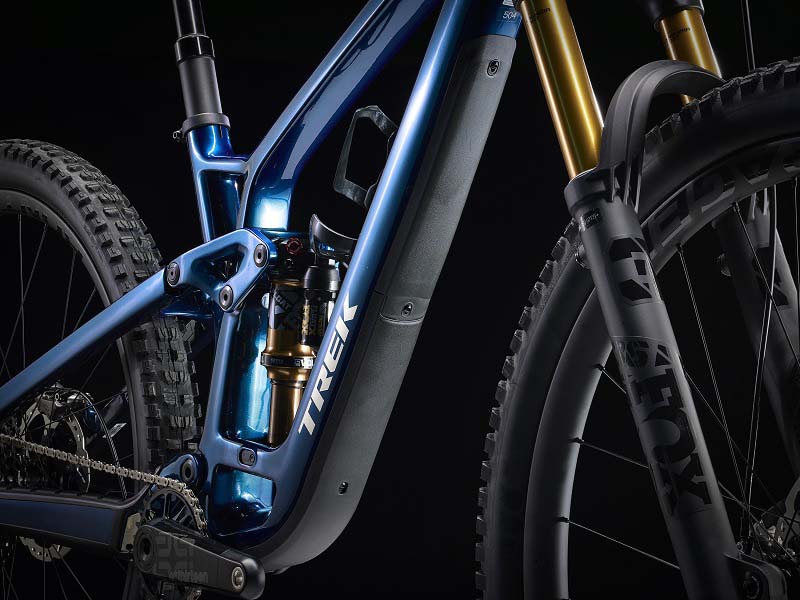
The frames all offer guided internal cable routing, and come with down tube and chainstay protectors. Trek even added a little mudflap to keep rocks from getting between your BB shell and chainstay yoke. Maximum tire clearance for all frame and wheel sizes is 2.5” wide, and the biggest chainring you can run is 34t.
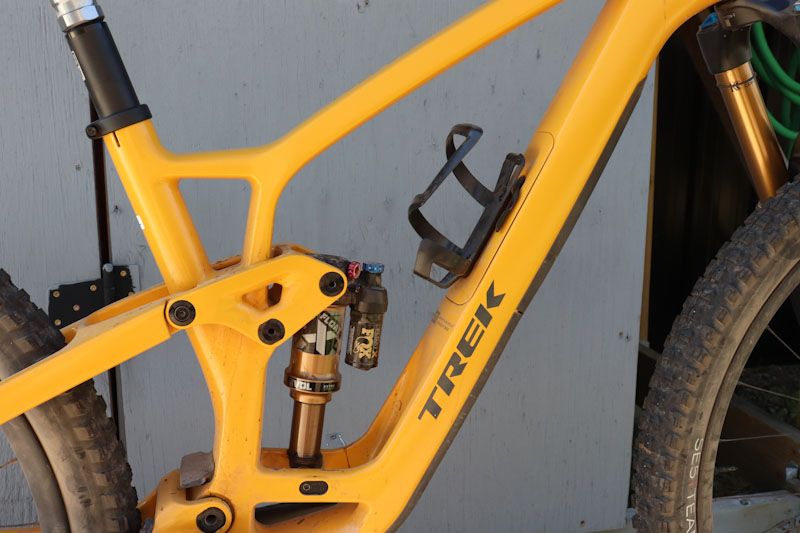
The new Fuel EX frame offers more insertion depth for dropper posts than the outgoing version. Stock post lengths are 100mm travel for XS and small frames, 150mm for the medium or M/L, 170mm on larges and 200mm on XL bikes (except the 9.9 XX1 AXS, as the longest Reverb dropper available is 170mm).
All frames can fit a water bottle, but with limits; XS frames can only run a 15oz bottle, S-M/L’s can hold up to 21oz, and large and up can fit 26oz bottles.
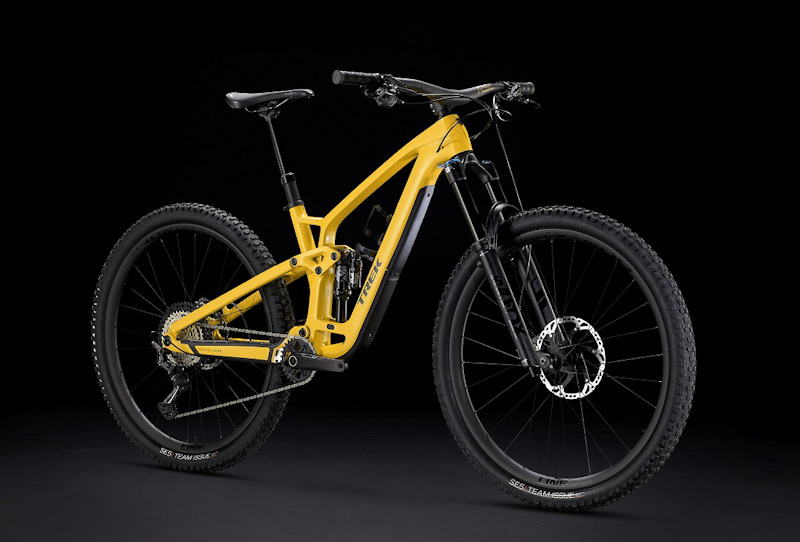
The higher-end Fuel EX models (9.8 XT and up) will be available as a Project One bike with custom paint options, and paint-matched replacement storage doors are available for higher-end models (lesser models get a black door).
Trek did provide weights for the Fuel EXs- To sum it up, all carbon models are under 33lbs, while the aluminum completes go up to just over 35lbs.

There is a lot of potential adjustment with the new Fuel EX frames – The Mino link can be in High or Low position, and the optional angle-adjust headsets can be in steep, neutral or slack positions. Some angles and measurements also vary according to frame sizes, so between the nine different charts Trek sent I’ll do my best to generalize things here!
Trek did provide mullet geometry, but I’ve intentionally left that out of my description below… there are enough numbers to crunch between the stock setups and headset options, so check out Trek’s website for MX geometry.
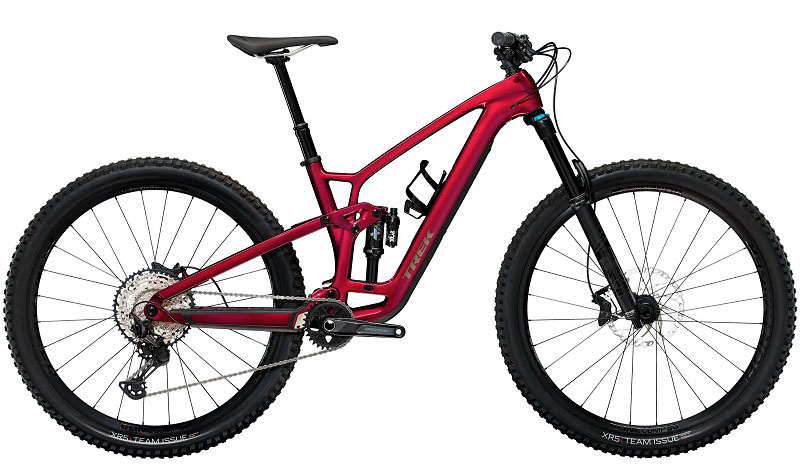
Reach numbers are generous across all sizes; the M/L I was testing is one of the longest bikes I’ve ridden at 470mm. Something new for the Fuel EX is how rear end lengths now vary according to frame size; They’re 435mm up to size Medium, 440mm for M/L or Large, 445mm for XL and 450mm for XXL.
Steering angles go from slightly steep to really slack! With the angle-adjust headset cups, the steepest angle possible is 66°, while the slackest possible is just 63.5°. With the stock neutral headset cups, the steering angle varies from 64.5 to 65°.
The Fuel EX has a steep seat tube, with different frame sizes varying from 78.9 to 76° depending on geo settings. BBs sit pretty low in the bike’s Low position, ranging from 332-335mm according to frame size. High position bumps that up to 340-343mm.
Model Lineup:
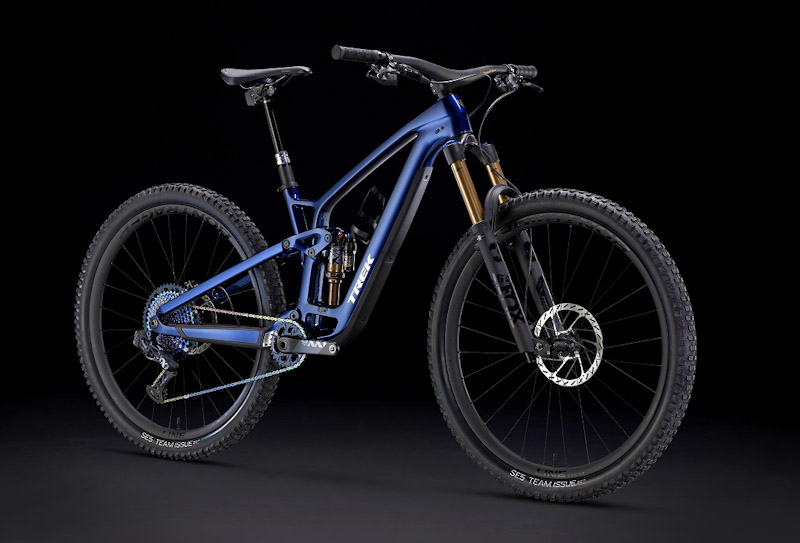
There are eight different models of the new Fuel EX (including the Fuel EX 5 using the older frame), so I’ve provided the list with pricing but you’ll have to visit Trek’s website for full build specs on each. One highlight of the specs is that the top four models all get Bontrager’s carbon wheels and RSL one-piece carbon bar/stem.
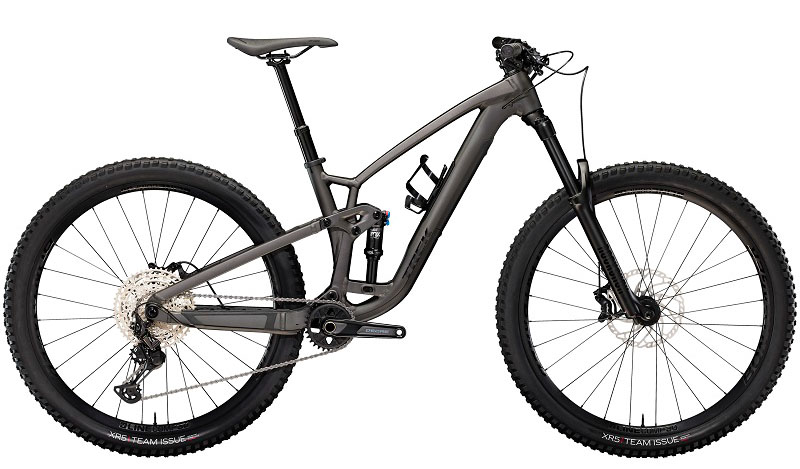
Color options for the carbon frames are Mulsanne Blue or Deep Smoke. Aluminum frames come in Matte Galactic Grey to Black Fade. There is also a Baja Yellow colorway, which is an optional upgrade on the Project One 9.8 XT model and an included option for the other 9.8 or 9.9 models.
Fuel EX 5 – $2,699.99
Fuel EX 7 – $3,699.99
Fuel EX 8 – $4,299.99
Fuel EX 9.7 – $4,699.99
Fuel EX 9.8 XT – $6,249.99 (Project One version – $6,749.99)
Fuel EX 9.8 GX AXS -$7,699.99
Fuel EX 9.9 XTR – $9,749.99
Fuel EX 9.9 XX1 AXS – $10,749.99

The Fuel EX is also available as a frameset in aluminum or carbon (pictured above). Both include a headset (compatible with Trek’s angle adjust cups) and a 2-position Fox Factory Float X rear shock. The aluminum frameset sells for $2599.99, and the carbon kit retails at $3899.99.
I’ve been riding the Fuel EX 9.9 XX1 AXS for the last few weeks, so be sure to check out my review article to see how the new Fuel EX handles itself on the trails!
trekbikes.com

Steve Fisher is a staff contributor for Bikerumor. Steve has been writing about trail, enduro and downhill mountain biking (plus a few commuter bikes) for seven years. Prior to that, Steve wrote for Whistler Traveller Magazine and Mountain Life Magazine. Steve is based in Pemberton, British Columbia, an area that offers plenty of challenging world-class singletrack and makes for great photos!
This site uses Akismet to reduce spam. Learn how your comment data is processed .
Such an atrocity (hello Astro) in frame design and abhorrent pricing. I guess I’ll be thanking Trek for heralding the return of steep discounts since no one outside the die-hard Trek aficionados will buy.
Follow Us On
Subscribe Now
Sign up to receive BikeRumor content direct to your inbox.
Gear-obsessed editors choose every product we review. We may earn commission if you buy from a link. How we test gear.
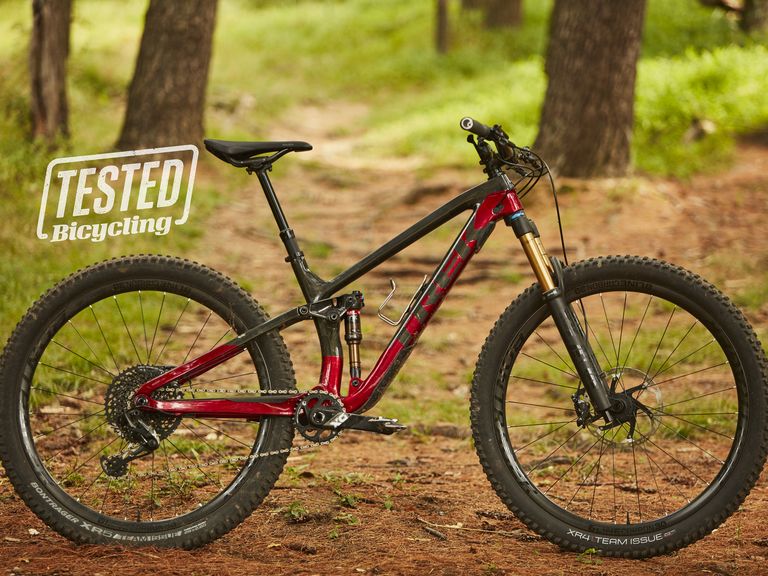
The 2020 Fuel EX 9.9 Is a World-Class Trail Bike
New geometry, more travel, and even better suspension improves Trek's mid-weight trail bike.
The Takeaway : Trek’s 2020 Fuel EX has more travel, is stiffer, and built with bigger parts. It’s a bit heavier and more capable in rowdy terrain, but still an excellent all-purpose trail bike
- Expanded range of sizes and colors, but no more women’s models.
- 140mm forks and 2.6-inch tires on all models
- Fox 36 forks on top-of-the-line models
- Lifetime frame warranty returns
Price: $2,100 to $7,500 Weight: 29.1 lb. (Fuel EX 9.9, size 17.5)
Trek’s Fuel EX was an excellent lightweight trail bike, with notes of XC race in its bouquet. For 2020 the EX effectively underwent a training montage worthy of an 80’s movie and emerged bigger and badder. It is up to 140mm travel in the front (still 130mm in the rear), longer, slacker, stiffer, and comes with bigger tires. The new EX is a trail bike with hints of enduro. Yep, it’s heavier: The top of the line model weighs about 29 pounds on our scale. But it also has a trap door and hidden storage in the downtube.
The 9.9 reviewed here, and the $5,500 9.8, have Trek’s premier shock technologies and hearty Fox 36 forks—features lower cost EX models don’t get, which is a shame, because the 9.9 is a beautifully balanced and capable trail bike. The rear suspension is superb, offering a blend of support, sensitivity, and control that might be unmatched. The suspension handles bumps like it has more travel, but pedals like it has less.
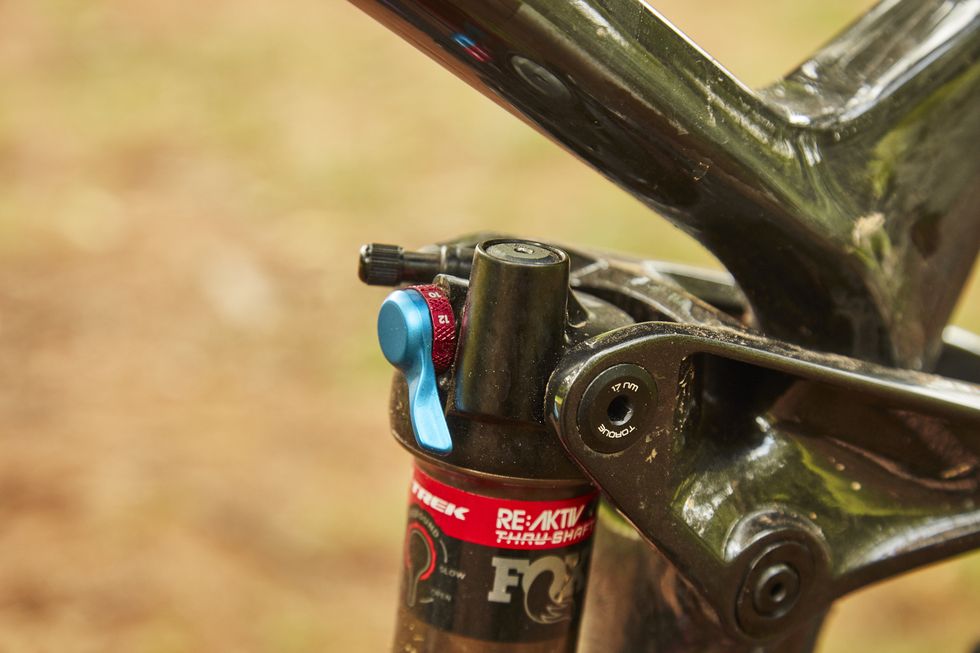
The Fox 36 with GRIP 2 damper is very stiff, which helps keep this bike on the line you want to ride—the 2020 EX’s improved rear end stiffness helps too—and the quality of the travel is lively yet controlled. Yes, I’m gushing, but this suspension deserves it. It’s too bad Trek didn’t see fit to fit this bike with a decent dropper though. The stock Bontrager post is sticky and sluggish.
The longer and slacker geometry provides a more centered feel when you’re working the trail with the saddle dropped. The bike’s steering is light, and the bike climbs technical singletrack very well—a nice suspension platform and crisp pedaling manners help. On downhills, it’s very sure-footed and even rides a little bigger than its travel and geometry might suggest.
There are a lot of great trail bikes you can buy right now. This EX makes a strong case that it’s one of the very best.
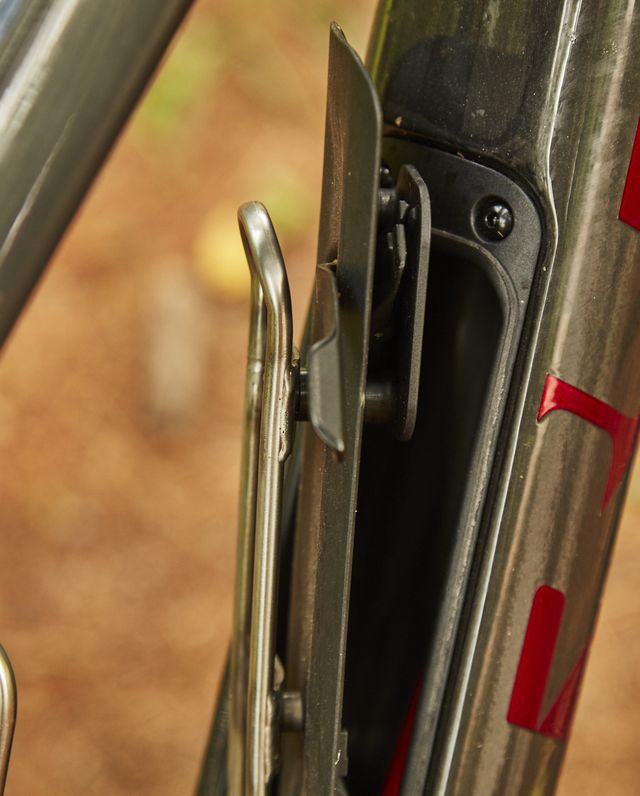
Hidden Storage
The new EX has a trap door that lets you store stuff in its downtube.
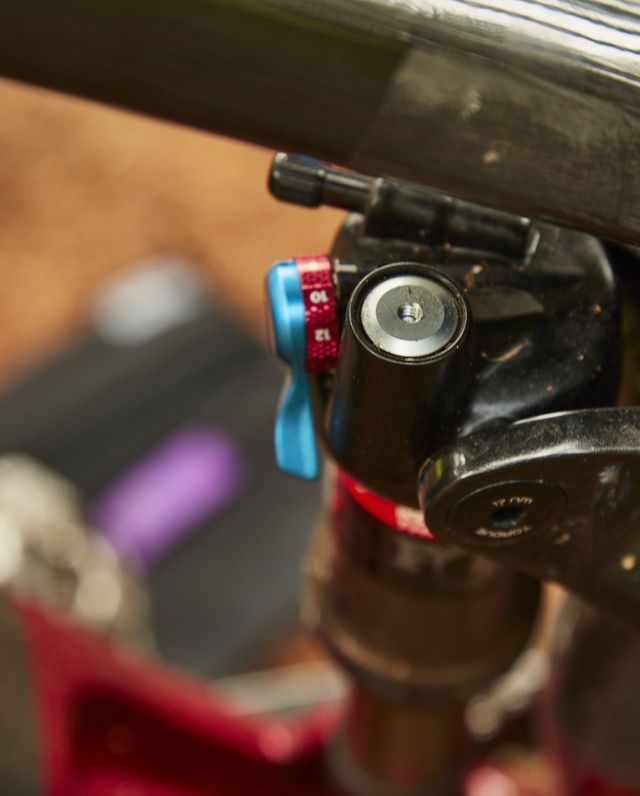
Easier Setup
A number rebound knob makes proper setup easier.
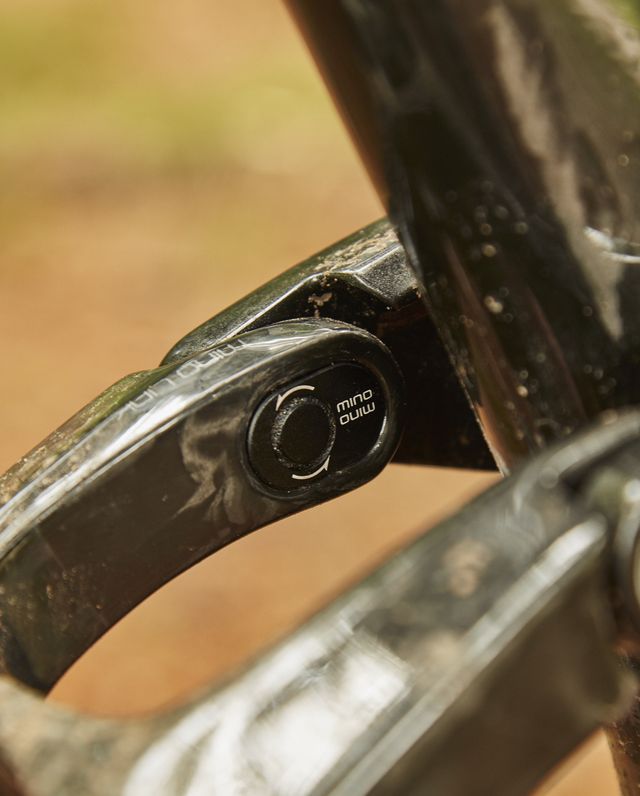
The Mino-Link flip chip adjusts head and seat angle 0.5 degrees.
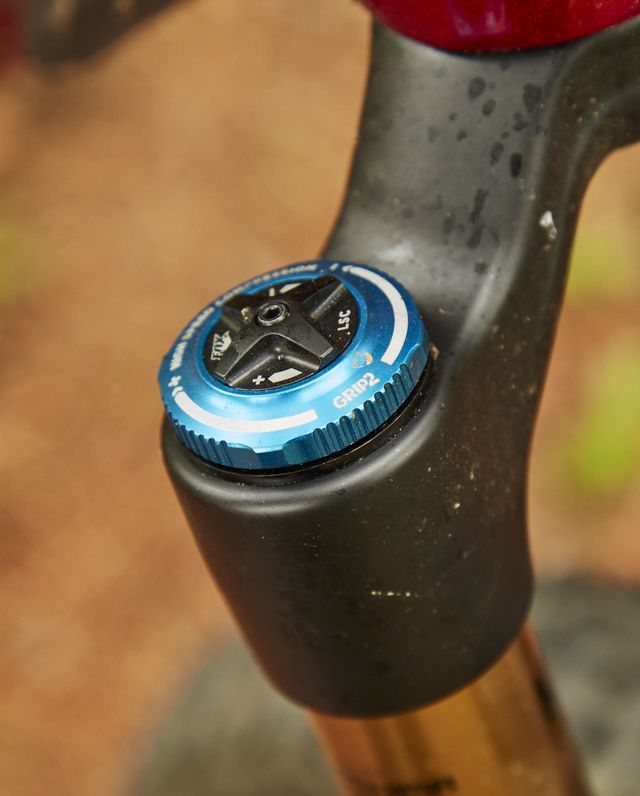
High and Low
The GRIP2 damper offers 4-way external damping adjustment.
The 2020 Fuel EX 29er is more than just redesigned; it’s repositioned. Trek launched the new Top Fuel earlier this year, transforming it from an XC race bike to a longer-travel (115/120mm) and more trail-oriented bike. That narrowed—practically eliminated—the gap between it and the 2019 130/130mm Fuel EX. But the 2020 Fuel EX also bumps up in travel and gets a little burlier. It’s now a bigger trail bike tiptoeing toward the enduro category.
Rear travel remains 130mm, but on the front are 140mm forks, with higher-end carbon models using Fox’s 36. The frame is stiffer, and gets longer (10 to 20mm depending on size). Angles change too: the head tube is a degree slacker (66 in low, 66.5 in high), while the seat tube gets a degree steeper (75 in low, 75.5 in high). As you can tell, the frame still employs a geometry-changing flip-chip.
Frame: Carbon Wheel Size: 29 inch Travel: 130mm Shock: Fox Factory Float Reactiv ThruShaft Fork: Fox Factory Float 36 Grip 2, 140mm Drivetrain: 1x12 Crankset: SRAM X01 Eagle Rear Derailleur: SRAM X01 Eagle Dub Cassette: SRAM XG-1275 Eagle, 10-50 Brakes: Shimano XT 4-piston hydraulic disc, 200mm (f), 180mm (r) rotors Seatpost: Bontrager Drop Line Elite Rims: Bontrager Line Carbon 30, 30mm internal width, tubeless ready Tires: Bontrager XR4 2.6-inch
There’s also a new trap door in the downtube—carbon models only—that provides that sweet, sweet storage in the downtube. An organizer roll—included—has pockets for a tube, Co2 cartridge, inflator head, and tire lever and keeps it all from rattling around. A plastic side-load bottle cage is included with the bike. We’ve also heard rumors that a tool that fits in the headtube will arrive later this year.
The switch to longer and slacker frame geometry brings with it shorter offset forks. This isn’t shocking—almost every new mountain bike that rolls out with uses a shorter offset fork. But for Trek, it’s a more significant change because it means rolling back from a feature it heavily promoted for many years. Its Genesis/G2 29er geometry is based around longer (51mm) offset forks. But that geometry has its roots in the beginnings of the 29er movement, when brands were trying to make 29ers handle like 26-inch-wheeled bikes (that was a thing), and also the days of shorter and steeper geometry.
But that era is over, and Trek is moving on, “Modern geometry and its longer reach and slacker headtubes requires a smaller offset to put the front wheel in an appropriate spot under the rider,” said Travis Ott, Trek’s mountain bike brand manager .

Fork offset isn’t the only place where Trek is walking back from a signature feature: Full Floater , the “floating” shock mount that was a feature of the Fuel EX for several generations is gone, and the bike now uses a fixed lower shock mount.
Trek engineers in the past said that Full Floater let them achieve a better shock rate—for better suspension performance throughout the travel—than they could with a fixed lower mount.
But that was then. The new generation of shocks, Trek says, offer the performance that previously was only achievable by using Full Floater, making the floating shock mount redundant. As a secondary benefit, the fixed-lower shock mount also helps Trek improve frame stiffness.
Higher-end EX models get a custom Fox Float shock with a list of Trek-only features. There’s a mini-piggyback reservoir that dissipates more heat in demanding situations, a thru-shaft design to reduce friction , and Reaktiv regressive damping for a firm pedaling platform without compromising sensitivity.
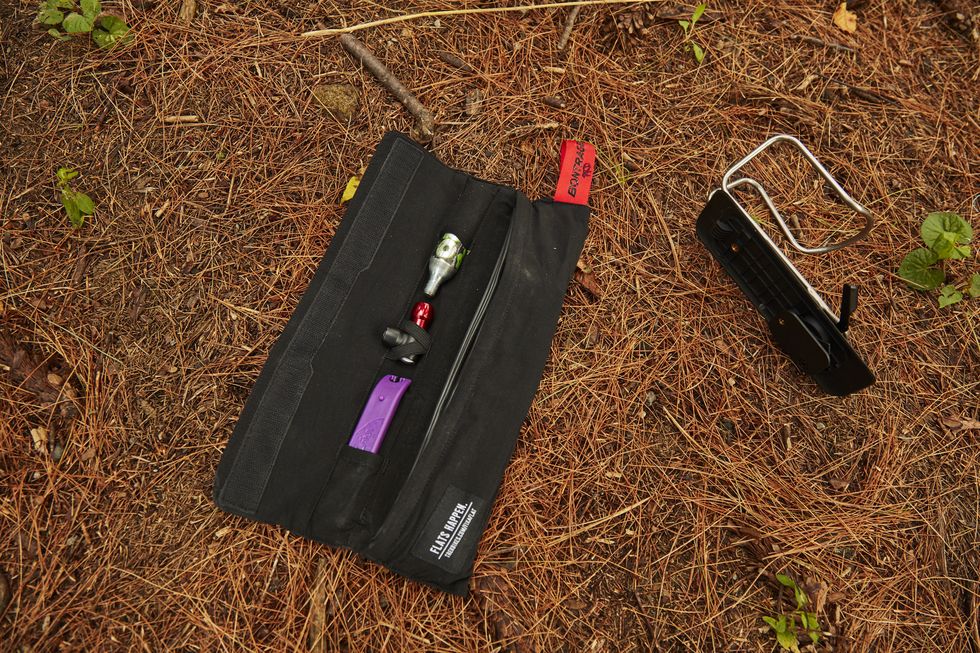
There’s also a numbered rebound knob to make setup easier. Trek representatives told me that customers found rebound settings like “15 clicks in” or “seven clicks out” confusing, and as a result would ride improperly tuned suspension. Now, Trek’s setup information can provide an easily understandable setting like “6” that matches a number on the knob.
The 2020 Fuel EX fits up to 2.6-inch tires front and rear. And to ensure “all” 2.6 tires fit, the EX’s forks get a custom spacer that slightly increases its axle-to-crown length compared to a stock 140mm fork and provides more crown clearance.
2020 Fuel EX frames come in aluminum or carbon. And all carbon frames are all carbon—no more carbon front ends with aluminum rear ends on mid-tier models. All frames have a lifetime warranty. Carryover features include Trek’s Knock Block headset, which prevents the bars from swinging around and damaging the top tube, and anti-rattle hose and housing with internal routing.
Gender, Sizing, and Wheel Size
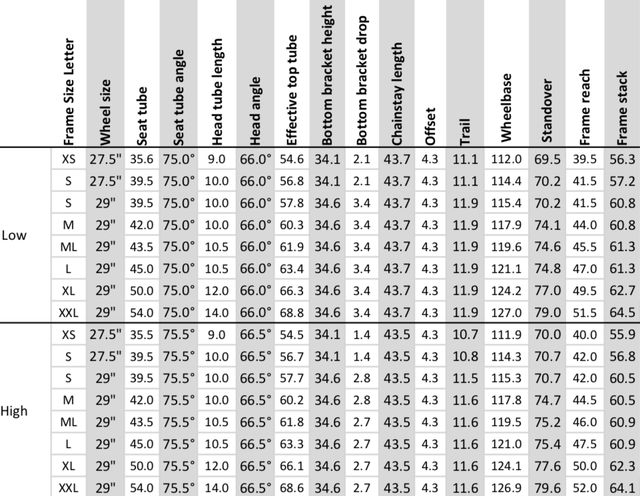
The 2019 Fuel EX came in three women’s models and six unisex models. The 2020 EX line consists of six models with no women’s models. Instead, all 2020 EX models are available in a greater frame-size range and two colors. This, Trek argues, gives all riders more options to choose. None of the 2020 models get women’s saddles. Potential buyers will need to negotiate with a Trek dealer if an EX’s stock saddle doesn’t work for their anatomy.
The 2020 Fuel EX comes in eight sizes—extra small through double extra-large. The extra-small bike has 27.5 wheels, but the next size up comes with either size 27.5- or 29-inch wheels. All other sizes get 29-inch wheels only.

The Fuel EX Family
The new EX comes in six “mainline” models priced from $2,100 to $7,500. The EX is also customizable through Trek’s Project One program.
The three least-expensive models—$2,100, $2,900, $3,500—use an aluminum frame, and the three most expensive models—$4,100, $5,500, $7,500—use the full-carbon frame. Frame only is offered for both materials: $2,000 for aluminum and $3,300 for carbon.
All models use 140mm forks, however only the two most expensive bikes—the 9.8 and 9.9—get a Fox 36 fork. All other models use a Fox 34, RockShox 35, or RockShox Recon. On the other end, the least-expensive model uses a RockShox shock, but all other models use a Fox Float. You need to step up to the $3,500 EX 8 before you get the Reaktiv regressive damper in the shock, and it’s not until you hit the $5,500 EX 9.8 that you access the thru-shaft damper design.
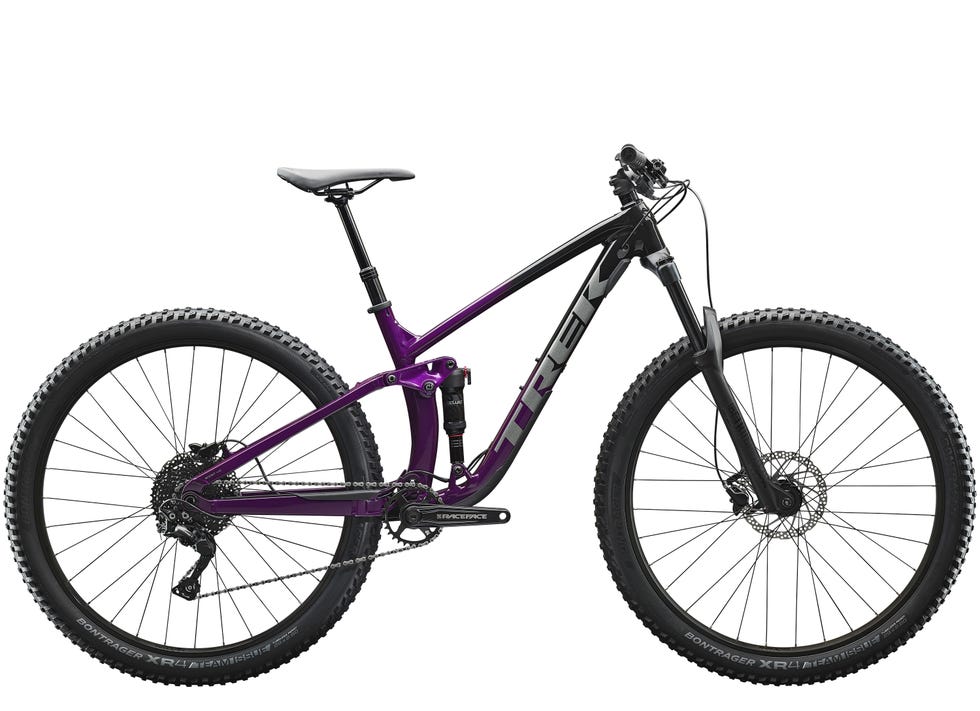
So yeah, you don’t get *all* the good stuff—carbon frame with internal storage, 36 fork, thru-shaft shock, Reaktiv damping—until you spend $5,500.
All but the cheapest model come with 1x12 drivetrain and tubeless-ready rims. All models come with Bontrager 2.6” wide tires, dropper post, lock-on grips, and hydraulic disc brakes.
Ride Impressions
Not surprisingly, Trek sent me the top-of-the-line 2020 Fuel EX 9.9 X01 ($7,500). This model and the 9.8 have all the new features and all of Trek’s premier technologies.
But most EX models come with much different forks and shocks that will significantly affect how the EX performs— a bike with a 36 on the front rides much differently than a bike with a 34 on the nose, even if everything else is the same. So I’m only comfortable extending my impressions to two of the six 2020 EX models. I hope to ride one of the less expensive aluminum models to see how it rides and offer those impressions in a stand-alone review.

I hope they can come close to the performance of this bike because this 2020 EX 9.9 is excellent. It’s not the same bike it was before: the new EX is a little slower on the climbs than the old one, and a bit heavier, but a lot better everywhere else. It’s still a capable and versatile bike, but its window has shifted from marathon racing and trail bike, to trail and almost-enduro bike.
The rear suspension is beautiful; as close to ideal as any bike I’ve ridden. It’s sensitive where you want it to be, firm and crisp where it should be. It feels deep and controls big hits very well, and there’s a nice platform for pedaling, and to pump and pop off of when you’re playing.
The Fox 36’s GRIP2 damper continues to set the bar for performance. Once you get its settings right—and it may take some fiddlin’ with the four clickers to get there—no other fork matches its combination of traction, control, stiffness, and weight. Its performance pulls this bike’s capabilities to a new level, especially in demanding terrain.
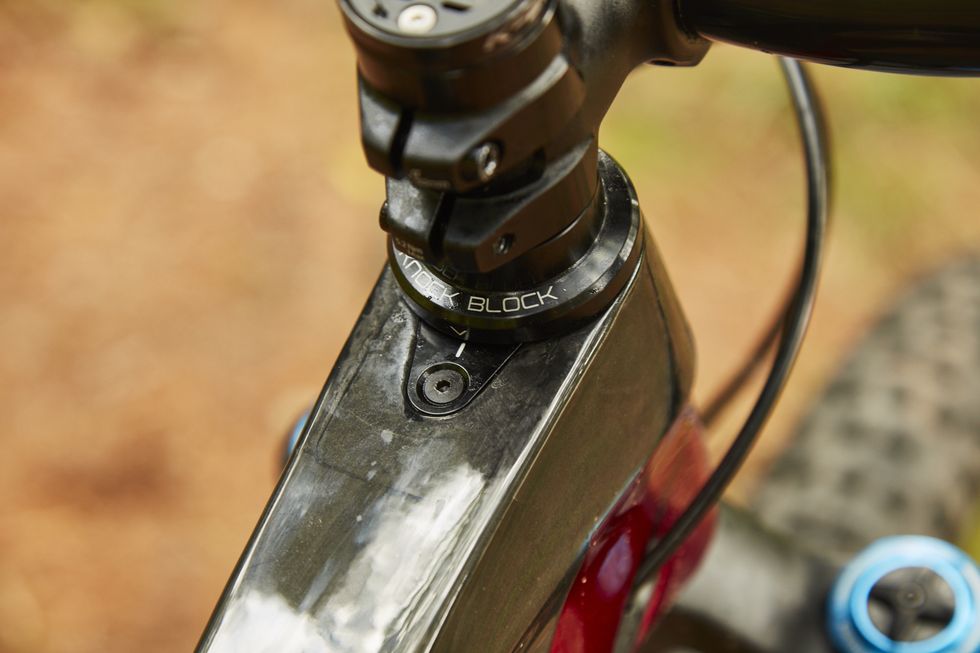
The new geometry is well balanced: You can push this bike hard in pretty demanding terrain, and it still climbs tight and technical trails well, and without fighting the front wheel (too much). The EX’s seat tube angle isn’t crazy-steep for a modern mountain bike, but it doesn’t need to be: the Trek’s Reaktiv damper’s platform holds the bike up in its travel better than similar bikes, preventing the rider from being pushed into the back seat because of increased shock sag from weight transfer. So even though the seat tube is “only” 75/75.5, it rides a bit steeper.
The platform also assists the EX’s pedaling efficiency. When I think of a nearly 30-pound trail bike with 2.6 tires, I don’t think quick and crisp. But this EX feels firm when you’re on the pedals and climbs lighter than a 29-pound trail bike should.
And it’s about here where I need to address my one complaint about this bike: The Bontrager dropper post. If this was a $2,000 bike, I might—might—be able to excuse its sluggishness and stickiness. But on a $7,500 bike, its performance is shameful—it performs exactly like a product that was chosen to save a few bucks. Excellent options like the BikeYoke Revive, Fox Transfer, and RockShox Reverb (the latest one), exist: This bike’s performance and high-end price deserve one.
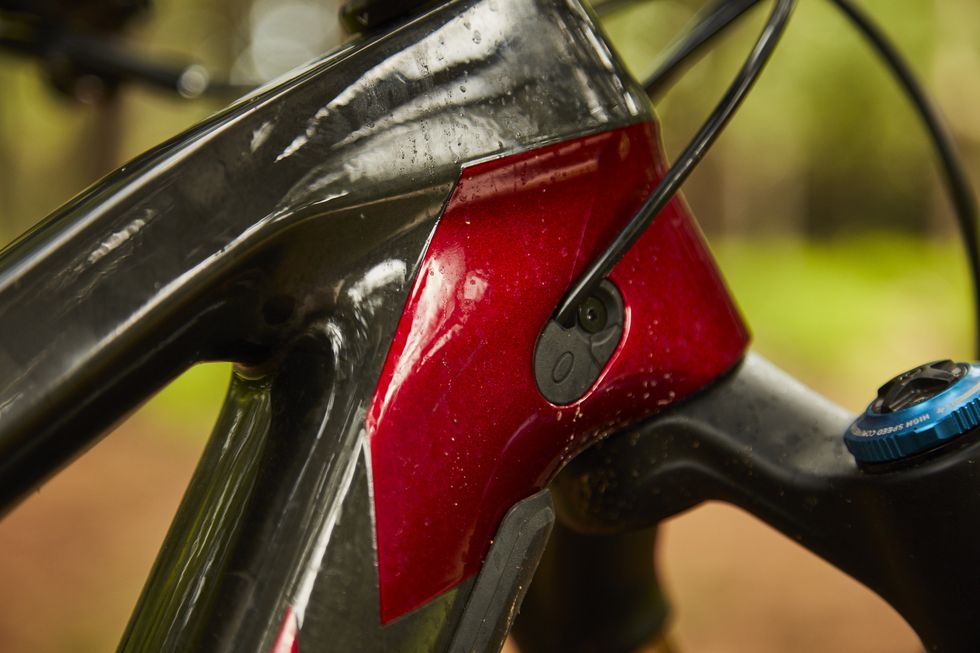
I’m a fan of the longer reach. I’m 5’8,” and in the previous generation EX I sized up to an 18.5 because the 17.5 felt short and squirrely. But the reach of the new generation in 17.5 is within a few millimeters of the 18.5 from the previous generation. In the saddle the cockpit does feel a touch short because of the steeper seat angle (I slammed the saddle back because the rear suspension rides high making the seat angle feel even steeper), but, saddle dropped, I felt perfectly centered in the bike and not hanging over the front wheel.
It’s a great time to be a mountain biker because there are so many great trail bikes you can buy. The Fuel EX 9.9 and 9.8 are pricey bikes but have a collection of performance and features that few other bikes can match right now.
Three Awesome Knee Pads for the Trail
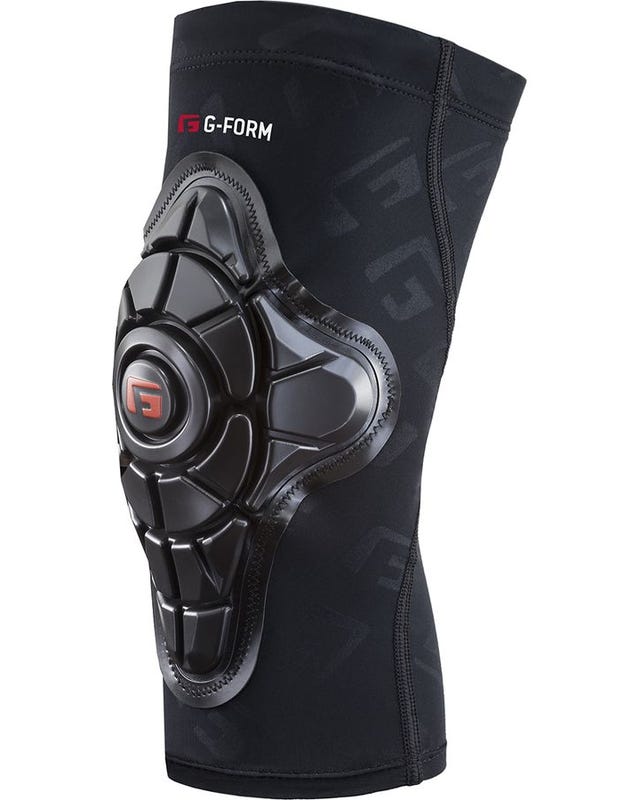
Light and Thin
G-Form Pro-X Barely noticeable sleeve with light pads and a mesh back panel. $60 | Competitive Cyclist
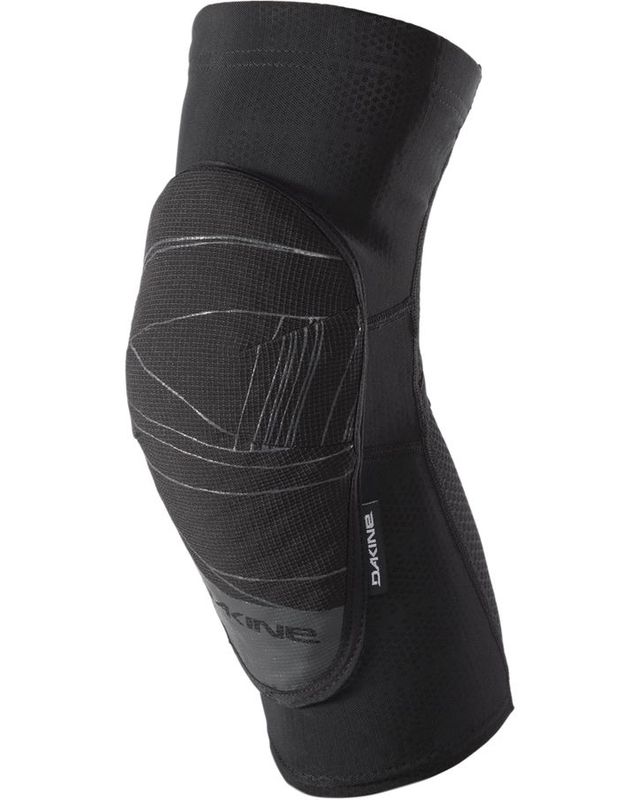
Dirt-Rash Defense
Dakine Slayer Thick padding in front with mesh behind the knees to keep you cool. $65 | Competitive Cyclist

A Padded Knee Warmer
Fox Launch Enduro Abrasion-resistant, soft, breathable, and easy to pedal in. $60 | Competitive Cyclist

A gear editor for his entire career, Matt’s journey to becoming a leading cycling tech journalist started in 1995, and he’s been at it ever since; likely riding more cycling equipment than anyone on the planet along the way. Previous to his time with Bicycling , Matt worked in bike shops as a service manager, mechanic, and sales person. Based in Durango, Colorado, he enjoys riding and testing any and all kinds of bikes, so you’re just as likely to see him on a road bike dressed in Lycra at a Tuesday night worlds ride as you are to find him dressed in a full face helmet and pads riding a bike park on an enduro bike. He doesn’t race often, but he’s game for anything; having entered road races, criteriums, trials competitions, dual slalom, downhill races, enduros, stage races, short track, time trials, and gran fondos. Next up on his to-do list: a multi day bikepacking trip, and an e-bike race.

Mountain Bike

The Spot Mayhem 140 is Brilliantly Unconventional

The Best Wireless Dropper is the Fox Transfer Neo

The 10 Best Mountain Bikes You Can Buy Right Now
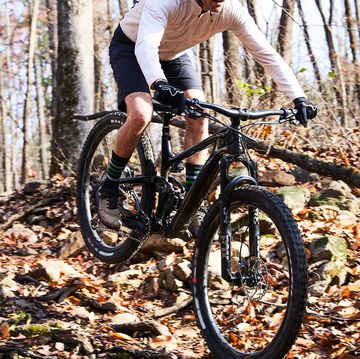
The 6 Best Mountain Bike Shorts

Speed, Balance, Refinement: Trek's Gen 4 Top Fuel

Specialized’s Stumpjumper 15 Changes Trail Bikes

Reviewed: BMC's Fourstroke LT

Little Bike, Big Attitude: Scor’s 2030

Everything to Know When Buying a Kids’ Bike

Tested: Favero Assioma Pro MX-2 Power Meter Pedals

Fresh New Mountain Bikes and Gear for Spring
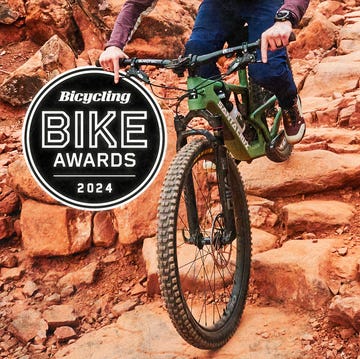
2024‘s Best Mountain Bikes

Mon - Fri: 11:00am - 6:00pm Sat: 10:00am - 5:00pm Sun: Closed
- Account Account
- Store Store
- Subtotal : $ 0.00 Checkout Cart
- Mountain Frames
- Fuel EX AL Frameset Gen 6
Trek Fuel EX AL Frameset Gen 6 - 2023

Fuel EX AL Frameset is an aluminum trail frameset that's only limit is your imagination. It features progressive trail geometry that stretches out the front end for more confidence on descents, while keeping you perched in the back for punchy climbs. Its 140mm of rear travel makes light work of tech trails and jump lines, and is ready for your dream build. You want an affordable and capable full-suspension frame to build up however you want. You crave the versatility of a bike that can handle rowdy descents, and turn around and pedal back to the top for more. A lightweight aluminum frame with internal routing to protect your cables and simplify setup. A FOX Performance Float X rear shock that makes quick work of small bumps, and smooths out gnarly descents. Adjustable geometry that allows you to take control of your headtube and seatube angle. Fuel EX AL Frameset brings forward the tech we've seen in its carbon counterpart to an alloy model that's more economical, but just as ready to slay. Its modern trail geometry is built to handle any terrain, and its packed with new features to the alloy model, like in-frame storage, and adjustable geometry. - You get a light and reliable alloy frame that's only build limitation is your imagination - It features modern geometry that's ready for steep and loose descents, and hammering up climbs - With the adjustable angle headset (angled cups sold separately) and Mino Link, you can choose from six different geometry configurations - You'll have all the space you need for your treats and tools with new in-frame storage Wheel size: - Sizes X-Small – Small: 27.5-inch - Sizes Small – X-Large: 29-inch
Due to supply-chain issues, specs are subject to change without notice.
* Subject to change without notice.
Part Numbers
Trek Fuel EX 9.9 XX1 AXS – a brilliantly balanced all-rounder at an eye-watering cost
More travel, longer, slacker and steeper, with extra adjustability and shock options. but how does trek’s new trail all-rounder ride.

Bike Perfect Verdict
An excellently balanced all-rounder with more control, adjustability, practical features and shock compatibility than before and a lifetime warranty. This all comes with a hefty price tag though, and while the Fuel EX pops and plays surprisingly well, it’s heavy for it's spec and category.
Superbly balanced adjustable geometry
Awesome suspension performance in ‘progressive’ mode
Poppy, playful and fast-climbing for its weight
Truly premium wireless, Fox Factory, carbon-loaded spec
Lifetime warranty, threaded BB and tunneled routing
Heavy for spec and travel
Costs more than parts sold separately
Default shock set-up is too linear
Headset adjustment is laborious
XX1 is fragile for aggro trail use
Why trust BikePerfect Our cycling experts have decades of testing experience. We\'ll always share our unbiased opinions on bikes and gear. Find out more about how we test.
Trek’s Fuel EX has been their best trail bike option for a decade, with an update every two years making this latest version the sixth generation. It’s a totally new bike too, with radically different geometry, more travel and a complete reversal of Trek’s previous proprietary shock obsession.
The result is obviously right up there with the best premium mountain bikes even on a first ride but it’s worth tweaking shock position and conventional sag settings straight away. The pricing on this fully wireless flagship doesn’t add up either.
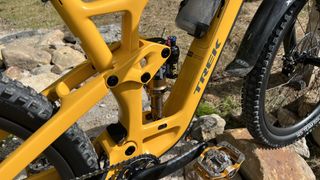
Design and geometry
While some bikes aren’t currently changing much between versions, Trek had some significant work to do to reposition the Fuel EX between the new more trail/play, less race Top Fuel and the full ‘assert Enduro dominance’ Slash . So while the overall seat tube-mounted rocker link and rear axle concentric ABP (Active Braking Pivot) rear pivot layout hallmarks are unchanged, geometry and details see big alterations.
Head angle comes set at 64.5º with the ‘MINO’ rocker/seat stay pivot chip in slack/low (65º in steep/high). You can also buy 1º +/- Aheadset cups to give 63.5º (slackest) or 66º (steepest) settings. That’s a proper 'knock out lower cup, press a new one back in’ process for the workshop – not something you can do trailside like on Specialized’s Stumpjumper Evo or Scott’s Spark . Seat angle is an average of 2º steeper with a 77.5º effective angle on my M/L test sample but a range of 78.6º to 76º across the XS to XXL size range. Reach increases by an average of 20mm, bringing the M/L up to 470mm while different mount points mean the same chainstay pieces give a range of 435mm to 450mm across the size span.
Seat tubes are shorter for more standover/long dropper post space and like the latest Top Fuel the diameter is upsized to 34.9mm for a stiffer, stronger post. Bottom bracket height is either 338mm or 346mm in the 64.5/65º head angle settings. Handling geometry isn’t the only change you can make either as the trunnion upper mount shock bolts into an eccentric mount ‘less/more’ chip in the bridge pieces above the downtube. Flipping this round creates a more progressive shock feel and increased end stroke bottom out. That’s meant to cater for more aggressive riders or those wanting to use a coil shock, but as you’ll see later I reckon that’s the best setting even for mellower trails and with the Float X air shock fitted.
Trek have also scooped out the downtube so that you can fit pretty much any piggyback air or coil shock including Fox, RockShox, DVO, Cane Creek, EXT and even Push although that big external damper won’t fit on the smallest frames. That does squeeze internal storage space slightly so squeezing a standard inner tube downwards is a bit of a wrestle. There’s plenty of room up towards the head tube for Trek’s neoprene organiser wrap. Opening the latched lid (colour coded replacements available if you lose it) also lets you see the new braided carbon guide tubes for rear brake and rear gear cable (if fitted). Thankfully Trek have kept away from the maintenance nightmares of piping cables and hoses through the stem and headset . The cage on the storage hatch takes a 440-770ml bottle depending on frame size.
Wheel size is also related to frame size with the XS rolling on 27.5in, small frames in 27.5 or 29in format and 29in for medium upwards. S sizes upwards can be run mullet if you flip the MINO link to high, although Trek recommend you fit a 160mm fork spring if you do go party out back. Other changes include a move to a threaded bottom bracket with ISCG guide tabs rather than a press fit design. You get a two piece bolt on dual density rubber downtube armor to protect against flying rocks and tailgates, plus chain and chain stay protectors too.
That all brings frame weight in at a relatively hefty 3.4kg weight and similarly hefty £4,000 cost with shock and fixtures. That does get you a lifetime warranty for the original owner and a three-year from new warranty option if you sell it on and the frame is cleared for use with 160mm forks. The carbon bikes come in seven sizes (there are 27.5 or 29in wheel options in the small) as well as the sweet spot M/L inbetweener size I tested. The XXL option only comes in the alloy frame, though.
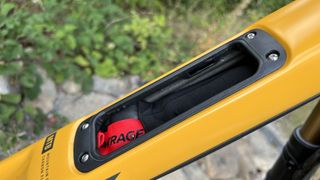
Components and build
The new (the EX5 uses the old frame) Fuel EX range starts with the alloy framed EX7 at £3300. The OCLV Mountain Carbon frames come in with the Shimano SLX/XT Fuel EX 9.7 at £4800 and then two Shimano (XT and XTR) and two SRAM wireless (GX and XX1) models top out with the £11,750 flagship tested here.
That gets you a full XX1 AXS wireless controlled group with superlight hollow carbon cranks and carbon cage rear mech, as well as the awesome Reverb AXS wireless dropper post. Brakes are SRAM Code RSC with 200/180mm rotors, too. The suspension is Fox Factory, with a 36 Float Grip2 fork and Float X air shock.
Trek house brand Bontrager fill the rest of the gaps with their super fancy £350 Race Shop Limited one-piece carbon cockpit with an effective stem length of 45mm and a massive 820mm width. They also supply the 27mm deep, 29mm wide, 1780g weight carbon fibre rim Line Pro 30 wheels with Rapid Drive 108 freehub giving a super quick 3.3º engagement. The tires are Bontrager SE5 too, with a Maxxis DHR style tread in a single 50 Duro ‘TM-Grip’ soft compound on 120tpi ‘Core Strength’ casings. Grips are Bontrager and the ‘Austenite’ railed saddle and mini tool that you can pull out of the fork steerer carrying Keith’s name.
That’s certainly an impressively top spec parade of kit, but complete bike weight is still higher than most of its competitors. Also, if you bought the frame and parts separately, even at full retail you’d be saving around £1200 compared to the complete bike cost.
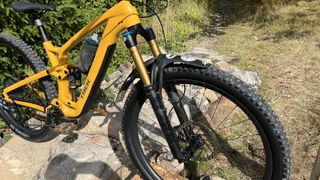
Ride, handling and performance
The good news is that whatever spec you can afford/justify the fundamentals and features of the new Fuel Ex are all the same and they’re extremely well sorted. I’ve only managed a day of testing on the bike so far, and the adjustable headset cups aren’t available yet, but I rode it far and hard enough to get deep into its many pros and the few cons.
First up the stock geometry is beautifully centred and balanced. It’s not a long bike, especially as the steep seat angle naturally pushes you forward but I never felt cramped or compromised. The massive bars and 64.5º head angle, with sticky tyres and my favourite Fox fork give the front end a huge amount of confidence even in first wet trails of the season conditions. If anything the deep rims, stout front end and stiff bar and stem combo are slightly too rich in feedback if you prefer a more forgiving softer ride. It’s definitely not as punishing and surgically efficient as the ultra precise Trek Slash 9.9 , though.
Despite being the same weight as its 170/160mm travel sibling in analogue SRAM X01 spec the Fuel EX keeps a distinctively playful feel as soon as you want to pop, hop or hip around the trails. The fast-reacting rear hub and efficient, minimal bob suspension action means it picks up speed far more easily than we expected for its relatively high weight . That gives it an infectiously effervescent feel that encourages you to hustle it along rise-and-fall trails much harder and faster than the significantly lighter but softer pedal- feel Canyon Spectral and Specialized Stumpjumper EVO . It sits just below the latest Santa Cruz Hightower in terms of stomp and go stability, but that means less kickback and traction disturbance when things get rough and random.
The easy stroke of the Float X shock means it blows through its travel with very little provocation in the default ‘less’ progression chip position and 30% sag. It still blew through more easily than I expected/wanted at 25% sag too, but switching the chip to the ‘more’ position improved things noticeably. Heavier riders/landers are going to want significantly more progression than that, however, so prepare to add volume spacers in the shock if that sounds like you.
If you’re tempted to go the coil route we’d definitely suggest something with plenty of natural mid-stroke support or even a progressive wound spring rather than a wallower like Fox’s DHX shock . While the 4mm wide sidewall tops add protection to the wheels and tires we’d be tempted to put an insert in the rear tire too. That’s because we regularly rimmed out the back wheel with a serious bang which is possibly due to the arcing, rather than rearward wheel path of the ABP pivot kinematic.
Once we’d found the shock sweet spot, though, the balance of neutral pedaling stability, cornering support, supple traction through turns or rock crawling up janky technical challenges was fantastic. In fact, the mix of ultra sensitive suspension ‘flutter’ and utterly planted authority gave me really sorted e-bike vibes on a regular basis. Because the suspension doesn’t have a specific agenda you can really concentrate on making the most of the excellent handling balance (that steep seat angle is a gift for climbing) and it loves to multiply whatever power and skill you can bring to the party. That meant even on a dead leg day it made short work of my most challenging local test trails in a consistently calm yet dynamically exciting, encouraging way, rather than just dull diligence.

It’s really early days in my relationship with the Trek Fuel EX, but aside from the complete bike pricing and the initially over-enthusiastic shock stroke , it’s clearly a brilliantly balanced all-rounder. It slides really well into the ready for anything slot between the Top Fuel and Slash in Trek’s range and feels like a sweet spot between the softest and sharpest feeling category benchmarks too.
While it’s heavy for the kit/competition and we’d question the wisdom of full carbon XC components on such a rugged ride, it also pops, climbs and plays as though it’s a lot lighter than it actually is. The lifetime warranty, plus increased adjustability and versatility potentially, will add significant dividends deeper into its lifespan and the for the development of your riding, too. I’ll be heading out on it again as soon as I post this review , which is always a very good sign of how much I’ve enjoyed riding it so far.
Tech specs: Trek Fuel EX 9.9 XX1 AXS
- Discipline: Trail/Enduro
- Price: £11,750
- Head angle: 63.5 - 66º
- Frame material: OCLV Mountain Carbon
- Fork material: Carbon fibre monocoque
- Size: XS, S, M, M/L (tested), L, XL, (XXL in alloy frames only)
- Weight: 14.59kg
- Wheel size: 29 x 2.5in
- Suspension: Fox Factory 36, Float GRIP2 fork 150mm travel, Fox Factory Float X 185mm x 55mm shock
- Components: SRAM XX1 Eagle AXS 12 speed rear mech, shifter and 30T SRAM XX1 chainset with DUB bottom bracket. SRAM Eagle XG-1299, 10-52, 12 speed cassette. SRAM Code RSC hydraulic disc brakes with 200mm front and 180mm rear rotors. Bontrager SE5 Team Issue 29 x 2.5in tires on Bontrager Line Pro 30, OCLV Mountain Carbon wheels. Bontrager RSL Integrated handlebar/stem 820mm bar and 45mm stem, RockShox Reverb AXS, wireless, 34.9mm seat post and Bontrager Arvada, Austenite rails saddle.
Guy Kesteven has been working on Bike Perfect since its launch in 2019. He started writing and testing for bike mags in 1996. Since then he’s written several million words about several thousand test bikes and a ridiculous amount of riding gear. He’s also penned a handful of bike-related books and he reviews MTBs over on YouTube.
Current rides: Cervelo ZFS-5, Specialized Chisel, custom Nicolai enduro tandem, Landescape/Swallow custom gravel tandem
Height: 180cm
Weight: 69kg
I've ridden SRAM's RED XPLR AXS groupset for hundreds of kilometers. Here's why I think it's the future of gravel gearing (and hopefully XC MTB too)
I tested Santa Cruz’s new Bronson XO AXS RSV to find out if it's still a party animal or a serious gravity machine?
The WTB Macro XC tire – will this race-ready rubber go straight to the front of the pack? I tested them to find out
Most Popular
- 2 GoPro launches its new Hero13 Black – here are the new features that every MTB rider will love
- 3 Fulcrum expands into trail riding with its new Metal Carbon and ALX wheelsets
- 4 Shimano RX801 gravel shoe review – a gravel racing specialist
- 5 Could Pace’s radical RC429 really be the one bike that does it all? The brand claims it's a trail, XC, adventure and gravel bike all-in-one, I put it to the test and the results really surprised me
- ELITE MEN’S AND WOMEN’S ENDURO RESULTS AND STANDINGS FROM LOUDENVIELLE, FRANCE
AMERICA’S RICHIE RUDE CLINCHES UCI ENDURO WORLD CUP TITLE
FLASHBACK FRIDAY: 37 YEARS AGO IN MOUNTAIN BIKE ACTION
- THROWBACK THURSDAY: TOBY HENDERSON RIDES AN EARLY FAT BIKE IN 1993
REVIEW: ONEUP THICK GRIPS – COMFORT AND CONTROL FOR BIGGER HANDS
- ARI BIKES UNVEILS THE SUPERIOR PEAK DOWNHILL BIKE
- UCI WORLD CUP DOWNHILL AND ENDURO RACING RESUMES THIS WEEKEND
- VIDEO: ‘HERE. THERE. EVERYWHERE.’ – MIRANDA MILLER DISCOVERS JESMOND PEAK BC
- LONG TERM REVIEW: YETI SB120 – BLURING THE LINES OF CROSS COUNTRY AND TRAIL MOUNTAIN BIKES
- FLY RACING JUMPS INTO 2025

TREK FUEL EXE REVIEW – NOT YOUR AVERAGE LIGHTWEIGHT ELECTRIC MOUNTAIN BIKE
Mid-power that’s anything but ordinary..

T here is a joke that one of MBA’ s wrecking crew would tell on occasion: “You know a trend is over when Trek gets on board with it.” It’s just a joke, but there is a bit of truth to it or it wouldn’t be funny. Trek is an innovative brand but has historically tended to move slowly and methodically instead of taking big chances. As a result, it rarely makes big mistakes, although early versions of the thru-shaft shock left some permanent stains on our shop floor. Well, that joke might not work anymore, because Trek’s new Fuel EXe mid-level-assist lightweight electric bike is as innovative, progressive and futuristic as they come.

DRIVE SYSTEM
German robotics manufacturer TQ and Trek have partnered to develop the Fuel EXe’s motor. This new motor system features a unique way to transfer its 50 Newton meters of torque and 300 watts of peak power to the drivetrain—a harmonic pin-ring transmission. Other brands’ motors use gears, belts or chains for gear reduction and power transfer. Trek claims that these transmission systems can fail and create noise, making the pin-ring design superior. This motor and transmission are smaller, too, allowing for the battery to be positioned farther down in the frame for a lower center of gravity. The HPR50 drive unit is completely designed and assembled in Germany while the rest of the system is made elsewhere in Europe.
Trek’s engineers spent a lot of time testing for noise output. Trek measured what it calls “tonality” or sound quality, not just total decibels. Some noises are more offensive than others. Trek claims that the Fuel’s EXe tests closer to a traditional MTB than the next quietest electric bike they tested. Trek says that the pin-ring design equals fewer moving parts and a much quieter ride.
Four total modes can be adjusted via the small handlebar remote: Eco, Mid, High and Walk. The three ride modes are tunable in Trek’s Central app. In the app, you can tune max power, assist level and pedal response. The app can also track activity, map rides, suggest or monitor tire and suspension pressure, and get real-time range calculations. A 2-inch display screen located on the top tube shows mode, battery life and other ride metrics at a glance. Trek says the remote and display weigh just 60 grams. The system is also compatible with most Bluetooth or ANT+ cycling computers (like Garmin) in case you want to tie that in as well. Headlights can also be powered off of the main battery via a power splitter that resides in the top tube.
The removable 360Wh battery allows for what Trek claims is two to five hours of real singletrack riding. A 160Wh extender pack that goes in the bottle cage is available as an accessory and offers an additional one to two hours of riding. It is also worth noting that since the battery is removable, you can fly with it, and because the range extender is below some airline’s thresholds of banned capacity, you might be able to fly with the extender in your carry-on. And yes, the bike can be powered with just the extender pack.
With this drive unit system, the bike is about 10 pounds lighter than a comparable full-power electric mountain bike and about 10 pounds heavier than a regular, non-electric version.

At a casual glance, the Fuel EXe’s frame looks like a normal mountain bike frame. That’s because the downtube on the full-carbon Fuel EXe frame is 39-percent smaller than Trek’s Rail eMTB, making it only a little bit bigger than the non-electric-assist Fuel EX’s downtube. Trek claims that the smaller motor allowed for no compromises in frame geometry. As a result, it has normal trail bike-oriented 440mm chainstays, a 65-degree head angle, a 77-degree seat tube angle and a 485mm-long reach in a size large. It’s adjustable, too, via a flip chip in the seatstays. Because of the flip chip, the Fuel EXe is mullet convertible for anyone wanting a more agile bike or more rear-wheel-to-body clearance. A full-size water bottle fits in all frame sizes, except for size small, which only fits a 20-ounce bottle.
There are eight Fuel EXe builds available, starting at $6500 for the 9.5 with a Shimano Deore drivetrain. We tested the highest-end Fuel EXe 9.9 XX1 AXS build, which costs only $14,000. Yes, we are being sarcastic about the “only” part, but this bike comes with top-drawer components, such as a SRAM XX1 Eagle AXS drivetrain wired to the bike’s battery and an AXS Reverb dropper post. Other highlights include e*thirteen e*spec Race carbon cranks; Bontrager Line Pro 30 carbon wheels with SRAM AirWiz for easy tire pressure setup or monitoring; and SRAM Code RSC brakes with thicker, eMTB-friendly, 200mm HS2 rotors. It’s also available in Project One for riders who want to customize their paint and parts.

Trek continues to utilize its excellent ABP rear suspension design to get 140mm of rear wheel travel on the Fuel EXe. This four-bar design puts the rear pivot concentric with the axle as opposed to just in front of it as with a Horst-link FSR design. Our test bike comes with a RockShox Super Deluxe Ultimate with AirWiz. The fork is a 150mm-travel RockShox Lyrik Ultimate that also features AirWiz. Utilizing SRAM’s AirWiz app, riders can easily set and monitor air pressures. According to Trek, the Fuel EXe is also coil-shock compatible.
Ascending on the Fuel EXe is unlike anything we have tried. Its assist power is ultra smooth, and the motor hardly makes any sound at all. It’s so quiet, in fact, that even in High mode it’s hardly audible over the sound of the tires going over the dirt. Vibrations through the pedals are equally muted. In Low mode, it’s like riding with a strong tailwind everywhere. Mid and High modes have some power, but the motor is not blessed with lots of torque. It feels more like a rush of speed than punchy acceleration.
Even with all settings maxed, we found ourselves running out of steam on ultra-steep climbs where other mid-powered bikes made it all the way up the hill. We were forced to put in a fair amount of effort to make the impossible (on a mountain bike) happen. At first, we thought the motor just didn’t have as much punch as others, but after a few rides, we realized that the motor was just reducing power as it got hot. The TQ drive unit has a strong sense of self-preservation. Watching the power output on the display, it would go from putting out around 300 watts at the start of a ride to never going above 200 watts later, no matter how hard we pedaled. Trek says that while riding in the high-power mode, derating can occur under certain circumstances. They say this happens in small steps and only as much as is absolutely necessary to maintain the prescribed maximum surface temperatures of the engine. Trek adds that derating has no influence on the lifetime of the motor.
Suspension performance while climbing is superb. The supple rear suspension lets the rear tire claw at the ground, yet stays neutral under power, resisting excessive movement or bob. And for those who intentionally or unintentionally ride with the motor off, this is one of the best e-bikes we have experienced in terms of motor drag or friction. Compared to other e-bikes, drag is non-existent and closer to that of a gearbox mountain bike than electric assist. Between the lighter eMTB weight and the lack of drag, the Fuel EXe is simply a pleasure to climb on.

The same light weight that makes this bike climb well makes an even bigger impact on the descents. It lays into corners much like a regular bike. You only realize that it’s about 10 pounds heavier when you overcook a corner or start getting in over your head in rough sections. It has a seemingly low center of gravity that keeps the bike light on its feet and makes it feel more like a 36-pound bike than a 41-plus-pound bike. It’s not until you try to hop the rear end up that you really feel the weight, and even then it’s a lighter feeling than full-powered eMTBs. It’s super quiet, too. There are no rattles or other noises to speak of.
Once again, the suspension really impressed the wrecking crew with its composure when pushing hard. There is no need for volume spacers or heavy tweaking to get great action. We set sag, followed Trek’s recommended settings in its app, and rode. Geometry is dialed, too, with solid trail-bike handling in every condition. Even though this is a trail bike, it punches well above its class.
WHAT DID WE LOVE?
Coming off of other eMTBs, the lack of noise and vibration is mind-blowing. It looks very much like a regular mountain bike, too, with its svelte downtube and motor area. The handlebar switch is small yet easy to use. It’s what we wish were on other bikes. The display is bright and easy to see, but best of all it comes with useful information, such as a power countdown timer that reverses when you charge it. Our favorite screen is the power output display that shows your wattage and the motor’s at the same time. Even with the small battery, range is good. We still had battery left after two-hour-long rides with 2000 feet of climbing and the power on High the entire time. With battery management and more effort, we could go much longer.
WHAT DID WE HATE?
As one would expect from a bike costing this much, there is very little we would upgrade. The first two riders who got on the EXe got rear flats in the tread area on their first rides. It’s hard to say if it was a tire durability thing or if the stoke of riding an electric bike this light had us pushing a bit harder than usual. About 2–3 psi more than usual took care of the problem. We might suggest a lightweight tire insert or a heavier tire casing if it were a long-term issue. A few test riders had issues with the integrated Bontrager bar and stem. They didn’t like the rolled-forward feel of the bars. Truthfully, the bars are level, but those riders prefer to have their bars rolled back slightly.
We didn’t love the thermally triggered reduction in power, but it’s not a deal-breaker. Reducing power when you need it most made for a few hike-a-bikes or big efforts where other mid-powered eMTBs made the grade. The good news is that Walk mode works well; the bad news is that the pressure required on the switch to maintain Walk mode on longer hikes made our thumb cramp.

BOTTOM LINE
This is truly a game-changing mountain bike. Its silence and overall feel are closer to that of a regular mountain bike than any electric-assist we have tried—and by a pretty wide margin. As incredible as this bike is, it’s not for everybody. Power-drunk riders who rely on high levels of assist on full-power bikes will be disappointed with both the output and range. This is a mountain biker’s electric bike. It’s for those who still want to put in effort, yet want to go longer and steeper than their mountain bike will allow or those who want the lightweight, playful feel that’s missing from full-power bikes. Trek claims that the Fuel EXe removes the divide between MTB and eMTB. This is one of the few times that marketing hype might actually live up to its claim. The Trek Fuel EXe is not just a minor advancement, it’s a quantum leap into the future that sets the bar for all mid-powered electric bikes to come.
CATEGORY: eMTB-Trail
WHEEL SIZE: 29″
SUSPENSION: 150mm (front), 140mm (rear)
TREK FUEL EXe 9.9 XX1 AXS
www.trekbikes.com
Price: $1,3999
Weight: 24.6 pounds (with bottle cage, no pedals)
Sizes: S, M, L (tested), XL
Frame tested: 140mm travel, carbon
Motor: TQ-HPR50, 300 watt, 50 Nm
Battery: TQ 360 Wh
Controller: Bar switch, TQ LED display with Bluetooth & ANT+ connectivity
Shock: RockShox Super Deluxe Ultimate AirWiz, RCT2 damper
Fork: RockShox Lyrik Ultimate, AirWiz, Charger 3 RC2 damper, 150mm travel
Wheelset: Bontrager Line Pro 30, OCLV Mountain carbon
Tires: Bontrager SE5 Team Issue, 29×2.50’”
Seatpost: RockShox Reverb AXS, 100mm (S), 150mm, (M), 170mm (L, XL)
Saddle: Bontrager Arvada
Handlebar: Bontrager RSL integrated handlebar/stem, OCLV carbon
Grips: Bontrager XR Trail Elite
Brakes: SRAM Code RSC 4-piston
Rotors: SRAM HS2 200mm F/R
Rear derailleur: SRAM XX1 Eagle AXS
Shifters: SRAM Eagle AXS, wireless, 12-speed
Crankset: E*thirteen E*spec Race carbon, 165mm
Cassette: SRAM Eagle XG-1299, 10-52, 12 speed
Chain: SRAM XX1 Eagle, 12 speed
Chainrings: 34-tooth
Head tube angle: 65.5-65°
Reach: 490-485mm (19.3–19.1″)
Stack: 623–627mm (24.5–24.7″)
Effective seat tube angle: 77.5–77°
Bottom bracket height: 349–342mm (13.7-13.5″)
Chainstay length: 438–440mm (17.2-17.3″)
Wheelbase: 1,245mm (49″)
VIDEO: ‘HELPER OF THE PEOPLE’ LEO SMITH FINDS HIS FLOW IN LANDOSTEEZY
VIDEO: CHRIS AKRIGG RIDES WHYTE – GOING BEYOND, EPISODE 1
ELITE MEN’S AND WOMEN’S ENDURO RESULTS AND STANDINGS FROM LOUDENVIELLE,…
TALKING DIRTY WITH SEPP KUSS – LAST YEAR’S VUELTA A ESPAÑA WINNER EXPOSES…
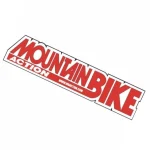
mountainbikeaction
- Since 1986 - Covering All Aspects of ⛰🚲 #MBAmagazine

- Bike Builds
- Cross Country Bikes
- Downhill Bikes
- Enduro Bikes
- Hardtail Bikes
- Trail Bikes
REVIEW: STAN’S FLOW MK4 WHEELS WITH M-PULSE HUBS
FOX TRANSFER NEO WIRELESS DROPPER SEATPOST REVIEW
CANNONDALE TRACT HELMET REVIEW
VIDEO: KRISS KYLE BLURS THE LINES OF BMX AND MTB IN ‘DREAMLINE’
VIDEO: VICTOR KORETZKY’S MISTAKE THAT LET TOM PIDCOCK WIN OLYMPIC GOLD
VIDEO: BC INTERIOR FREERIDING WITH THE VAN STEENBERGENS AND OTHERS IN “MIXED…
RACE REPLAY: ROUND 3 OF THE MONSTER PRO DOWNHILL SERIES FROM SNOW SUMMIT
ASK MBA: IS COIL SPRUNG SUSPENSION WORTH THE EXTRA WEIGHT?
ASK MBA: HOW DO I FIGURE OUT MY MOUNTAIN BIKE’S IDEAL BRAKE HOSE LENGTH?
ASK MBA: IS IT EVER OK TO CLAMP A BIKE AT THE FRAME IN A WORKSTAND?
ASK MBA: WHY DOES MY NEW TIRE WOBBLE ON A PERFECTY TRUE RIM?
MOUNTAIN BIKE SETUP 101 – A BEGINNERS GUIDE TO DIALING IN YOUR NEW RIDE
FINDING THAT ELUSIVE CREAK
HOW TO INSTALL A TUBELESS TIRE AT HOME WITHOUT A COMPRESSOR
INTERNAL ROUTING THE EASY WAY – CHEAT CODES FOR CABLE AND HOSE ROUTING
BIKE CHECK: ERIC PORTER’S DIAMONDBACK YOWIE
INSIDE THE PROS’ BIKES WITH MATHIEU VAN DER POEL
BIKE CHECK: MARK WEIR’S VERY CUSTOM CANNONDALE MOTERRA
BIKE CHECK: BRYN ATKINSON’S PIVOT SHUTTLE LT E-BIKE
- Mountain Bike Action
- Digital Mountain Bike Action
- Back Issues
- NICA Team of the Month
- B’s Buzz
HOW AN INNER CITY PUMP TRACK IS CHANGING LIVES IN LOS ANGELES
10 REASONS TO RIDE SKYPARK
MASTER BIKE BUILDERS SHOW IS RETURNING TO BENTONVILLE IN SEPTEMBER
DESTINATION: CAPPADOCIA, TURKEY – ICY TRAILS AND FAIRY TALES
USA WINS GOLD AND SILVER IN THE U23 SHORT-TRACK RACES AT THE WORLD CHAMPIONSHIPS
USA CYCLING ANNOUNCES 2024 MOUNTAIN BIKE WORLD CHAMPIONSHIPS TEAM
MONSTER ENERGY PRO DOWNHILL: FINAL RESULTS & TIMING DETAILS (UPDATED)
MONSTER ENERGY PRO DOWNHILL, BIG BEAR, CALIFORNIA: SEEDING RESULTS
PHOTO GALLERY: THIS MONTH’S BEST READER SUBMITTED PHOTOS
PHOTO GALLERY: OUR FAVORITE READER SUBMITTED PHOTOS
READER SENDS: THIS MONTH’S BEST READER-SUBMITTED PHOTOS
READER SENDS – THIS MONTH’S BEST READER SUBMITTED PHOTOS
- Anneke’s Blog
- Down The Trail
- Fuel EX AL Frameset
Shop in-store for even more deals!
Shop in store for even more deals we can't advertise!
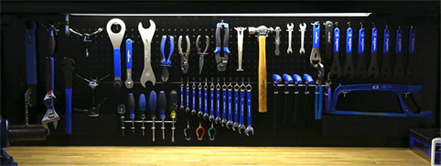
Mountain Bike Suspension Service
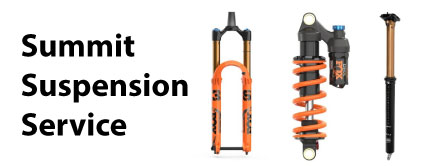
Trade In Your Bike

- Base Layers
- Mountain Bike Shorts
- Bibs, Tights + Knickers
- Mountain Bike Shoes
SAFETY GEAR
- Adult Helmets
- Youth Helmets
- Road Helmets
- Casual Wear
- Road Bike Shorts
- Bibs, Tights & Knickers
- Road Bike Shoes
- Accessories/Parts
Safety Gear
- Women's Helmets
- Road Bike Helmets
- Mountain Bike Helmets
WHEELS & TIRES
- Road Wheels
- Mountain Bike Wheels
- Mountain Bike Tires
- Wheels Accessories and Parts
- Derailleurs
- Chains & Cassettes
- Cranks and Chainrings
- Bottom Brackets
- Cables and Housing
- Power Meters
BRAKES & PEDALS
- Clipless Pedals
- Flat Pedals
- Mountain Bike Brake Sets
- Mountain Bike Brake Pads
- Road Bike Brakes and Pads
- All Brakes/Levers/Pads
Forks & Cockpit
- Grips and Bar Tape
- Rigid Forks
- Suspension Forks
Accessories
- Car Rack Accessories
- Electronics
- Front Lights
- Tail Lights
- Locks/Security
- Media/Resources
- Bicycle Mounted Racks
- Pumps/Inflation
- Tools/Maintenance
- Trailers/Strollers
- Trainers/Rollers
- Travel/Storage
- Water Bottles & Cages
Brand Guides
Bike buyer's guides, gear guides, new bike releases, summit bicycles online (855) 245-3663 [email protected] email, burlingame (650) 343-8483 [email protected] email, summit outfitters (408) 878-3252 [email protected] email, los gatos (408) 399-9142 [email protected] email, san jose (408) 264-2453 [email protected] email, palo alto (650) 304-0035 [email protected] email, summit bicycles mobile we'll come to you schedule mobile service today, (855) bike-one - for online orders and rental inquiries.
- Account Account
- Subtotal : $ 0.00 Checkout Cart
- Bicycling Catalog
- Mountain Frames
- Fuel EX C Frameset Gen 6
Trek Fuel EX C Frameset Gen 6

Fuel EX C Frameset is a light and ready frameset that's only limit is your imagination. It's constructed from lightweight, vibration-damping carbon fiber for a ride that's stiff where you want it and compliant where you don't. Its engineered for the trail with progressive geometry that stretches out the front-end for more control on descents, and gets steeper in the rear for better pedaling efficiency. You want a carbon frame that you can build up however you dream. You care about having the most progressive geometry that can handle anything on the mountain, and want to keep things lightweight. A premium carbon frame that damps vibrations and is ready to take on any trail. Internal cable routing to protect hoses and simplify setup. A FOX Performance Float X rear shock that makes quick work of small bumps, and smooths out gnarly descents. Adjustable geometry that lets you control your headtube and seatube angle. Fuel EX C Frameset is a lightweight carbon ride that's evolved for the trail. Its modern trail geometry keeps descending confident and climbing lively. In-frame storage lets you keep your tools tucked away on the trail, and adjustable geometry gives you total control of the ride. - You get a high-end carbon frame that's light and lively on the trail, and can be built up with all of your favorite components - It features modern geometry that's ready for steep and loose descents, and hammering up climbs - With the adjustable angle headset (angled cups sold separately) and Mino Link, you can choose from six different geometry configurations - You'll have all the space you need for your treats and tools with new in-frame storage Wheel size: - Sizes X-Small – Small: 27.5-inch - Sizes Small – X-Large: 29-inch
Due to supply-chain issues, specs are subject to change without notice.
* Subject to change without notice.
Part Numbers
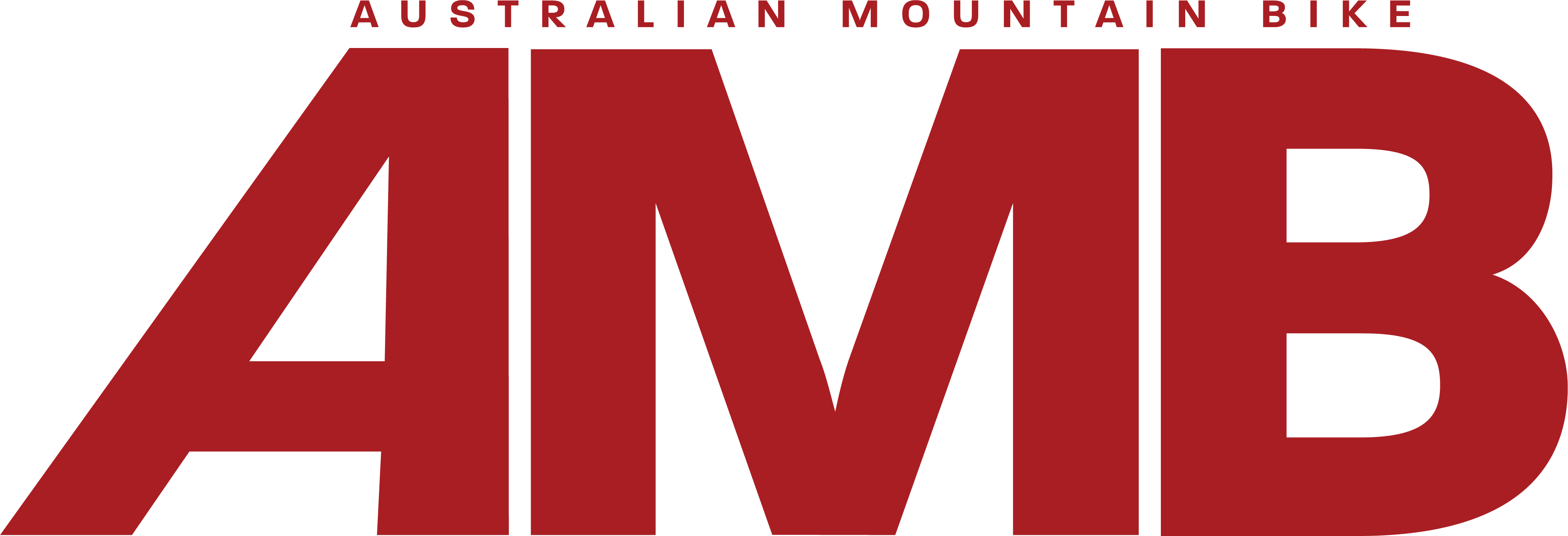
- Photo Awards
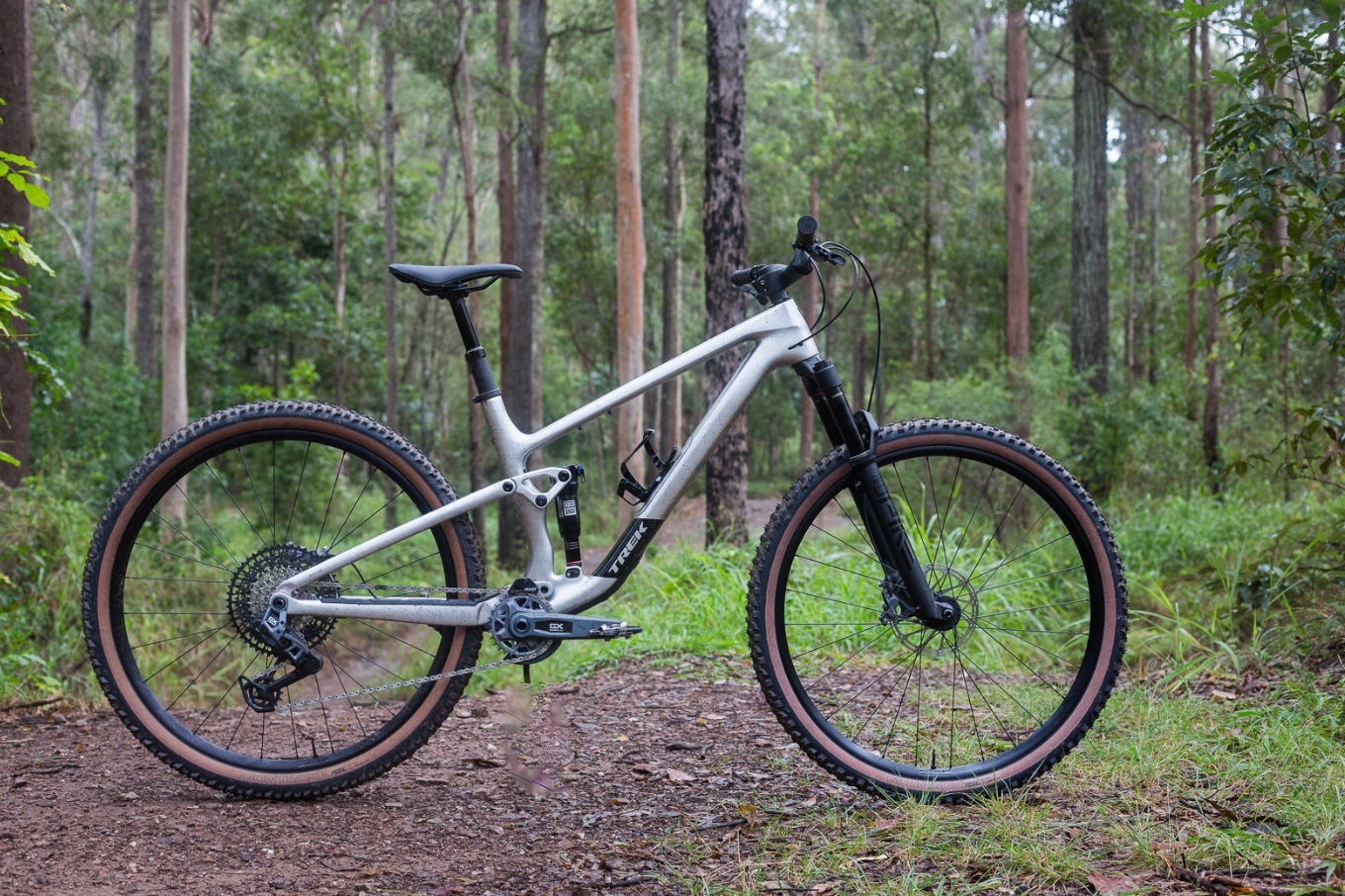
Trek Releases New Top Fuel
Word & Photos Mike Blewitt
The Top Fuel has been a marquee model in the Trek mountain bike range for a couple of decades. Relaunched in 2015, the Top Fuel was a World Cup cross-country race weapon, piloted by the likes of Dan McConnell on the Trek Factory Racing team. In 2019 the Top Fuel had a major rethink, as Trek morphed the 100mm travel 29er XC bike into a more capable 120/115mm travel 29er platform to suit all-day adventures and the broad remit that a light
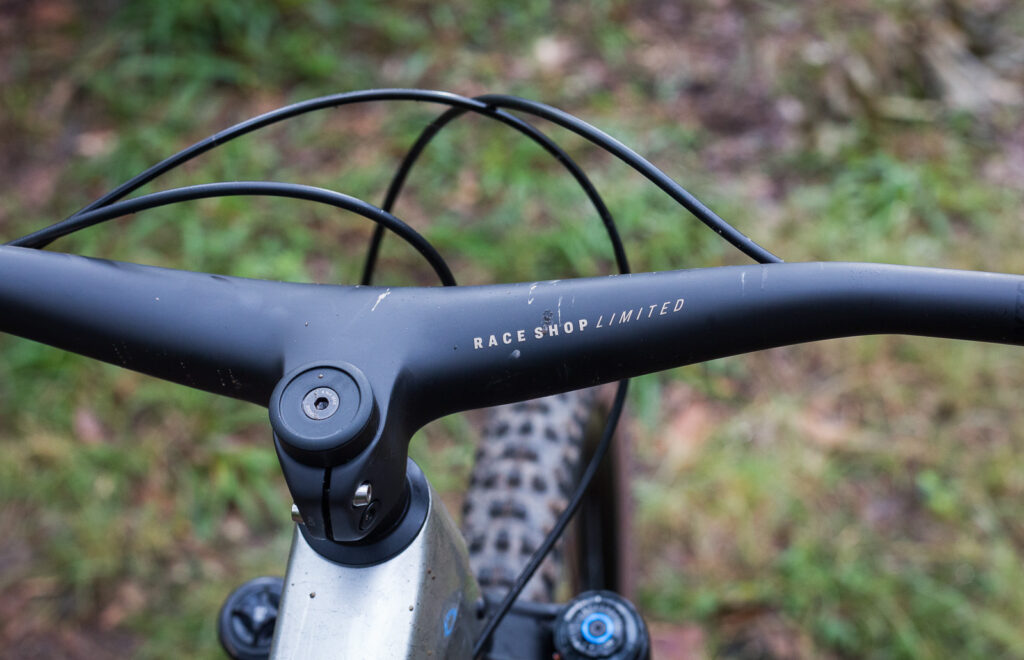
Trek have just released the fourth generation of the popular Top Fuel mountain bike. Have been reborn in 2015 as a World Cup race rig, the Top Fuel morphed into a short travel trail bike in 2019, with further refinements in 2022 until we see the latest iteration which has just been released for 2025.
Suspension on the Top Fuel
The latest Top Fuel has a 130/120mm travel mix front to rear, but the bolstered frame can be upgraded to a 140mm fork, and a longer stroke rear shock can deliver 130mm of rear travel. Borrowing from the Trek Fuel EX, the lower shock mount allows the rider to run the standard progression or a more progressive setting to allow for better support on bigger hits or at high speed. Trek also house their MinoLink settings in this same area, with four positions available between a high and low setting, with more progression or less.
The Top Fuel has slightly better anti-squat as well, for better punch out of the saddle when accelerating into trail features or attacking a pinch climb. The same ABP rear pivot is used on the frame design.
Frame features
First and foremost, we like that Trek have kept the headset free of anything except headset bearings. Cable outer and hoses enter the frame behind the head tube, allowing for less maintenance in the long term, and more freedom of movement when packing your Top Fuel for a mountain bike trip.
The frame storage has had some small changes, but overall it is far smaller than something like the SWAT storage on Specialized’s Epic 8 EVO – another 130/120mm 29er that is made to party.
Trek have an accessory mount under the top tube, a single bottle cage placement, plenty of standover, and the ability to run the frame as a mullet (MX) configuration with a 27.5” rear wheel – if you keep the bike in the high setting.
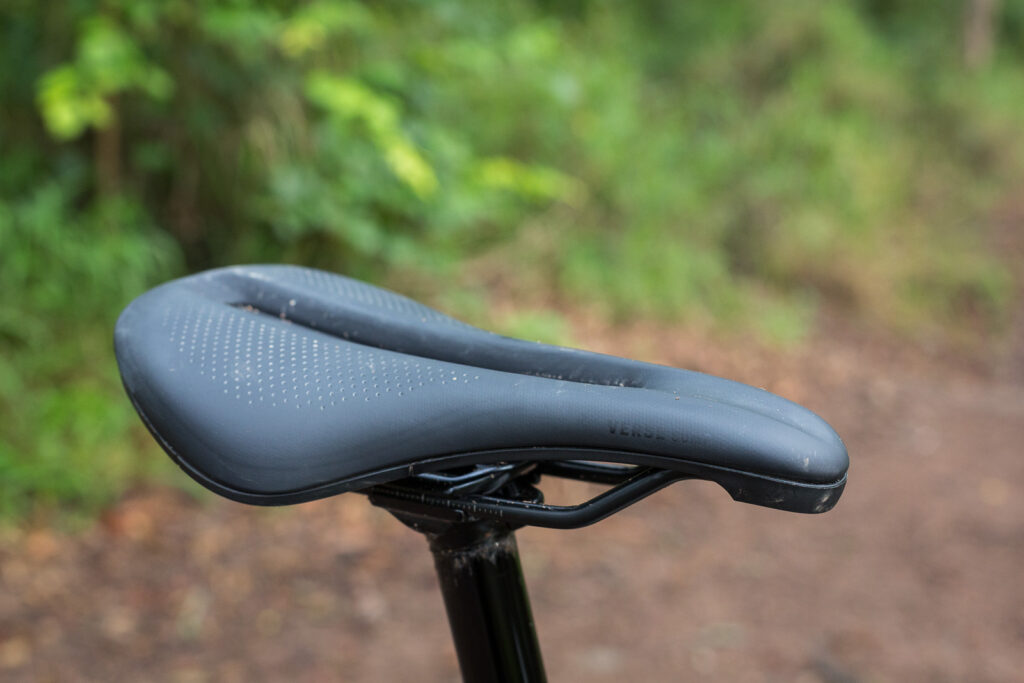
There are no huge changes in terms of geometry, with a 65.5 degree head angle and 76 degree seat angle. The reach on our large test bike is 477mm, and chain stays are 440mm. Ewhat is new is that Trek are offering size specific chain stays on the Top Fuel with three lengths between the small and XL frame sizes. This is a great move, as it assists in keeping the handling consistent – no matter your size.
Trek have aluminium and carbon models of the Top Fuel, and we have the 9.8 GX Transmission model on test. With a SRAM GX Transmission group set, RockShox Pike Select+ fork and Deluxe Ultimate RCT shock, it has the major areas sorted out. Bontrager provide the Line Comp 30 wheels, Gunnison and Montrose tyres, beautiful RSL none-piece cockpit, 34.9mm dropper post and plastic dropper lever. It’s great to see Trek send their bikes out ready to be setup tubeless, with valves fitted and a bottle of sealant with the bike. It couldn’t be easier to get rolling!
Our test bike clocked in at 13.31kg before pedals were fitted.
The Top Fuel range starts at XXXX for $XXXX and runs through to the XXXX for $XXXX.
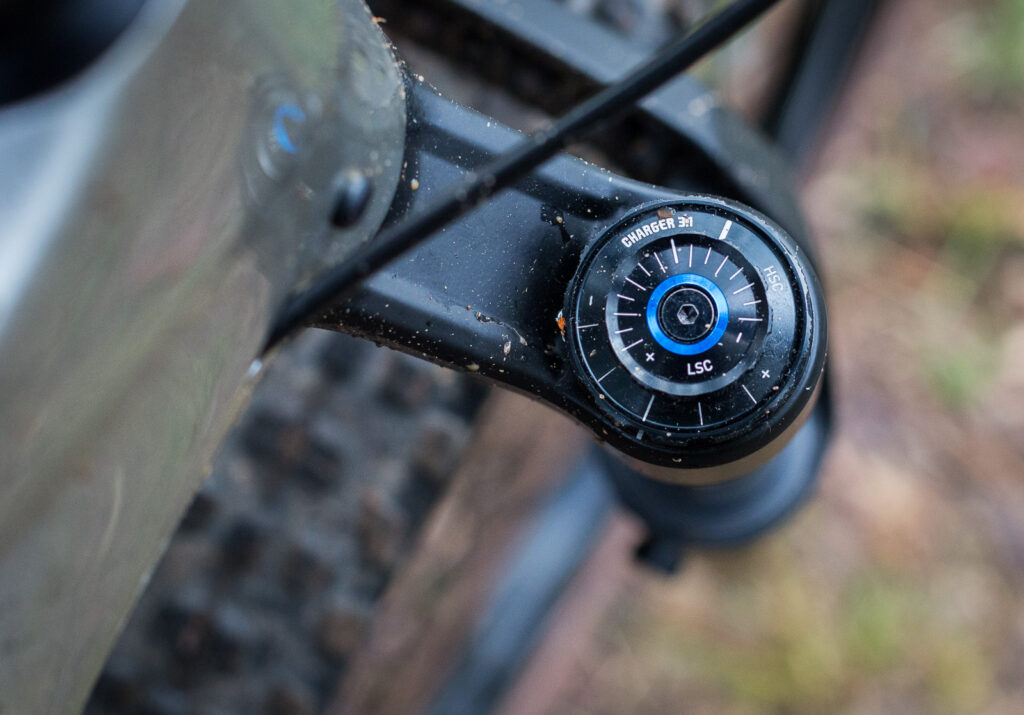
First ride feedback
Given the last Top Fuel I rode was the 2015 model on my Buck’s Weekend – I did not expect anything to feel the same. I thoroughly enjoyed the Specialized Epic 8 EVO I tested earlier this year, which I expected the Top Fuel to mirror on the trail.
But I couldn’t have been more wrong.
While the Epic EVO is a souped up XC bike with burlier suspension and tackier tyres on the same frame ridden in the World Cup, the fourth generation Top Fuel goes head to head with it as a ground up short travel trail bike design. When I build the bike I was sceptical about the tyres, as they are some of the new Bontrager models that visually don’t have the heft I expected. With the silver/grey bike built up it reminded me a lot of the Norco Optic I tested in Autumn 2020. And a lot has changed since then.
On the trail, this all changed. I found the Top Fuel pedalled very efficiently for the bike type, and I only firmed up the shock on the smoothest of fire road climbs. But it was descending and moving at speed where the bike told me it was a trail bike, and not a long-travel XC bike. It feels much more balanced in rockier terrain, or on the inevitable casing of doubles which I seem to subject test bikes to. Visually, the back end looks more robust and with greater tyre clearance than something like an Epic EVO as well.
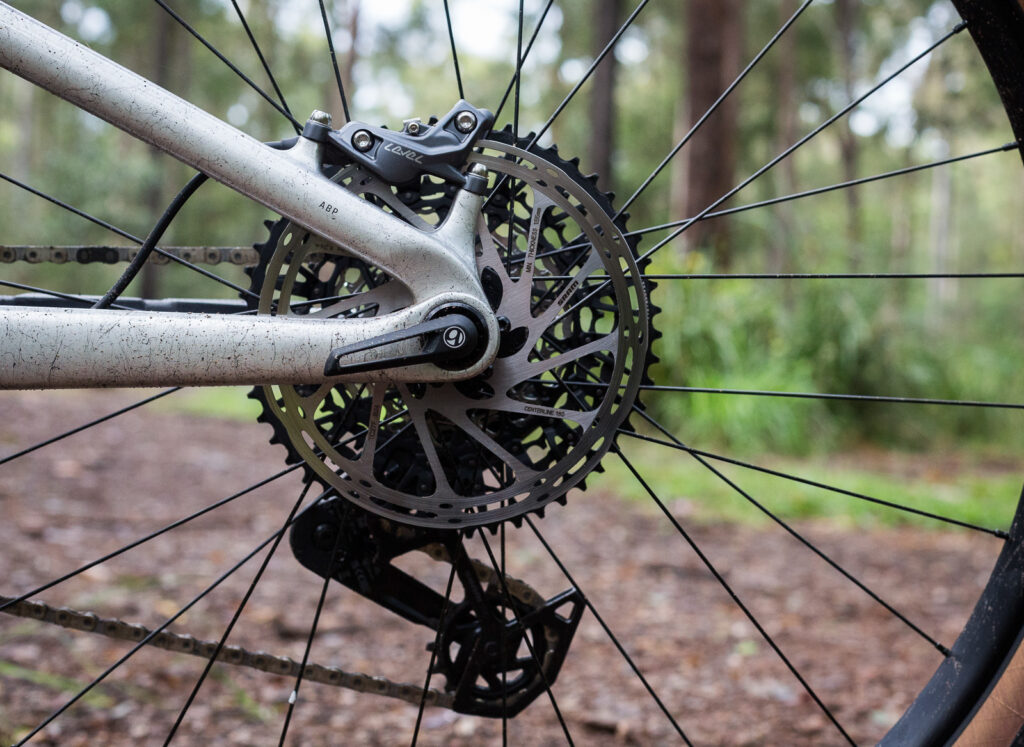
Having built the bike the night before and set it up in the carpark, I was far more impressed than I imagined I would be. I’ve got some more riding to do before completing a review, but I think Trek have made sure the Top Fuel is the perfect fit between the latest Supercaliber and the Fuel EX – and I think it may even suit those who miss the previous generation Fuel EX, by all accounts a true mountain bike.

- dual suspension
- trek top fuel
You might also like
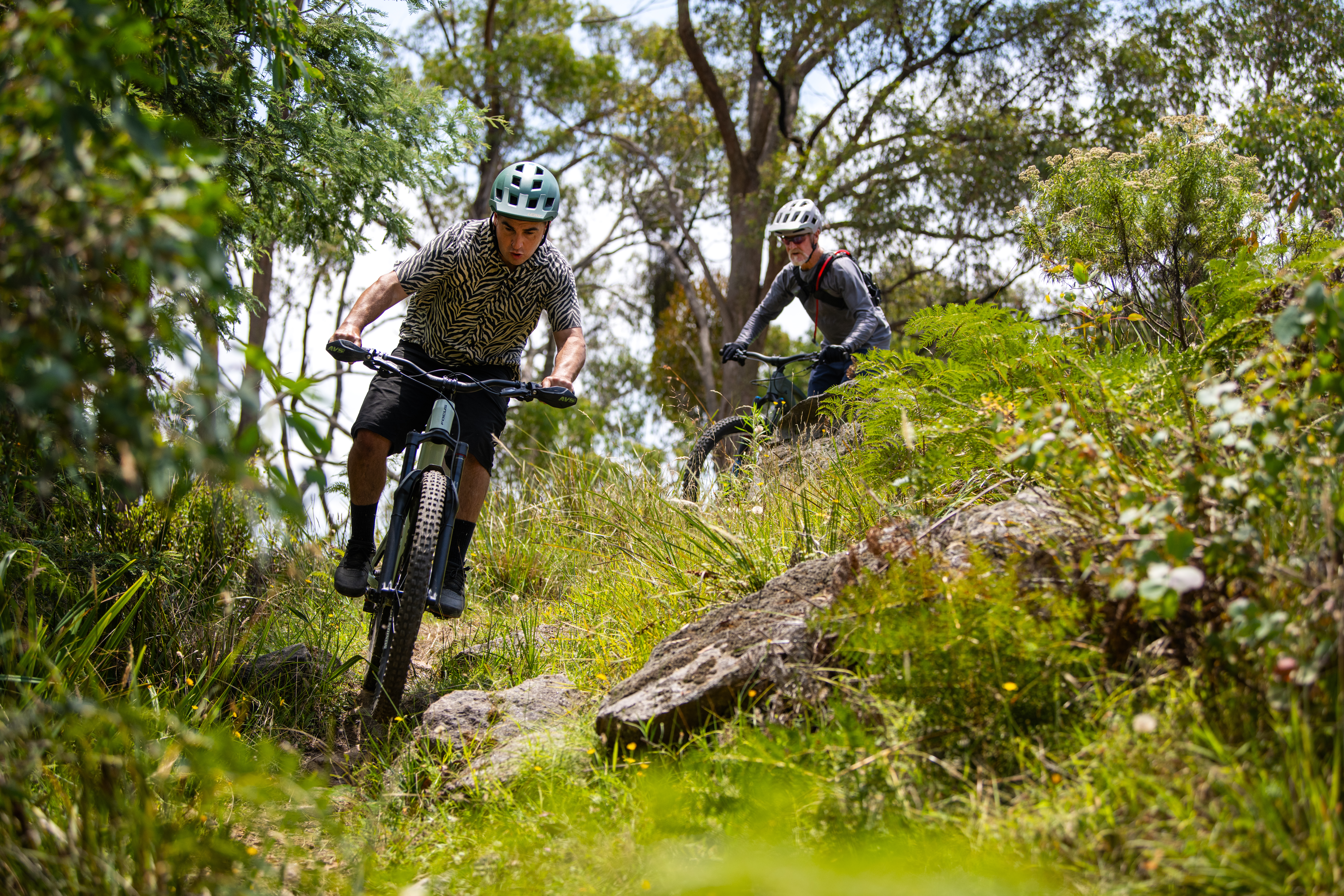
Mount Beauty Australia is a Must-Visit for Mountain Biking Trips
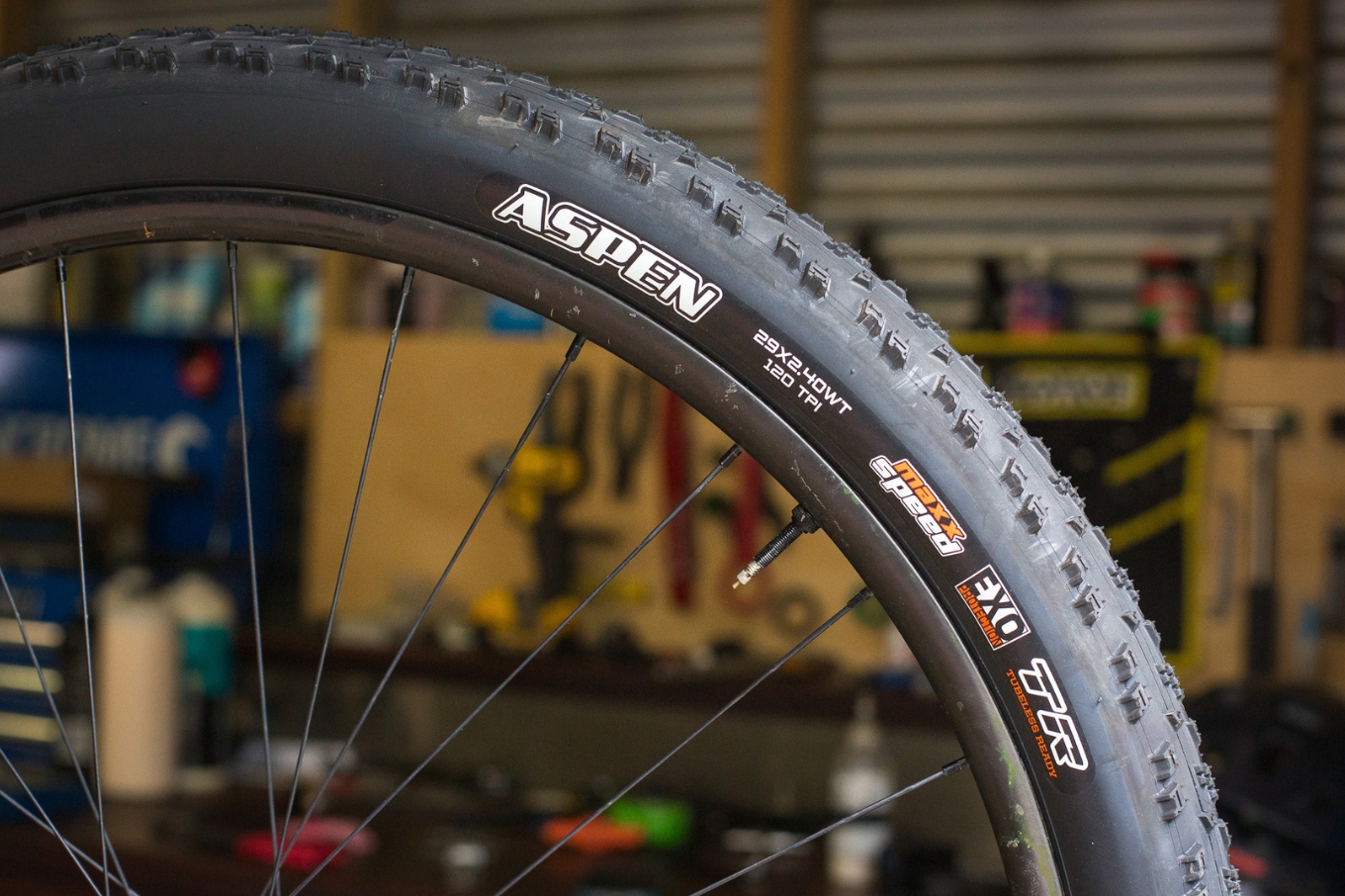
Buyers Guide: 4 Maxxis Cross Country Tyres for 2024

How to service cartridge bearings
More feature articles.
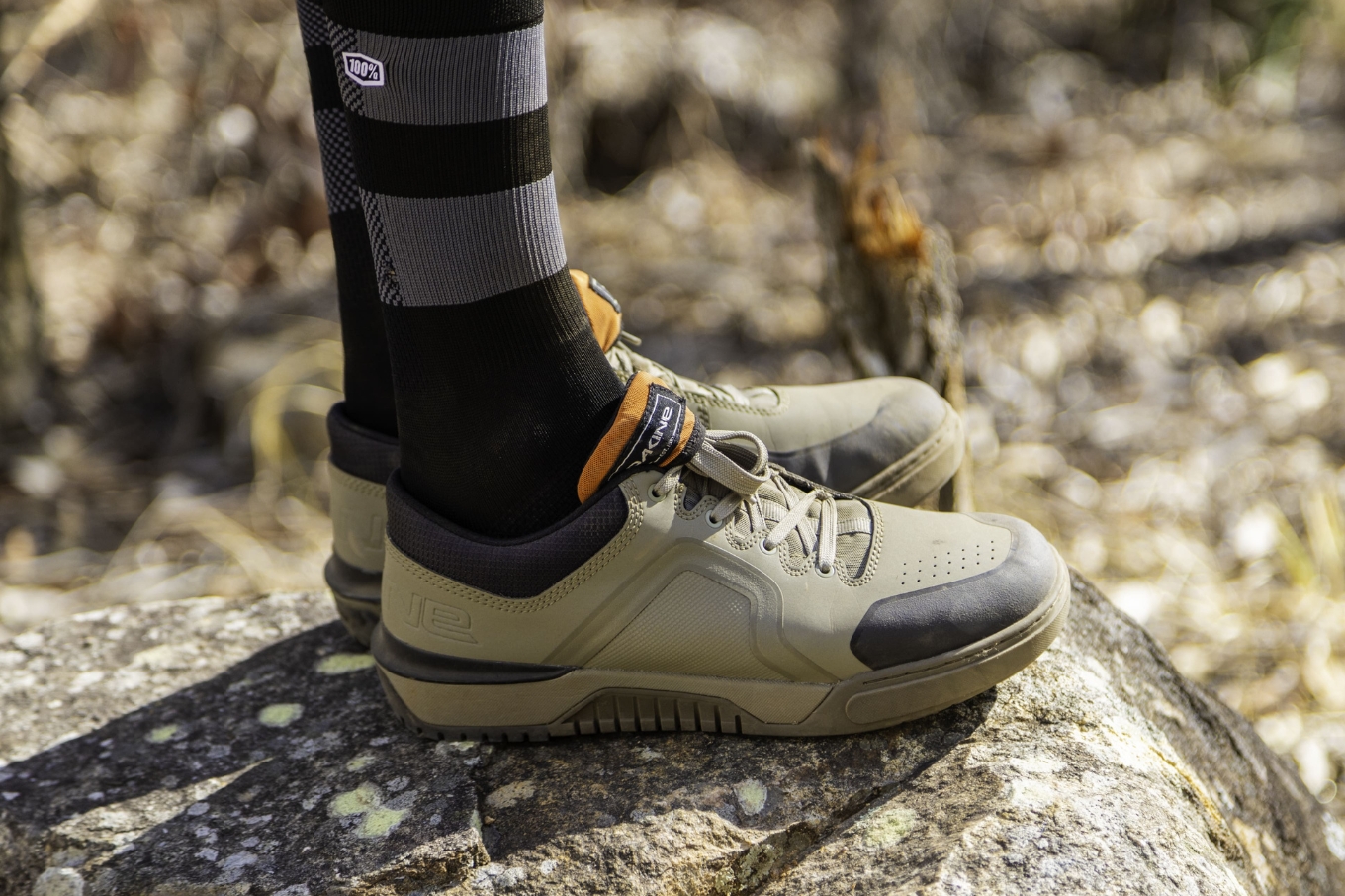
Dakine Drift shoes
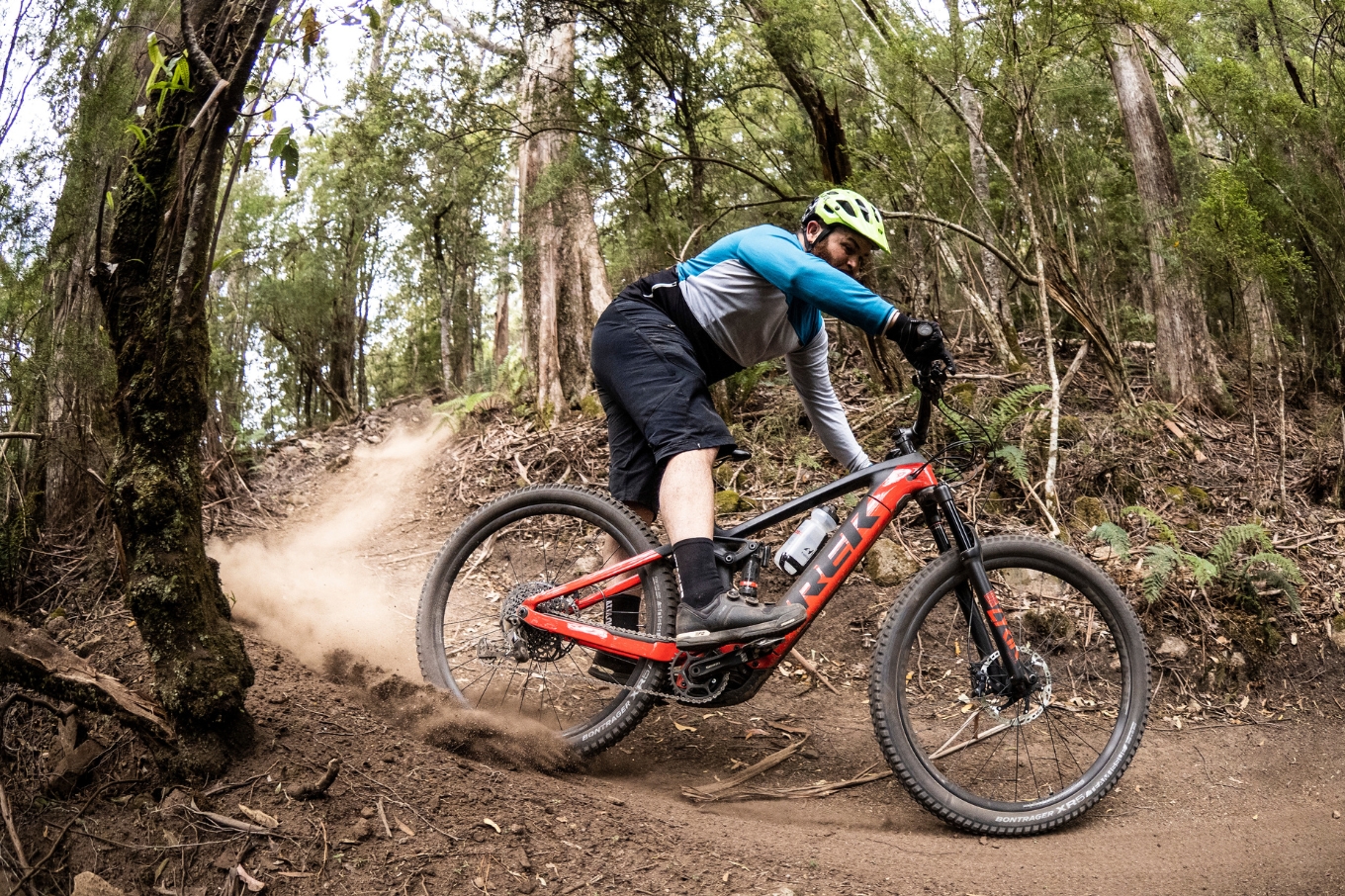
How To Travel With Your E-bike
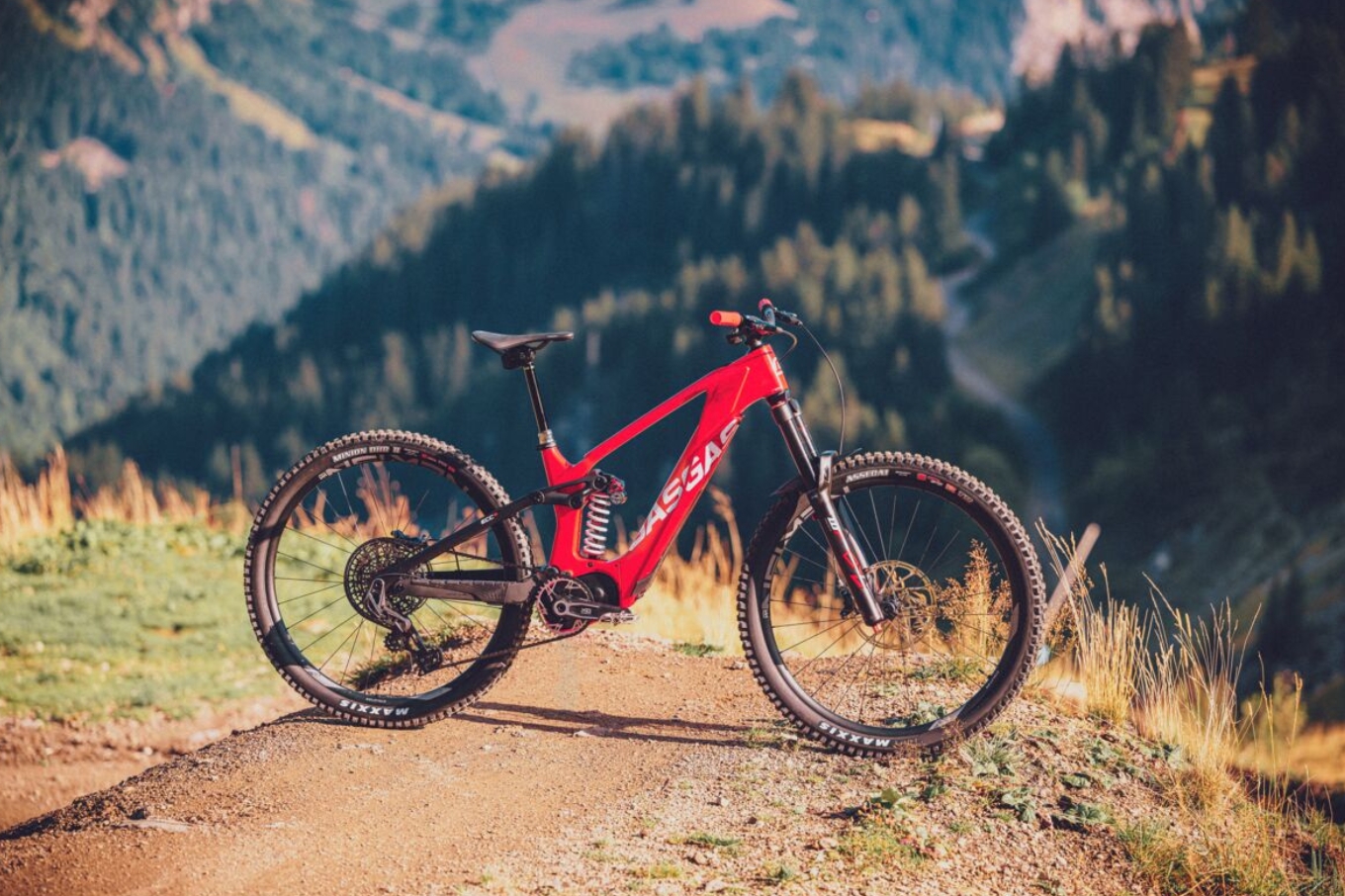
Gas Gas MXC 5
- World Atlas /
- Western Siberia /
- Omsk Oblast /
- Area around 55° 11' 31" N, 73° 10' 30" E /
- Detailed maps /
Detailed Road Map of Omsk
This is not just a map. It's a piece of the world captured in the image.
The detailed road map represents one of many map types and styles available. Look at Omsk, Omsk Oblast, Western Siberia, Russia from different perspectives.
Get free map for your website. Discover the beauty hidden in the maps. Maphill is more than just a map gallery.
- Free map
- Panoramic 4
The default map view shows local businesses and driving directions.
Terrain Map
Terrain map shows physical features of the landscape. Contours let you determine the height of mountains and depth of the ocean bottom.
Hybrid map combines high-resolution satellite images with detailed street map overlay.
Satellite Map
High-resolution aerial and satellite imagery. No text labels.
Maps of Omsk
This detailed map of Omsk is provided by Google. Use the buttons under the map to switch to different map types provided by Maphill itself.
See Omsk from a different perspective.
Each map type has its advantages. No map style is the best. The best is that Maphill lets you look at each place from many different angles.
Sure, this road detailed map is nice. But there is good chance you will like other map styles even more. Select another style in the above table. See Omsk and Western Siberia from a different view.
What to do when you like this map?
If you like this Omsk, Omsk Oblast, Western Siberia, Russia map, please don't keep it to yourself. Give your friends a chance to see how the world converted to images looks like.
Share this detailed map.
Use the buttons for Facebook, Twitter or Google+ to share a link to this road map of Omsk. Maphill is the largest map gallery on the web. The number of maps is, however, not the only reason to visit Maphill.
Get detailed map of Omsk for free.
You can embed, print or download the map just like any other image. All Omsk and Western Siberia maps are available in a common image format. Free images are available under Free map link located above the map.
Is there anything more than this map?
Sure, there is. It has been said that Maphill maps are worth a thousand words. No doubt about that. But you can experience much more when you visit Omsk.
Be inspired.
Western Siberia has a lot to offer. Each place is different. Each place is worth a visit. It will never be possible to capture all the beauty in the map.
Omsk hotel deals.
If any of Maphill's maps inspire you to come to Omsk, we would like to offer you access to wide selection of nearby hotels at low prices and with great customer service.
Thanks to our partnership with Booking.com you can take advantage of up to 50% discounts for hotels in many locations in the area of Western Siberia. Book hotels online and save money.
Omsk hotels
See the full list of hotels in or close to Omsk , the list of destinations in Omsk , browse destinations in Omsk Oblast , Western Siberia , Russia , Asia or choose from the below listed cities.
- Omsk hotels »
- Hotels in Omsk »
- Hotels in Omsk Oblast »
- Hotels in Western Siberia »
- Hotels in Russia »
- Hotels in Asia »
Hotels in popular destinations in Omsk
- Novomoskovka hotels »
- Chukreyevka hotels »
- Karzhass hotels »
- Ostrovka hotels »
- Nikolayevka hotels »
- Zakhlamino hotels »
- Druzhino hotels »
Learn more about the map styles
Each map type offers different information and each map style is designed for a different purpose. Read about the styles and map projection used in the above map (Detailed Road Map of Omsk).
Detailed street map and route planner provided by Google. Find local businesses and nearby restaurants, see local traffic and road conditions. Use this map type to plan a road trip and to get driving directions in Omsk.
Switch to a Google Earth view for the detailed virtual globe and 3D buildings in many major cities worldwide.
Mercator map projection
This map of Omsk is provided by Google Maps, whose primary purpose is to provide local street maps rather than a planetary view of the Earth. Within the context of local street searches, angles and compass directions are very important, as well as ensuring that distances in all directions are shown at the same scale.
The Mercator projection was developed as a sea travel navigation tool. It preserves angles. If you wish to go from Omsk to anywhere on the map, all you have to do is draw a line between the two points and measure the angle. If you head this compass direction, and keep going, you will reach your destination.
Locations near Omsk
Destinations close to Omsk sorted by distance.
- Ostrovka 4.6 km
- Karzhass 6.6 km
- Novomoskovka 7.7 km
- Chukreyevka 9.3 km
- Speranovka 10 km
- Rostovka 11 km
- Pushkino 12 km
- Samarka 13 km
- Zakhlamino 14 km
- Andreyevka 15 km
Popular searches
A list of the most popular locations in Russia as searched by our visitors.
- Martynovsky District
- Kursk Oblast
- Yenisei River
- Krasnoyarsk
- Ural Mountains
- Kabardino-Balkarian Republic
- Kaliningrad Oblast
Recent searches
List of the locations in Russia that our users recently searched for.
- Bol'shaya Martynovka
- Tomsk Oblast
- Lake Baikal
The Maphill difference
It's neither this road detailed map nor any other of the many millions of maps. The value of a map gallery is not determined by the number of pictures, but by the possibility to see the world from many different perspectives.
We unlock the value hidden in the geographic data. Thanks to automating the complex process of turning data into map graphics, we are able to create maps in higher quality, faster and cheaper than was possible before.
Forever free
We created Maphill to make the web a more beautiful place. Without you having to pay for it. Maphill maps are and will always be available for free.
Real Earth data
Do you think the maps are too beautiful not to be painted? No, this is not art. All detailed maps of Omsk are created based on real Earth data. This is how the world looks like.
Easy to use
This map is available in a common image format. You can copy, print or embed the map very easily. Just like any other image.
Different perspectives
The value of Maphill lies in the possibility to look at the same area from several perspectives. Maphill presents the map of Omsk in a wide variety of map types and styles.
Vector quality
We build each detailed map individually with regard to the characteristics of the map area and the chosen graphic style. Maps are assembled and kept in a high resolution vector format throughout the entire process of their creation.
Experience of discovering
Maphill maps will never be as detailed as Google maps or as precise as designed by professional cartographers. Our goal is different. We want to redefine the experience of discovering the world through the maps.
Fast anywhere
Maps are served from a large number of servers spread all over the world. Globally distributed map delivery network ensures low latency and fast loading times, no matter where on Earth you happen to be.
Spread the beauty
Embed the above road detailed map of Omsk into your website. Enrich your blog with quality map graphics. Make the web a more beautiful place.
Maphill is the web's largest map gallery.
Get a free map for your website. Explore the world. Discover the beauty hidden in the maps.
Map graphics revolution.™
Category : en:Cities in Omsk Oblast
- Fundamental
- » All languages
- » English
- » All topics
- » Names
- » Places
- » Polities
- » Cities
- » Cities in Russia
- » Cities in Omsk Oblast
English names of cities in Omsk Oblast, a federal subject ( oblast ) of Russia .
NOTE : This is a name category. It should contain names of specific cities in Omsk Oblast, not merely terms related to cities in Omsk Oblast, and should also not contain general terms for types of cities in Omsk Oblast.
Pages in category "en:Cities in Omsk Oblast"
This category contains only the following page.
- en:Cities in Russia
- en:Omsk Oblast
- en:Places in Omsk Oblast
- en:List of name categories
- Cities in Omsk Oblast
- Pages using the DynamicPageList extension
Navigation menu

IMAGES
VIDEO
COMMENTS
Fuel EX. Fuel EX is your go-to full suspension bike for doing it all every day. From epic big mountain rides on the weekend to rowdy local trails after work, Fuel EX is there for all your ups and downs. Choose from the lighter 130/140mm Fuel EX Gen 5 with better parts for the price or the more robust 140/150mm Fuel EX Gen 6 with more adjustability.
Fuel EX AL Gen 6 Frameset. 1 Reviews / Write a Review. $2,599.99. Model 5279962. Retailer prices may vary depending on location and delivery method. The final price will be shown in your cart. Fuel EX AL Frameset is an aluminum trail frameset that's only limit is your imagination. It features progressive trail geometry that stretches out the ...
An overview of the Trek Fuel EX 2023. For 2023, the Trek Fuel EX is built around an entirely new frame that's produced in carbon and alloy variants. Suspension travel has increased by 10mm at both ends, with the new Fuel EX now sporting a 150mm fork and 140mm of rear travel via the ABP four-bar suspension design.
Fuel EX - full suspension trail bikes to go bigger and faster
2023 Trek Fuel EX. Wheel Size: XS: 27.5''; Small: 27.5'' and 29'' options; M through XXL: ... The XS frame is 27.5'' only, the size Small comes in options for 27.5'' or 29'' wheels (each of which gets a dedicated frame — no converting back and forth), and sizes Medium and up are 29ers. All the 29er frames can be run as ...
The 2023 Trek Fuel EX is a Poised, Do-it-all Trail Bike ...
The Fuel EX frames are offered in both aluminum or carbon, with 140mm rear travel and a 150mm fork (except the entry level EX 5 which carries over the outgoing frame with 130mm travel). Most sizes ride on 29" wheels, but the XS frames run 27.5" only and the smalls offer the option of 27.5" or 29". The 29ers can be converted to mullet ...
The 5010 comes in carbon frames only with complete builds ranging from $4,099 to $6,899. The frame has a look typical of recent Trek full-suspension designs. The EX 8 is aluminum with a stealthy black paint job. ... Trek makes the Fuel EX in six different builds with carbon frames. The carbon frames have the same geometry as the aluminum models ...
Fuel EX 9.9 XTR - $9,749.99. Fuel EX 9.9 XX1 AXS - $10,749.99. *Studio images and title photo c. Trek Bikes. The Fuel EX is also available as a frameset in aluminum or carbon (pictured above). Both include a headset (compatible with Trek's angle adjust cups) and a 2-position Fox Factory Float X rear shock.
The 2020 Trek Fuel EX gets a little bigger and heavier and becomes an excellent mid-weight trail bike. ... $5,500, $7,500—use the full-carbon frame. Frame only is offered for both materials ...
When Trek set out to design the new Fuel EX, they up when the wheel moves deep into its travel. ... The frame also sports a tapered head tube, one-piece magnesium rocker, and integrated chainstay and downtube protection. ... The fork and shock have only one air chamber each to set, and Trek simplifies the process by including clip-on sag meters ...
Brand: Trek, Product: Fuel EX AL Frameset Gen 6. ... Mountain Frames; Trek; Fuel EX AL Frameset Gen 6 Trek Fuel EX AL Frameset Gen 6 - 2023 $2,599.99. Color: Matte Galactic Grey to Black Fade ... - You get a light and reliable alloy frame that's only build limitation is your imagination
The new (the EX5 uses the old frame) Fuel EX range starts with the alloy framed EX7 at £3300. The OCLV Mountain Carbon frames come in with the Shimano SLX/XT Fuel EX 9.7 at £4800 and then two Shimano (XT and XTR) and two SRAM wireless (GX and XX1) models top out with the £11,750 flagship tested here. That gets you a full XX1 AXS wireless ...
That's because the downtube on the full-carbon Fuel EXe frame is 39-percent smaller than Trek's Rail eMTB, making it only a little bit bigger than the non-electric-assist Fuel EX's downtube. Trek claims that the smaller motor allowed for no compromises in frame geometry. As a result, it has normal trail bike-oriented 440mm chainstays, a ...
Fuel EX AL is an aluminum full suspension mountain bike frameset that makes the perfect start for a versatile, capable trail bike build. Trail-tough alloy tubes, the latest in Trek trail bike frame tech, and a 130mm of travel with a RE:aktiv shock make it a great choice for riders who want a bike that can handle everything from serious all ...
Brand: Trek, Product: Fuel EX C Frameset Gen 6. ... Mountain Frames; Trek; Fuel EX C Frameset Gen 6 Trek Fuel EX C Frameset Gen 6 $3,899.99. Color: Size: Select size. X-Small Small Medium/Large ... Fuel EX C Frameset is a light and ready frameset that's only limit is your imagination. It's constructed from lightweight, vibration-damping carbon ...
Get the best deals for trek fuel ex frame at eBay.com. We have a great online selection at the lowest prices with Fast & Free shipping on many items! Skip to main content. Shop by category ... 2023 Trek Fuel EXE 9.9 XTR Large ONLY 25 Miles! Opens in a new window or tab. Pre-Owned. $9,000.00. greatbikedeals (277) 100%. or Best Offer +$300.00 ...
EX 8 better parts spec, but a bit heavier aluminum frame - that cannot change. Vs 9.7 lighter frame but decent though less good complements. Though an upgrade path if needed down the road to XT brakes, shifter etc. Opinion's? 8 vs 9.7 cost is 400$ more CAN $ for 9.7. 2.
Borrowing from the Trek Fuel EX, the lower shock mount allows the rider to run the standard progression or a more progressive setting to allow for better support on bigger hits or at high speed. ... and more freedom of movement when packing your Top Fuel for a mountain bike trip. The frame storage has had some small changes, but overall it is ...
Road map. Detailed street map and route planner provided by Google. Find local businesses and nearby restaurants, see local traffic and road conditions. Use this map type to plan a road trip and to get driving directions in Omsk. Switch to a Google Earth view for the detailed virtual globe and 3D buildings in many major cities worldwide.
Neighbors: Novosibirsk Oblast, Tomsk Oblast and Tyumen Oblast. Categories: oblast of Russia and locality. Location: Western Siberia, Siberia, Russia, Eastern Europe, Europe. View on OpenStreetMap. Latitude of center. 56.0935° or 56° 5' 37" north. Longitude of center. 73.51° or 73° 30' 36" east. Population.
This category has only the following subcategory. C. sh:Cities in Omsk Oblast (0 c, 2 e) Pages in category "sh:Places in Omsk Oblast" The following 2 pages are in this category, out of 2 total. O.
English names of cities in Omsk Oblast, a federal subject of Russia.. NOTE: This is a name category.It should contain names of specific cities in Omsk Oblast, not merely terms related to cities in Omsk Oblast, and should also not contain general terms for types of cities in Omsk Oblast.